 31/05/2009 08:04 31/05/2009 08:04 |
|
| | | OFFLINE | | Post: 17.567
Post: 271 | Registrato il: 28/08/2005
Registrato il: 20/01/2009 | Administratore | Utente Junior | |
|
 Resuming this thread begun in the
Resuming this thread begun in the PAPA RATZINGER FORUM, with the Holy Father's pastoral visits within Italy in 2009.......
EARTHQUAKE IN ABRUZZO
The first pastoral visit was unplanned because it was the Pope's response to the earthquake that struck the Abruzzo region particularly the capital, L'Aquila, and its surrounding areas in th early morning hours of April 6, Monday in Holy Week.
 Holy Wednesday, April 6
Holy Wednesday, April 6
At the General Audience, the Holy Fahter announced he would visit the earthquake victims of Abruzzo as soon as possible.
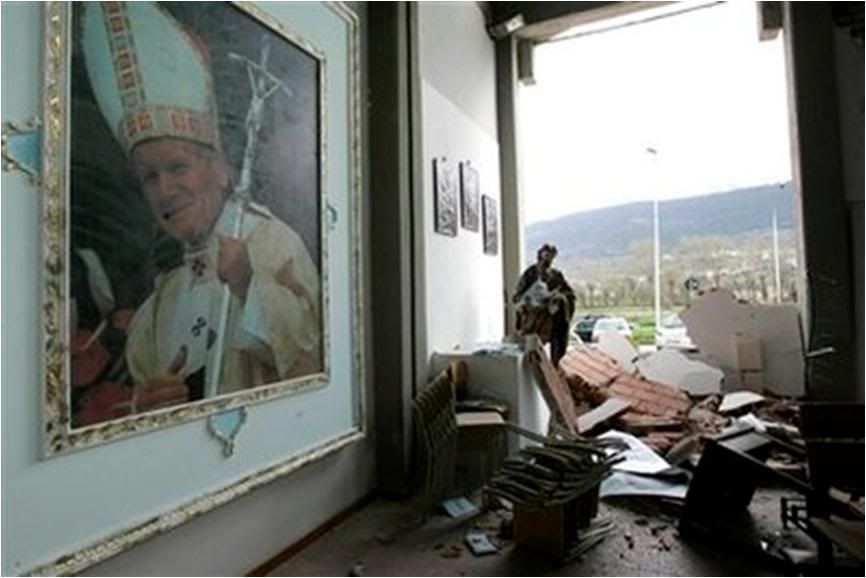 Quake-damaged church in Sant'elia, a village near L'Aquila, capital of the Abruzzo region and epicenter of the earthquake.
Maundy Thursday, April 7
Quake-damaged church in Sant'elia, a village near L'Aquila, capital of the Abruzzo region and epicenter of the earthquake.
Maundy Thursday, April 7
At the Chrismal Mass, the Holy Father blessed oils and chrism to be given to the Diocese of L'Aquila
which would be unable to carry out its usual Maudn Thursday blessing of the oils and chrism.
Good Friday, April 8
The Holy Father sent Cardinal Tarcisio Bertone to preside at the funeral Mass for the victims of the earthquake, along with his personal secretary, Mons. Georg Gaenswein.
Here is the account of that event.
 Pope urges earthquake survivors
Pope urges earthquake survivors
to keep up hope

L'AQUILA, Italy, April 10 (AP) – Pope Benedict XVI has urged quake-stricken people to have courage and keep up hope.
The Pope told the survivors that he felt "spiritually among you" and that he was sharing their anguish.
The message was read Friday by the Pope's secretary, Monsignor Georg Gaenswein, at the opening of a collective funeral for 205 victims of the quake.
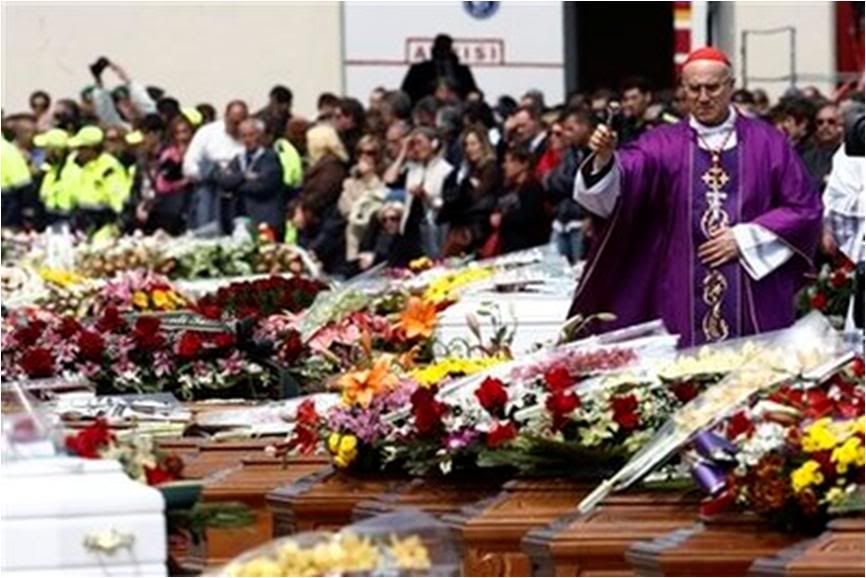
The Pope sent Cardinal Tarcisio Bertone, Vatican secretary of state, to preside at the funeral Mass.
Benedict plans to visit the quake area in the coming weeks.
The Vatican granted a special dispensation to hold a Mass on Good Friday, the only day on the Roman Catholic calendar on which Mass is not normally celebrated.
Cardinal Bertone and Mons. Gaenswein arriving in L'Aquila earlier today:

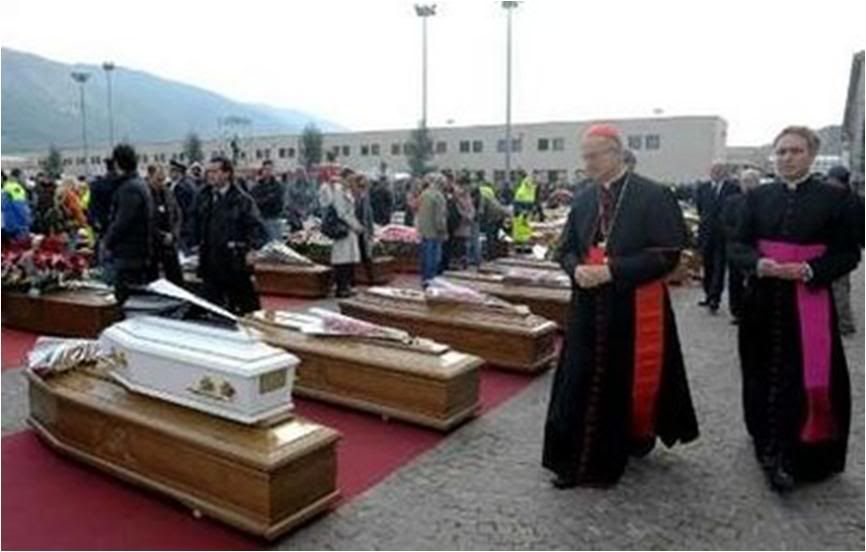 MESSAGE OF THE HOLY FATHER
MESSAGE OF THE HOLY FATHER
FOR THE FUNERAL MASS AT L'AQUILA
Translated from

Here is the text of the message sent by the Holy Father Benedict XVI to the Archbishop of L'Aquila, Mons. Giuseppe Molinari, which Mons. Georg Gaenswein read at the start of the funeral Mass for victims of the earthquake:
To my dear Archbishop Molinari and all of you,
dearest brothers and sisters in the Lord:
In these tragic time when an immense tragedy has fallen on your land, I feel myself spiritually present among you to share your anguish, to ask God to grant eternal rest to the victims, quick recovery for the injured, and for everyone, the courage to continue in hope without yielding to despondency.
I asked my Secretary of State to preside at this extraordinary liturgical celebration at which the Christian community gathers around their dead to give them the last farewell.
I entrust to him and to my private secretary the task of bringing you in person the expression of my sorrowful participation in the grief of those who mourn dear ones taken down by this disaster.
At moments like these, faith remains the source of light and hope, especially during these days which speak of the suffering of the Son of God who became man for us: May his passion, his death and his resurrection, be for all a fountain of comfort, and open the heart of each one to the contemplation of that life when "there shall be no more death or mourning, wailing or pain, (for) the old order has passed away" (Ap 21,4).
I am sure that with the commitment of everyone, we can face the most impelling necessities. The violence of the quake has created situations of singular difficulty.
I have followed the developments in this devastating telluric phenomenon from the first moments, which were felt even in the Vatican, and I have noted the growing wave of solidarity with which aid and rescue work have been organized, towards even more incisive actions by institutions of the State and the Church, as well as the private sector.
The Holy See intends to do its part, together with the parishes, religious institutions and lay organizations. This is the time for commitment and work, alongside the organisms of the state, whose work has been praiseworthy. Only solidarity will allow overcoming trials that are this sorrowful.
I entrust to the Blessed Virgin all the persons and families affected by this tragedy, and through her maternal intercession, I ask the Lord to wipe every tear and heal every wound, even as I send to each of you a special and comforting Apostolic Blessing.
From the Vatican
April 9, 2009

After reading the Pope's message, Mons. Gaenswein said the Holy Father had donated the chalice to be used in the Eucharistic Sacrifice as a sign of a more intense closeness to the pain and suffering of the earthquake victims.
The earlier AP story:
L'AQUILA, Italy (AP) — Grieving relatives collapsed over flower-draped caskets of the victims of Italy's worst earthquake in three decades as the nation joined in a day of mourning Friday.
The Vatican's secretary of state, Cardinal Tarcisio Bertone, was to preside over an exceptional Good Friday funeral Mass for about 200 victims, whose coffins were lined up on a vast military ground in the quake-stricken city of L'Aquila. Some of the 289 victims had already been buried privately.
Premier Silvio Berlusconi and other key government officials were among the 10,000 mourners expected for the outdoor ceremony beneath Abruzzo's snowcapped mountains. The funeral is being held outdoors because none of the region's churches is stable enough for the ceremony.
"Today will be a moment of great emotion. How can one not be moved by so much pain?" Berlusconi said, shortly before departing for L'Aquila for the funeral.
"These are our dead today, they are the dead of the whole nation," said the premier.
Volunteers guided mourners to the caskets of their loved ones. Each of the simple varnished wooden coffins, graced with either a cross or a crucifix and with a bouquet of flowers, bore a golden plaque with the name of the deceased, the dates of their birth and death.
Small white caskets holding the quake's youngest victims rested on larger coffins, presumably those of a parent or close relative. Berlusconi said 20 children and teenagers were among the dead.
A woman grieved over a casket draped in soccer jerseys and holding the silver-framed photo of a smiling young man with thick blond hair.
Inside the enormous hangar that has served as a makeshift morgue, dark-suited men reflected solemnly on the moment, gingerly touching several plain wooden caskets that remained there before the ceremony, as if in a final farewell.
The Vatican granted a special dispensation for the Mass. Good Friday, which marks Jesus' death by crucifixion, is the only day in the year on which Mass in not normally celebrated in the Roman Catholic Church.
"Today is a 'Via Crucis' for each of us," said Stefania Pezzopane, one of the top officials of this medieval city in central Italy. The "Via Crucis," or "Way of the Cross," is the procession held on Good Friday in commemoration of Jesus' suffering before crucifixion.
The 6.3-magnitude quake struck Monday at 3:32 a.m., catching many in their sleep. It collapsed buildings and reduced entire blocks to piles of rubble. L'Aquila was among the hardest hit, but the quake damaged some 26 towns in the central mountainous region of Abruzzo.
On Thursday, L'Aquila took a halting step toward normalcy as butchers, bakers and other shopkeepers reopened for business and firefighters began entering buildings to grab essential items for the homeless.
Aftershocks, including some strong ones, continued to rattle residents — nearly 18,000 of whom are living in tent camps around the stricken region. An additional 10,000 have been put up in seaside hotels, out of the quake zone, and the Italian railway provided heated sleeping cars at L'Aquila's main train station, where nearly 700 people spent the night.
Firefighters surveyed for damage as far away as Rome, 60 miles (100 kilometers) west of the quake's epicenter.
Here is the report from Vatican Radio:
Benedict XVI to earthquake survivors:
'God grant everyone the courage
to continue in hope'
Translated from
the Italian service of

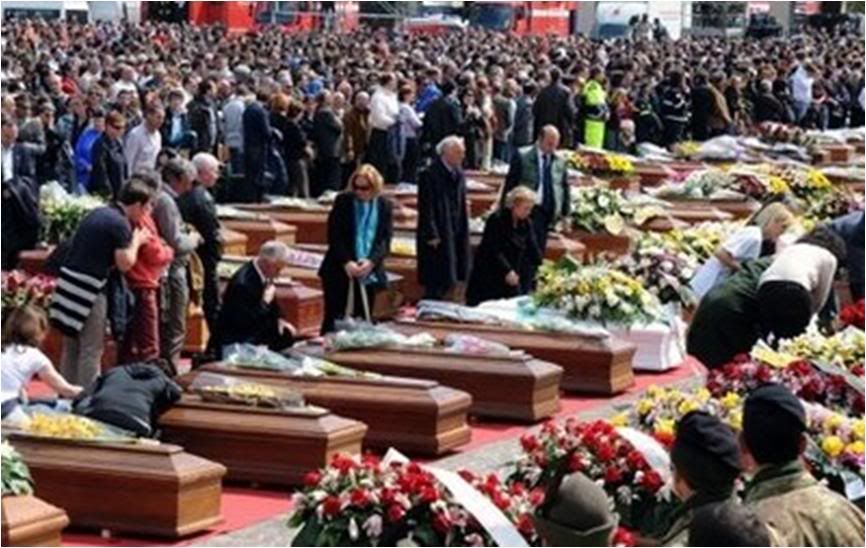
Two hundred fifty coffins - of 289 known deaths so far - laid down in four rows. This was the moving sight this morning at the Piazza D'Armi of the Italian Finance Guard's School for Inspectors at Coppito, near L'Aquila, at the state funeral for the victims of the recent earthquake.
Presiding at the rites in representation of Pope Benedict XVI was Cardinal Tarcisio Bertone, Secretary of State, who concelebrated with the Archbishop of L"Aquila, Mons Giuseppe Molinari, 18 other bishops from the stricken Abruzzo region and other regions of Italy, and the Pope's private secretary, Mons. Georg Gaenswein.
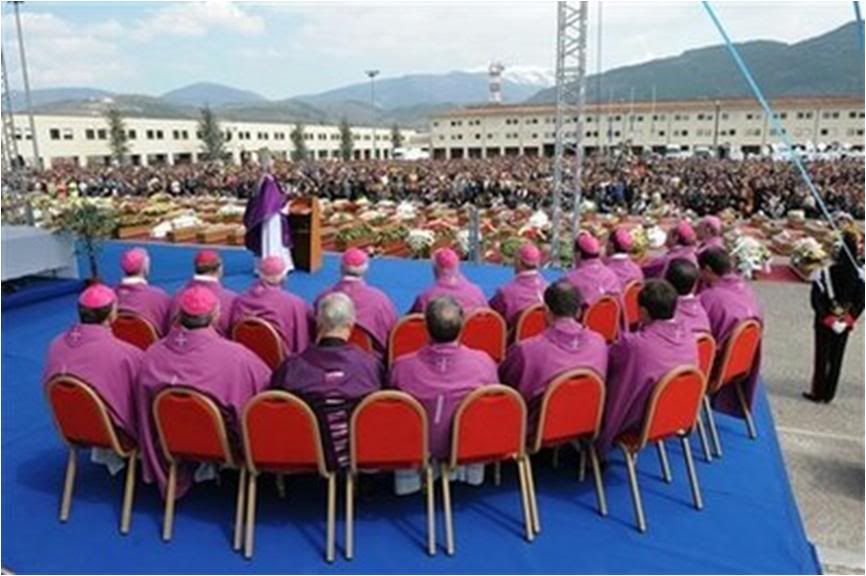
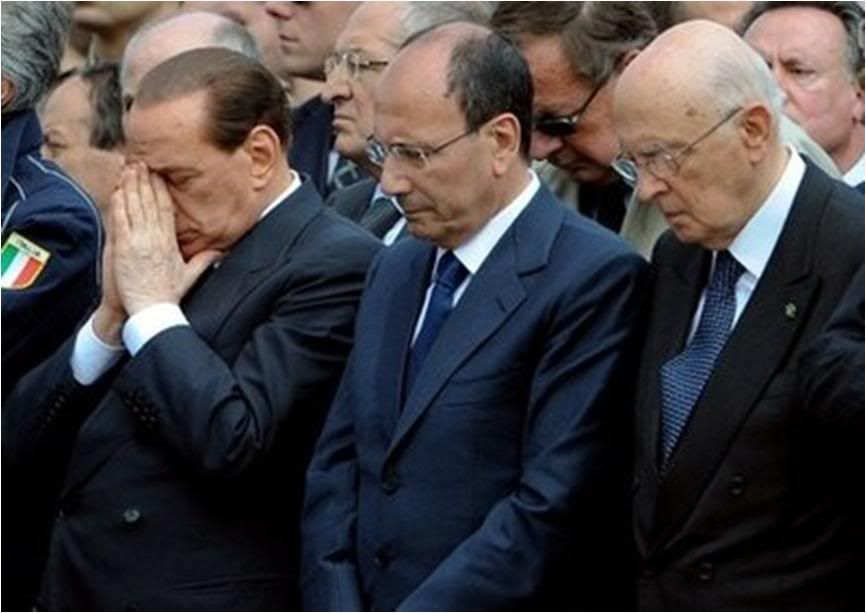
The highest Italian authorities were present, including the head of state, President Giorgio Napolitano, Prime Minister Silvio Berlusconi and the presidents of Italy's two chambers of Parliament.
Alessandro Carolis reports:
Two hours before the Mass began, the ceremony already had its icon of inconsolable grief - a mahogany coffin, lined up along the rest, upon which rested a small white one, a victim whose life was snuffed out too early.

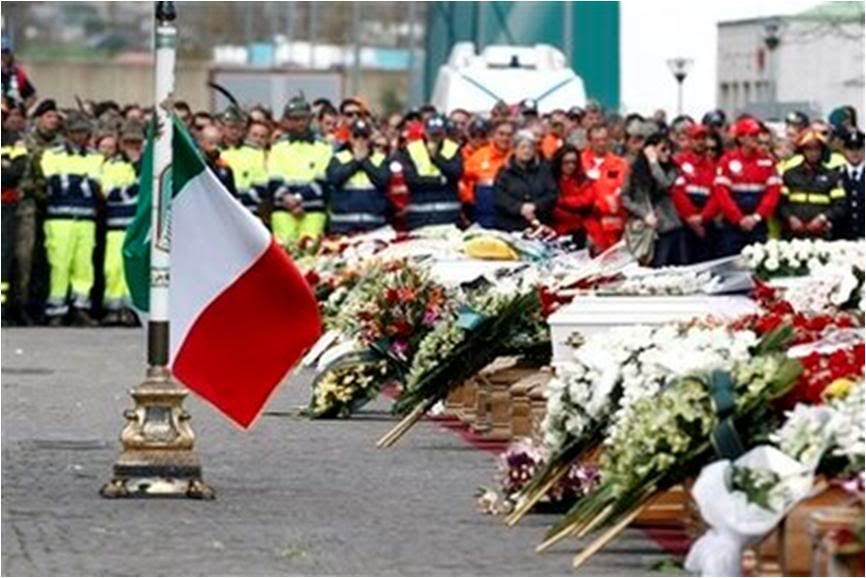
But it was not the only one of its kind. Another 4 little coffins were positioned that way, above or beside their mothers, a last contact instead of the embraces and caresses there would have been. But a killer quake at 3:32 in the morning of Monday has left ruin even in the hearts of those who survive.
Those five tiny coffins, more than anything, showed "the indecipherable enigma of dear', in the words of Cardinal Bertone, whom the Pope had sent along with his private secretary, in order to be near the living and the dead in this tragedy that has shaken not just Italy, whose grief the world shares.
Death is an enigma that signifies annihilation, 'an insuperable absence', except that the apparent 'silence of God' is the prelude, as Good Friday reminds us, to Resurrection, according to a message from Benedict XVI that was read by Mons. Gaenswein:
"At moments like these, faith remains the source of light and hope, especially during these days which speak of the suffering of the Son of God who became man for us: May his passion, his death and his resurrection, be for all a fountain of comfort, and open the heart of each one to the contemplation of that life when "there shall be no more death or mourning, wailing or pain, (for) the old order has passed away".
"I am sure that with the commitment of everyone, we can face the most impelling necessities," the Pope added, assuring the survivors that the Church, on every level, and in every way possible, will be with the institutions of the state on the front lines to assist them, just as 'the growing wave of solidarity' from rescue and aid teams has already shown.
Benedict XVI said he prays that everyone "may have the courage to continue in hope without yielding to despair".
Cardinal Bertone, in his homily, sought to accompany the grieving families' remembrance of their departed with great delicacy and respect.
He said that, just as it was to the Crucified Lord who felt abandoned on Calvary,
"God may seem absent, the pain may appear brutal and senseless, and the tears may obscure the timid rays of sunshine and spring. And yet, it is when we are provoked by the question, 'Where is your God now?', that we feel emerging from the depths the certainty of God's loving intervention."
In the silence of death, Cardinal Bertone said, the presence of God becomes 'a candle of hope'.
"Death makes us realize directly that in one instant everything can cease - dreams, plans, hopes. Everything ends, but love remains. God, who is love, remains. In this hour of profound sorrow and disorientation, the Word of God sustains our faith, comforts us, and assures us that nothing can annul the power of love."
The cardinal echoed the Pope's message in laying stress on the 'values of solidarity and brotherhood' which, he said, 'all of Italy', united to the victims of this tragedy, has once again shown it possesses in depth:
"Therefore, brothers and sisters, let us resume the journey, together with Mary, carrying together the pain of the insuperable absence of the departed, with a more assiduous, brotherly and loving presence among their families, who have become even more authentically our family, in the great family of the children of God.
"Thanks to the maternal assistance of Our Lady, let us try to draw from life an authentically Christian lesson of life. Supported by her intercession, we shall not fear the difficulties which lie before us".
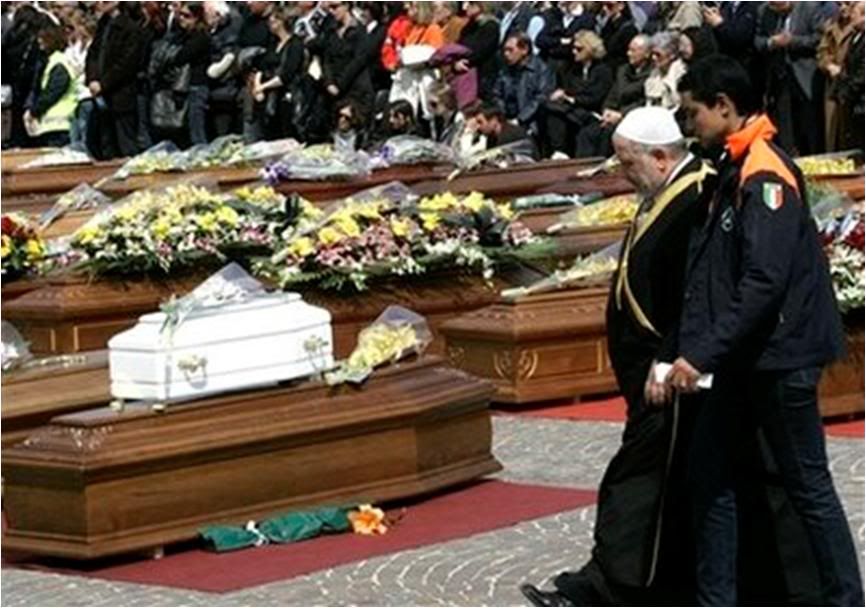
Those sentiments were echoed through a different religious sensibility by Imam Mohamed Nour Dacia, president of the Union of Islamic Communities, who offered prayers after the Mass for the six Muslims who died in the tragedy, and for all the other victims.
Beyond this sorrowful Good Friday is Easter, the glorious day of Resurrection, which, Cardinal Bertone wished, may bring comfort to all: "May Easter shine again from the ruins for a people who have so often been tried in your history."
Bishop Molinari gave the concluding words:
"Dear brothers and sisters, who have been struck by the loss of your dearest ones, it is a moment for great faith, as expressed to me by a father who lost two sons in this tragedy. A faith which is stronger than sorrow, than loss, than fear, doubt and despair... Lord, grant that from this insupportably absurd story of death may be born a new and luminous story of life and hope."
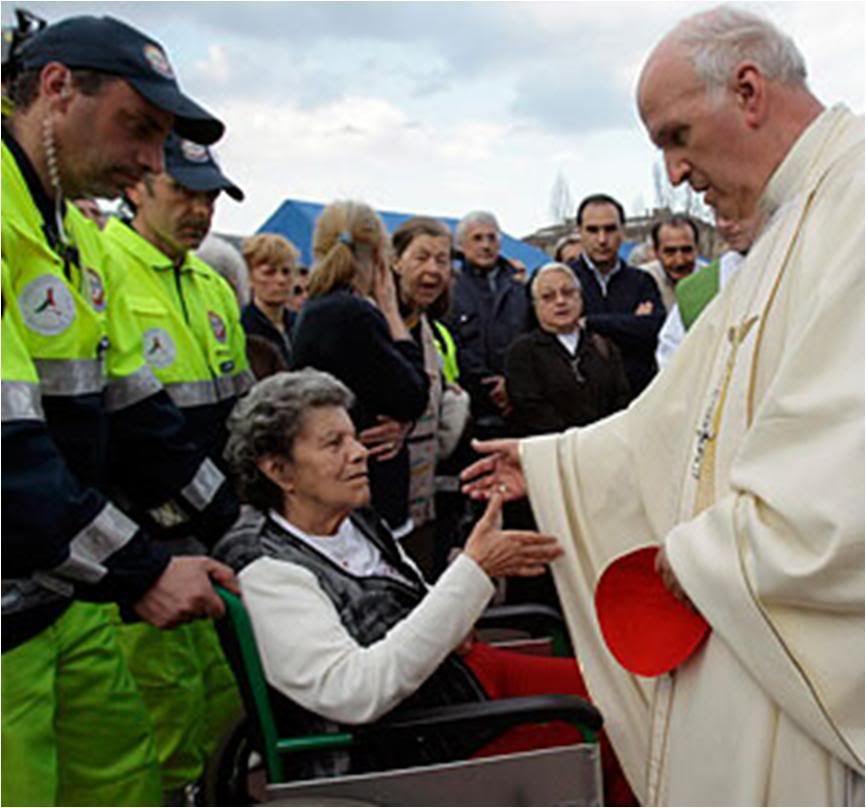
|
| |
|
| |
 31/05/2009 08:16 31/05/2009 08:16 |
|
| | | OFFLINE | | Post: 17.567
Post: 271 | Registrato il: 28/08/2005
Registrato il: 20/01/2009 | Administratore | Utente Junior | |
|
 In December 2008, three pastoral visits in Italy for 2009 were simukltaneously announced in the host dioceses, as follows:
PASTORAL VISITS IN 2009
In December 2008, three pastoral visits in Italy for 2009 were simukltaneously announced in the host dioceses, as follows:
PASTORAL VISITS IN 2009
BY THE PRIMATE OF ITALY
The three pastoral visits outside Rome announced for the Holy Father in 2009 are all in
central Italy, fairly near to Rome. Monte Cassino is 80 miles south; San Giovanni Rotondo
is 180 miles east; Viterbo is 40 miles north, with Bagnoregio 10 miles away.
Both Monte Cassino and Viterbo-Bagnoregio are in the Lazio region, where Rome is. And
San Giovanni Rotondo is at the northern top of Puglia, which the Pope has visited twice
before (Bari in 2005, Brindisi earlier this year).
 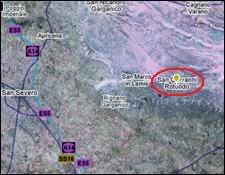 San Giovanni Rotondo does not appear on the large map but it is just a few miles directly to the east of San Severo, as the satellite photo shows.
The Italian service of
San Giovanni Rotondo does not appear on the large map but it is just a few miles directly to the east of San Severo, as the satellite photo shows.
The Italian service of
 has this interesting take on the places chosen.
has this interesting take on the places chosen.
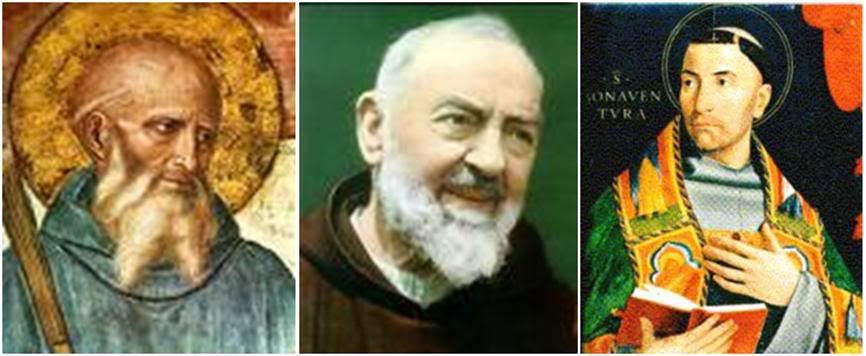
St. Benedict, St. Pio of Pietrelcina, and St. Bonaventure: Benedict XVI's announced pastoral visits in Italy next year will be under the aegis of the three saints associated with Montecassino, San Giovanni Rotondo and Viterbo-Bagnoregio, respectively.
The first visit will be to Montecassino and its famous abbey on May 24.

The abbot of Monte Cassino, dom Pietro Vittorelli (left photo, above), spoke to Alessandro Gisotti of the joy in the Benedictine community at the confirmation of the visit.
DOM VITTORELLI: The enthusiasm was uncontainable. I must say that I received so many manifestations of joy from the diocese, especially since this would come 29 years since a papal visit to Monte Cassino, and 5 years since the last visit of Cardinal Ratzinger who came here in November 2004. At that time, he celebrated a Mass for the Pontifical Academy of Sciences, and a few months later, he was elected Pope.
We know how Cardinal Ratzinger and now as Benedict XVI has always indicated St. Benedict as a model, especially for Europe today...
I met the Holy Father last on Sept. 20 in Castel Gandolfo. I had the chance to thank him personally for the beauty of the address he gave at the College des Bernardins in Paris, an address which was all woven through with the Benedictine monastic spirit.
He was speaking to the men of culture in France, but he was also addressing European culture in general in recalling the symbolic, historical and powerful significance that the Benedictine monks had in the construction of a post-barbarian Europe.
I believe that with this coming visit, the Pope will address the Benedictine world itself precisely to make us more conscious and responsible for this mission that we Benedictines have not only in Europe but in the world.

On June 21, the Pope will be in San Giovanni Rotondo, to pray before the remains of St. Padre Pio of Pietrelcina, which has been exposed since last April for public veneration.
Gratitude to the Pope was expressed by Mons. Domenico D'Ambrosio, Bishop of Manfredonia-Vieste-San Giovanni Rotondo (left photo, above).
MONS. D'AMBROSIO: It was, of course, the desire of the entire community, but above all, of the great family of devotees of every kind to Padre Pio. When I made the announcement last night at Church, the joy of everyone was visible, particularly Padre Pio's own brothers, the Capuchin monks.
And it is beautiful to have the Pope with us. His ministry is to confirm us in our faith. We need to feel validated in our commitment to the faith which here assumes a special character because of the spirituality and sanctity of padre Pio.
The Pope will also visit the hospital in San Giovanni Rotondo...
Of course. The hospital is the great materialization of Padre Pio's charity, and the Pope will give hope and encouragement to all those who are working in the example of St. Pio who made the hospital 'a temple of prayer and science'. [The saint's Casa di Sofferenze in San Giovanni Rotondo is recognized as one of Italy's finest hospitals offering tertiary (specialized) care.]

The third visit on September 6 will be to two small cities of Lazio - Viterbo and Bagnoregio. This is what Bishop Lorenzo Chiarinelli said:
MONS. CHIARINELLI: There was a great explosion of joy. The community feels the need to be confirmed in their faith. This encounter with the Supreme Pastor is a necessary experience of the Church which will be very beautiful.
We will be preparing the faithful along this line, not only within the Church, but also in the context of the diocesan territory. The civilian institutions are giving great resonance to the event.
Then there are our local cultural realities like the University, the theological institute we have expanded at Sant'Anselmo, the fact that people in the area strongly feel a link with the Successor of Peter. [Viterbo, one of the beautiful little walled cities of Italy, has a Palace of the Popes, since it was the seat of the Popes from 1257 to 1281, during which time five conclaves were held in Viterbo.]
The Pope will also be going to Bagnoregio, the birthplace of St. Bonaventure...
The figure and the work of St. Bonaventure are dear to this Pope, who is a scholar and theologian like the saint. His professorial qualification thesis in Germany was on his work. And just as he visited Pavia for St. Augustine, he said to me one day, "Bagnoregio, too, will be a reference point."
Additional info from Monte Cassino:
Pope asks all Benedictine abbots
and abbesses worldwide to join him
at Monte Cassino on May 24
Translated from

Dec. 9, 2008
Pope Benedict's visit to Monte Cassino will be historic for two reasons.
Announcing the visit of the Holy Father on May 24, Ascension Sunday, dom Pietro Vittorelli, the abbot, said the Pope had also asked him to convene all the abbots and abbesses of Benedictine monasteries around the world on that day so they could all pray together at the tomb of St. Benedict, one of Europe's patron saints.
"We will will celebrate Vespers together, and pray for the whole world," the abbot said, "It will truly be a uniquely special moment for the entire Benedictine order."
St. Benedict wrote the famous Rule of the order at Monte Cassino around 540. He died in the abbey in 547.
Dom Vittorelli also said that for the first time, a papal Mass at Monte Cassino will be celebrated in the open on the plain of Campo Miranda at the foot of the mountain.
He will proceed to tbe mountaintop abbey after the Mass.
"Benedict XVI comes to our Abbey 29 years after John Paul II made a visit," dom Pietro said, "and five years since his own visit here as a cardinal in November 2004, five months before he became Pope."

The Pope will also visit the Polish cemetery at the foot of the mountain to mark the 65th anniversary of the Allied bombings in World War II which resulted in the destruction of the abbey (fully reconstructed after the war and now a UNESCO World Heritage site).
During the visit, Benedict will also inuagurate the Casa della Carita, a center to help the most disadvantaged, established by the Roman Curia in what was a hospital in Cassino town. It will provide temporary shelter for homeless persons and other families in difficulty.
After the abbot's announcement of the Pope's visit, all the bells in all the parishes of the diocese pealed out for 15 minutes in celebration.
On April 9, another city was added to the Pope's Italian itinerary in 2009:
POPE ADDS BRESCIA
TO PASTORAL VISITS
IN ITALY THIS YEAR
April 9, 2009

At the end of his Chrismal Mass homily today, the Bishop of Brescia (in northern Italy), Mons. Luciano Monaro, made this announcement (translated here) which also appears on the site of the Diocese of Brescia:
I am happy to be able to officially make an announcement that is cause for joy among our priests and for the entire church of Brescia.
The Pope will come to visit us on November 8. Of course, the immediate reason is the 30th anniversary of the death of Paul VI. [A belated one, since the 30th anniversary was last year. on August 6.]
Papa Ratzinger, as you know, was crated a cardinal y Paul VI, and has always had great esteem and affection for our Brescian Pope.
The program will be defined by the Prefecture of the Papal Household and will be published in the next few weeks, but the significance of this visit is very clear. It will be a day of intense prayer and communion....
Earlier announced pastoral visits in Italy this year were to Cassino, San Giovanni Rotondo (Padre Pio shrine), and Viterbo-Bagnoregio - all of them fairly close to Rome. Brescia, on the other hand, is 60 miles east of Milan.
|
| |
 31/05/2009 08:26 31/05/2009 08:26 |
|
| | | OFFLINE | | Post: 17.568
Post: 272 | Registrato il: 28/08/2005
Registrato il: 20/01/2009 | Administratore | Utente Junior | |
|
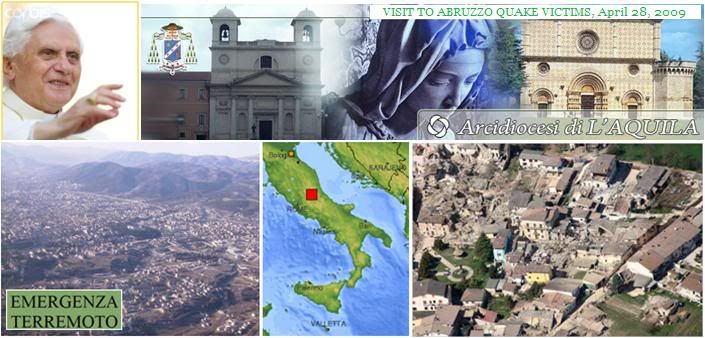 On April 20, 2009, the Vatican released the program for the Pope's visit to the Abruzzo.
VISIT OF THE HOLY FATHER
On April 20, 2009, the Vatican released the program for the Pope's visit to the Abruzzo.
VISIT OF THE HOLY FATHER
TO THE EARTHQUALE-AFFECTED AREA
IN ABRUZZO, April 28, 2009
PROGRAM
09.00 Departure from the Vatican heliport.
09.30 Arrival at landing zone near the Onna temporary shelter.
VISIT WITH THE VICTIMS
Greeting from the Holy Father
and Prayer for the Dead
10.00 Departure for L'Aquila city center by car.
VISIT TO TBE DAMAGED BASILICA OF COLLEMAGGIO
The Holy Father will venerate the urn of Pope Celestine V
and will leave a Pontifical Pallium in homage.
BRIEF VISIT TO THE DAMAGED STUDENT HOUSING
Meeting with student representatives.
10:45 Arrival at the Finance Guard barracks in Coppito
THE HOLY FATHER GREETS THE MAYORS AND PARISH PRIESTS
of the towns most severely affected by the earthquake.
11.00 MEETING WITH THE FAITHFUL AND AID AND RESCUE PERSONNEL
(Volunteers, Civil Protection, Military, Firemen, Health Workers, etc)
- Greeting by Mons. Giuseppe Molinari, Archbishop of L'Aquila
- Greeting by the Hon. Massimo Cialente, Mayor of L’Aquila.
- Address and Prayer by the Holy Father
- Recital of the Regina Caeli.
(This will be done in front of the statue of the Madonna di Roio*,
also known as Our Lady of La Croce, before which the Holy Father
will offer a Golden Rose.)
- Greeting by the Holy Father to all the representatives of various categories
involved in the recovery work.
12.00 Departure by helicopter from Coppito.
The Holy Father will be flown over the earthquake zone
to see the extent of the damage.
13.00 Arrival at the Vatican heliport,
* I had to look up information about the Madonna di Roio, and it is one of those fascinating stories that abound in religious literature, but I have not found any references in English.
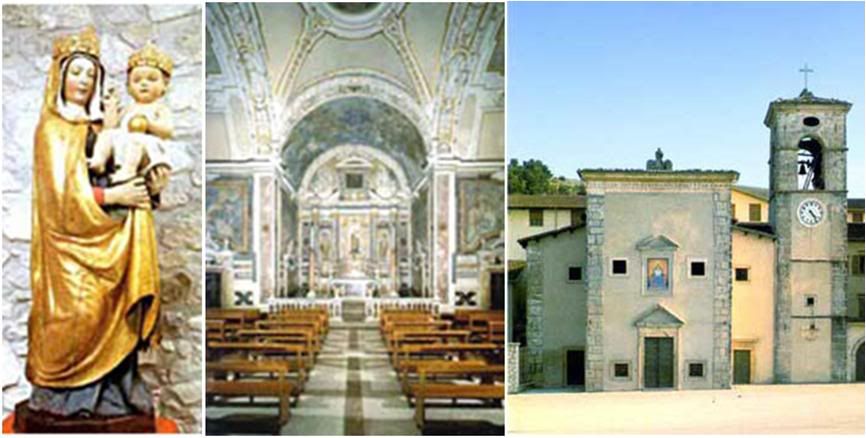 The image and the sanctuary in Poggio di Roio, a village of L'Aquila.
The image itself is a lifesize wooden statue dating to the 14th century, but the story goes that it was found in 1548 by a shepherd from Abruzzo who was pasturing sheep in neighboring Puglia where it was the custom to bring the flocks in winter.
The image and the sanctuary in Poggio di Roio, a village of L'Aquila.
The image itself is a lifesize wooden statue dating to the 14th century, but the story goes that it was found in 1548 by a shepherd from Abruzzo who was pasturing sheep in neighboring Puglia where it was the custom to bring the flocks in winter.
The shepherd lost one of the flocks he was grazing and prayed to the Virgin to help him in his plight. She appeared to him with the Baby Jesus in her arms, telling him where his sheep had found refuge. Going back to the site of the apparition later with other shepherds to whom he told the story, it is said they found the statue.
With the warmer weather, they headed back to the Abruzzo, bringing the statue home with them, on a mule. Nearing their destination, the mule suddenly dropped to its knees just opposite a Cross in front of the Castle of Roio and refused to go farther. So they took the statue on their shoulders and carried it to the nearby Abbey of St. John. The following day, to their surprise, the statue was no longer there - the people of Roio found it in front of the Cross where the mule had stopped. They gratefully took custody of it and eventually built a sanctuary for it.
 |
| |
 31/05/2009 08:44 31/05/2009 08:44 |
|
| | | OFFLINE | | Post: 17.569
Post: 273 | Registrato il: 28/08/2005
Registrato il: 20/01/2009 | Administratore | Utente Junior | |
|
 THE POPE'S VISIT TO THE ABRUZZO
THE POPE'S VISIT TO THE ABRUZZO
April 28, 2009
AT THE ONNA 'TENT CITY'
The Holy Father left the Vatican at 9:00 to visit the earthquake-hit zone of the Abruzzo. Because of bad weather, he travelled by car instead of by helicopter as originally planned. He arrived in Onna at 10:30, where he met with the homeless victims temporarily sheltered there.

 Pope visits quake victims
Pope visits quake victims

ROME, Italy, April 28 (CNN) -- Pope Benedict XVI met with survivors and offered prayers Tuesday as he visited towns hit hard in this month's Italian earthquake.
The Pope flew by helicopter from Vatican City to a tent camp near the village of Onna, where he led a prayer in the cold and rainy weather for the hundreds killed in the April 6 quake. .
The camp houses hundreds of families left homeless when the magnitude-6.3 quake destroyed their homes. Residents there welcomed the Pope, who kissed and hugged some of the children.
"I have come here personally to this splendid and hurt land of yours, which is living days of great pain and precariousness, to express in the most direct way my kind closeness," the P ope told residents. "I've followed the news with apprehension, sharing with you your consternation ... for the dead, along with your anxious worries about how much you've lost in a brief moment.
"I am now here with you and would like to hug each one of you with affection," he said. "The Church is all here with me, near your suffering."
The Pope then headed to the town of L'Aquila, near the epicenter. He planned to stop in the town's most venerated church, the 13th-century Basilica of Collemaggio, whose dome collapsed in the earthquake.
The basilica is the biggest in the surrounding Abruzzo region and is the burial place for Pope Celestine V, who has been interred there since 1327. Pope Benedict planned to kneel in prayer in front of Celestine's urn, the Vatican said.
The earthquake struck early in the morning, as many people slept. Nearly 300 people were killed and tens of thousands left homeless.
Eight of the victims died in a dormitory of the University of L'Aquila. The Pope visited the site of the dorm, then proceeded to the school of the Finance Police, in the small town of Coppito, about 4 kilometers (2.5 miles) from L'Aquila.
The Pope went there along with L'Aquila Mayor Massimo Cialente and Archbishop Giuseppe Mulinare and thanked the volunteers, rescue workers, and emergency workers who have helped in the wake of the disaster.
"It was especially moving to pray in front of the student house, where not a few young lives were destroyed by the earthquake violence," the pope said. "Going through the city, I have realized further how grave the earthquake consequences have been."
A few hundred people, including many rescue workers, were in the crowd. The Finance Guard school has been turned into the headquarters of the government's Civil Protection Agency, which is handling the emergency response and reconstruction in the quake zone.
Among those in the crowd was Tonino Risdonna, a resident of the small village of Tempera, near L'Aquila. Risdonna said he is too scared to return to his house, which was damaged by the quake, and that he won't go back until there have been no earthquakes for at least two or three months.
Risdonna said he came to see the Pope because "it is an emotional experience" that helps him release his "sorrow and tension."
Another man who lost two houses in the nearby town of Paganica and is now living in a tent said he came to hear the Pope because he "brings a word of comfort and a message of hope."
Meanwhile, Italian Prime Minister Silvio Berlusconi has said he plans to host a meeting of the G-8 in July at the school, an idea that is drawing mixed reactions in the area.
Risdonna, however, said he likes the idea because "it will put L'Aquila in the spotlight, and this will help uplift spirits and also bring some economic help."

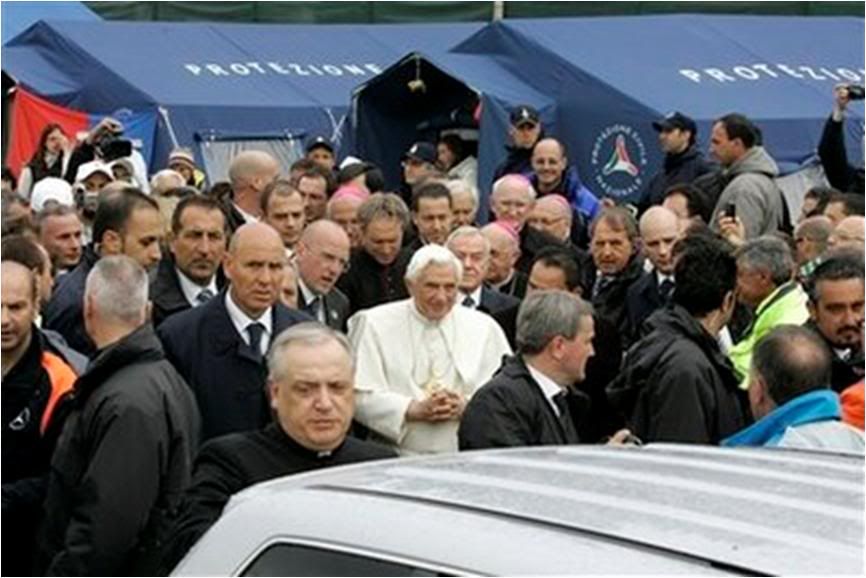
 Here is a translation of the Pope's words before he led the community in a prayer, and of the prayer itself:
THE POPE'S REMARKS AND PRAYER
Here is a translation of the Pope's words before he led the community in a prayer, and of the prayer itself:
THE POPE'S REMARKS AND PRAYER
Dear friends:
I have come in person to your splendid but wounded land which is living through days of great sorrow and precariousness, in order to express to you in the most direct way my heartfelt closeness.
I have bean close to you from the first moment, as soon as I learned thews of the violent earthquake which claimed almost 300 victims that night of April 6, along with numerous injured persons and great material damage to your homes.
I have been following the news closely, sharing your perplexity and your tears for tHE dead, as well as your fearful concern over all that you lost in one instant.
Now I am here with you: I would like to embrace you all, one by one, with affection. The entire Church is with me, alongside you in all your suffering, sharing your pain for the loss of family and friends, and desirous to help you rebuild your homes and churches and businesses that have collapsed or were gravely damaged by the earthquake.
I have admired and continue to admire the courage, dignity and faith with which you have faced this hard trial, showing great will not to fall down in the face of adversity.
Indeed, it is not the first earthquake that your land has known, but now, as in the past, you have not given in - you have not lost your spirits. There is in you a strength of the will that inspires hope. A saying dear to your elders becomes very relevant: "There are still so many days behind the Gran Sasso" [the great mountain chain that is the main geographic feature of the Abruzzo].
Arriving here, in Onna, one of the centers that has paid very highly in terms of human lives, I can imagine all the sorrow and suffering that you have had to bear these past few weeks.
If it were possible, I would have wanted to visit every town and every neighborhood, to visit all the temporary shelters and to be able to meet everyone.
I am very well aware that despite the great commitment of solidarity shown to you from everywhere, living outside your own homes, in tents, or in your cars, brings so many daily discomforts, especially because of the cold and the rain.
I think also of all the young people who have suddenly been forced to measure themselves against grim reality, to the boys and girls who have had to interrupt their schooling, and the older people whose daily routine has been disrupted.
One could say, dear friends, that you find yourselves somewhat in the state of mind of those two disciples at Emmaus, about whom the evangelist Luke narrates.
After the tragic event of the Cross, they were going back home, disappointed and quite bitter at the 'end' to which Jesus came. It seemed there was no hope left, that God had hidden himself and was no longer present in the world.
But, on the way, He joined up with them and started conversing with them. Even if they did not recognize him with their eyes, something was 'awakened' in their hearts: the words of that 'unknown man' rekindled in them the ardor and the faith that the experience of Calvary had extinguished.
And so, my dear friends, my presence among you today is simply a tangible sign of the fact that the Crucified Lord lives: he is with us, he rose again, and does not forget us and will never abandon us.
He will not leave your questions about the future unanswered. He is not deaf to the anguished cries of so many families who have lost everything: their homes, their savings, their work, and for some, even their loved ones.
Of course, his concrete response will come through our solidarity, which cannot be limited to the initial emergency but should become a plan that is stable and concrete in time. I encourage everyone - institutions and businesses -in their work to make this land rise again.
The Pope is hear today, among you, to give you a comforting word as well about those who died: they live in God now and expect from you a testimony of courage and hope. They hope to see this land be born again, to be adorned once more with homes and churches that are beautiful and solid.
And it is precisely in the name of these brothers and sisters that you must commit yourself to living, availing of that which does not die and which the earthquake has not destroyed and cannot destroy: love.
Love remains even beyond the abyss of our precarious earthly existence, because true love is God, and in God, whoever loves, wins over death and knows he does not really lose those he has loved.
I wish to conclude my words by addressing to the Lord a special prayer for the victims of the earthquake:
We entrust all our dear ones to You, Lord,
knowing that you do not take away life from those you love but transform it,
and that at the moment when our mortal dwelling
during our exile on earth is destroyed,
you are preparing an eternal and immortal one for us in paradise.
Holy Father, Lord of heaven and earth,
listen to the cry of sorrow and hope
that rises from this community so sorely tried by the earthquake.
It is the silent cry of mothers, fathers, young people
and even of the tiny innocents who have left this earth.
They have been torn away from their loved ones -
welcome them all to your peace, oh Lord, who is God-with-us -
the Love capable of giving life without end.
We need You and your strength
because we feel small and fragile in the face of death.
We pray to you, help us, because only your support
can make us rise again and lead us to recover together,
holding each of us, trustingly, by the hand along the path of life.
We ask this of you through Jesus Christ, our Savior,
in whom the hope of blessed Resurrection shines. Amen.
Now, let us pray together the prayer our Lord taught us.
[ Our Father....]
The Holy Father imparted his blessing, and then added:
My prayers are with you. We are all together, and the Lord will help us. thank you for your courage, your faith aND your hope.
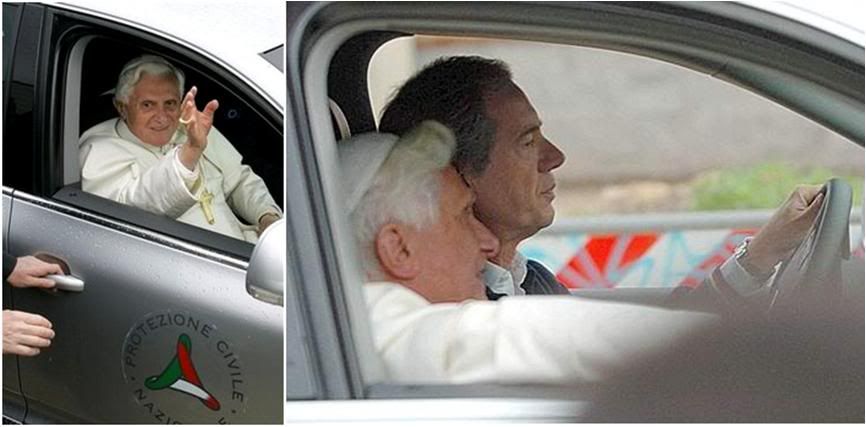
He then proceeded to look at some of the ruins of the village,. and at 11:15, proceeded by car to L'Aquila, where he first visited the Basilica at Collemaggio.

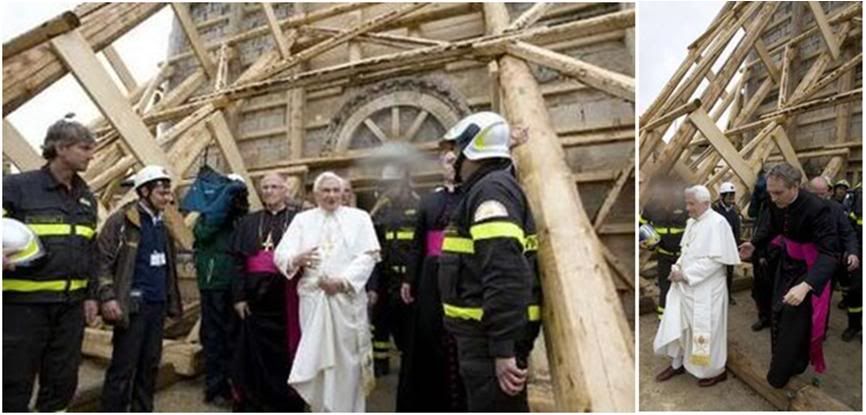 IN COLLEMAGGIO
IN COLLEMAGGIO
Welcomed by the Rector, Don Nunzio Spinelli, the Pope entered through the Holy Door and venerated the urn of Pope Celestine V, leaving behind in tribute the pallium which was imposed on him at the Inaugural Mass of his Pontificate.
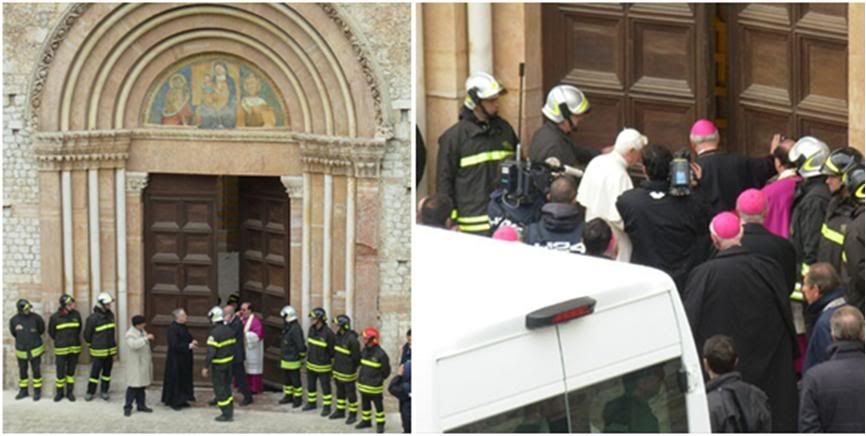
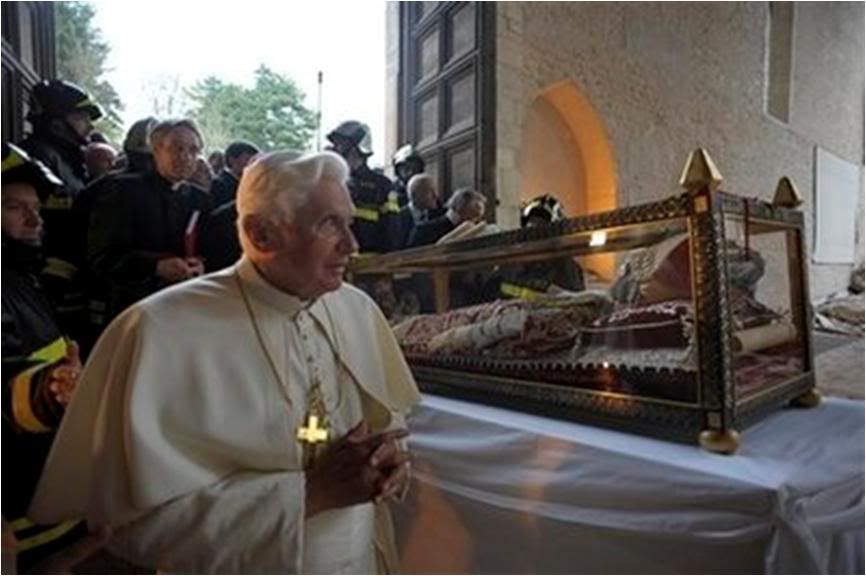
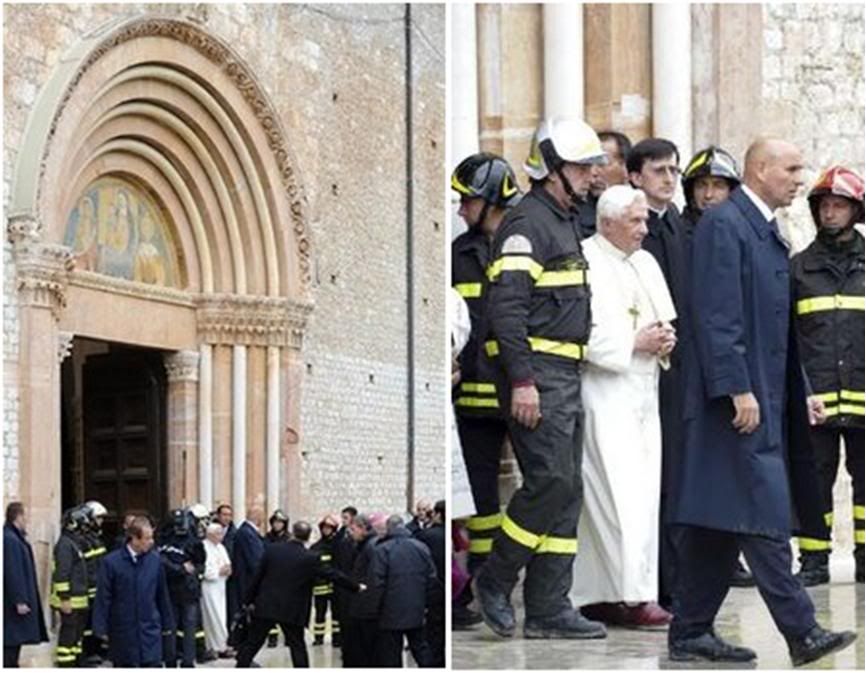 AT STUDENT DORM
AT STUDENT DORM
Shortly after 11:30, the Pope arrived in the vicinity of the House of Students serving the University of L'Aquila. Eight students died when the dorm building collapsed. The Pope spoke to the firemen who had been on the scene and to twelve students who represented the student body.
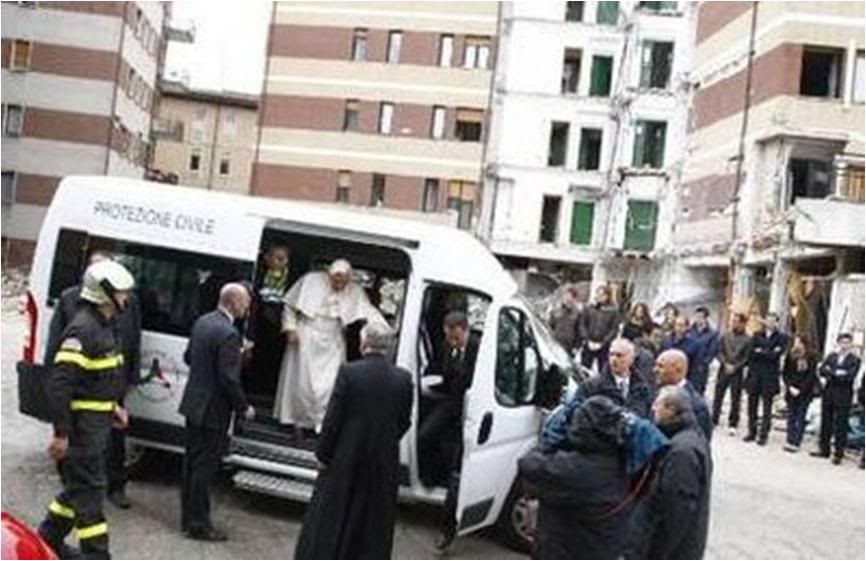

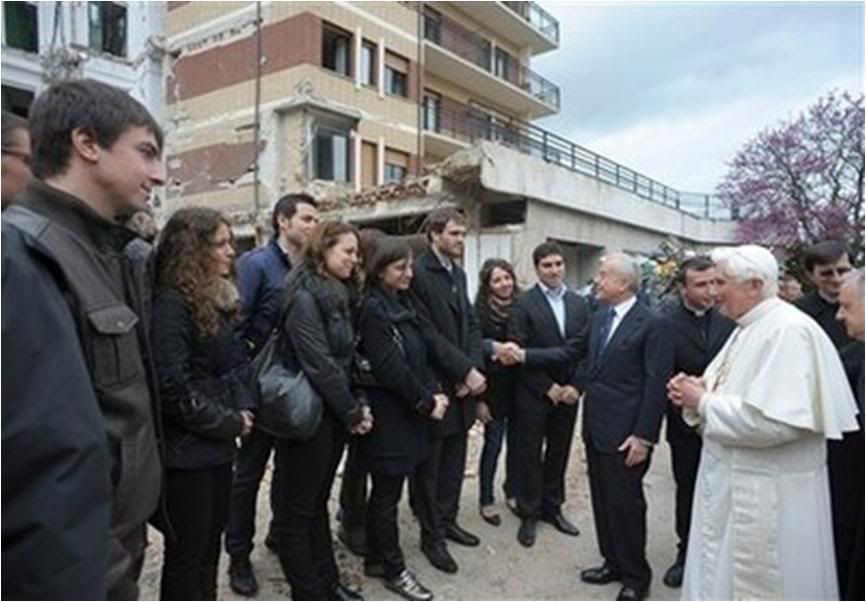
From L'Aquila, the Pope was driven to the Finance Guard School in Coppito to meet with the mayors and parish priests of the 69 towns most severely affected by the earthquake.
Afterwards, in the parade ground, where the funeral Mass had been held on Good Friday for the earthquake victims, the Pope addressed policemen, firemen, healthcare workers, and volunteers who have been working to help the victims. [ Photos and story in the next post.]
Pope hears quake victims' 'silent cry'
By Philip Pullella

L'AQUILA, Italy, April 28 (Reuters) – Pope Benedict comforted survivors of Italy's earthquake Tuesday and asked God to heed the "silent cry" of its victims rising from the earth.
During a four-hour visit to the central Italian region devastated on April 6, he called for a "serious examination of conscience" about the destruction caused by the quake, some of which has been blamed on shoddy construction.
The Pope visited a tent city and consoled survivors, many of whom lost everything in the quake that killed nearly 300 people and left some 63,000 homeless.
In the regional capital of L'Aquila, which took the brunt of the tremor, he visited the destroyed basilica and prayed at the ruins of the university dormitory where eight students died.
L'Aquila means eagle in Italian and the Pope said: "This way, L'Aquila, even though it is wounded, will be able to fly again."
Speaking to officials and volunteers in the grounds of a police academy that has become the headquarters for relief efforts, the Pope touched on one of the most controversial issues arising from the disaster.
Magistrates have opened investigations into why some modern buildings, including L'Aquila hospital, were severely damaged even though they were supposed to have been built according to strict anti-quake regulations.
"There has to be a serious examination of conscience so that the level of responsibility, at any moment, is not lacking," he said to applause.
Investigators suspect that inferior quality sand and steel may have been used in some of the recent construction by builders who wanted to save money.
Benedict began his visit in the devastated village of Onna. Bad weather forced him to scrap plans to fly by helicopter to the area east of Rome and he was driven instead to the village that has been left completely uninhabitable.
Speaking under a light drizzle in a tent town for Onna's survivors, he read a haunting prayer: "It is the silent cry of the blood of mothers, fathers, little innocent children that rises up from this earth."
In a tent where the villagers of Onna brought broken statues and religious paintings damaged in the quake, residents prayed in what is now their church.
"It's difficult to pray in a tent but we do it with so much love," said Giovanni Paoletti, 48, who lost his mother-in-law and nephew.
"We hope to be able to return to the old church, to bring these statues back to where they belong. We dream of a normal life, to start living again."
NB: I found this paragraph in the AFP account of the Pope's visit questionable:
At a tent camp near L'Aquila, some people were critical of the pope for waiting three weeks before visiting the region. "Everyone came except him," Giovani Nobile told AFP. "It's been 22 days that we've been in the tents. I expected him at least at the funeral."
Not that some people would not feel that way and say so, but that AFP would report it without adding the simple statement that the Vatican had explained from the beginning that the Pope did not wish his visit to get in the way of urgent rescue, recovery and aid efforts, as his visit would inevitably, because of all the necessary organizational and security preparations necessary when the Pope visits anywhere outside the Vatican.
In this case, there was also concern because 1) aftershocks continued for several days after the first episode could conceivably expose the Pope to unnecessary risk; and 2) the earthquake took place right at the start of Holy Week, which is traditionally the most demanding time of year for the Pope to preside at a number of liturgies, which do take their physical toll especially on an 82-year-old.
Also, John Paul II did not visit Assisi till three months after the earthquake of 1996, for the same practical reasons that kept Benedict XVI from being in the Abruzzo earlier. I'm sure both Popes would have wanted to be on the spot ASAP, but they are not first-aid workers, and they do not need to be physically present to provide their moral support and their prayers.
P.S. The following AP report, towards the end of the piece, refers to this issue:
Pope demands soul-searching
after Italy quake
By NICOLE WINFIELD

L'AQUILA, Italy, April 28 (AP) Pope Benedict XVI visited the scene of Italy's earthquake Tuesday to comfort survivors and demand "serious soul-searching" from those responsible for the shoddy construction blamed for many of the deaths.
Benedict visited a tent camp, a basilica and a university dormitory whose collapse epitomized the anguish of L'Aquila, a city of 70,000, and spurred criminal investigations into who was to blame for so many of the nearly 300 deaths in the 6.3-magnitude quake.
"As a civil community, some serious soul-searching is necessary, so that at any moment responsibilities never fail," the Pope told survivors and rescue workers during his first visit to the disaster site. "If this happens, L'Aquila - though wounded - will be able to fly again," Benedict said, referring to the city's name, eagle.
The April 6 quake claimed 296 lives in the dozens of towns and villages in the Abruzzo region of central Italy affected. About 50,000 people were driven from their homes, and thousands of buildings were toppled or heavily damaged.
Prosecutors have opened an investigation into the shoddy construction blamed for many of the building collapses, looking into both the construction work and materials used amid allegations that sea sand was illegally mixed with cement, corroding it and weakening it.
The Pope's first stop was the tiny hamlet of Onna, which was leveled by the temblor, and where around 40 of its 300 residents were killed. Some 267 survivors live in a handful of tents clustered in a parking lot left muddy by a steady rain that fell as the Pope arrived.
The pontiff kissed a baby held up to him by his mother, and held the hands of many of the homeless who gathered for the intimate, brief visit.
" Had it been possible, I would have liked to visit each village, each neighborhood, go to each tent camp and meet everyone," the Pope told them, standing on a makeshift stage in front of a tent, a few hundred survivors just steps a way.
He appealed to government institutions and companies to turn the relief work into a long-term project for quality rebuilding.
The victims, the pope said, "are waiting to see the rebirth of their land, which must go back to be adorned with beautiful and solid homes and churches."
In L'Aquila, the regional capital, Benedict met with a dozen students outside what remains of L'Aquila's collapsed university dormitory, for days a main focal point of grief as rescue workers searched the debris for students trapped inside. Seven died at the site.
The students knelt before the pope and kissed his hand, some visibly emotional. One gave him a letter.
The dorm is one of the focal points of prosecutors' investigations, as well as L'Aquila's hospital, both of which were built after seismic standards in this quake-prone region were raised.
The Pontiff also visited the ruins of the 13th-century Santa Maria di Collemaggio basilica, the symbol of the city whose roof partially caved in during the quake.
Rubble was piled up inside the church and pillars were covered to support them as the Pope entered the ruins, firefighters by his side. The Pontiff prayed before the salvaged remains of Pope Celestine V, the 13th-century hermit and saint who was the only Pope to resign.
The Rev. Nunzio Spinelli, rector of the basilica, quoted the Pope as saying, "Now that I see the destruction with my own eyes I can see that it is even worse than I had imagined."
The Pontiff had been scheduled to fly to the area by helicopter, but heavy winds and rains forced the Vatican to scrap that plan. Benedict was driven instead, but by the time his speech was concluded in Onna, a strong sun had broken through the clouds.
"Imagine the Pope, coming to this village," marveled Concetta De Angelis, tears in her eyes just moments after the pope greeted her in Onna. "A Pope has never come here. This village isn't even on the map!"
Her friend, Silvana Paolucci, was even more emotional, saying she had wept as soon as she was face-to-face with the Pontiff. "He embraced us, he touched my cheek. It was beautiful," said Paolucci, who lost an aunt and nephew in the quake and whose home was rendered uninhabitable.
Among the civil protection workers greeting the Pope was Germana D'Onofrio, who cooks meals for the homeless. "I feed the body and the pope feeds the spirit," she said.
Benedict had said he had wanted to visit the area sooner, but didn't want to interfere with relief work.
In 1980 Pope John Paul II traveled to Naples almost immediately after a devastating quake - a visit that was criticized because the heavy security arrangements complicated rescue work. After the 1997 quake in Umbria, John Paul waited over three months before visiting the area.
Volunteer civil protection member Gianpiero Trulli, tending to the homeless in Onna, said the Pope's visit had slightly increased the workload of the relief workers. But he said he understood the significance of the visit for the survivors' spirits.
"For them, it's important that the Church is here," he said.
[Modificato da TERESA BENEDETTA 12/06/2009 03:09] |
| |
 31/05/2009 08:55 31/05/2009 08:55 |
|
| | | OFFLINE | | Post: 17.570
Post: 274 | Registrato il: 28/08/2005
Registrato il: 20/01/2009 | Administratore | Utente Junior | |
|
 VISIT TO ABRUZZO - II
VISIT TO ABRUZZO - II
April 28, 2008
There were as many pictures filed by the news agencies for the Holy Father's four-hour visit to Abruzzo as there are for a daylong pastoral visit, so until I can organize the rest of the photos (at the Onna camp, aat the student dorm, and at theFinance Guard school, I am posting first the two religious highlights of the visit - a rare conjunction and perhaps the first time it has occured: the Pope's visit to the remains of a predecessor buried outside Rome and offering the papal Golden Rose to a regional Madonna though not at her own shrine.
TRIBUTE TO ST. CELESTINE V
BASILICA OF COLLEMAGGIO

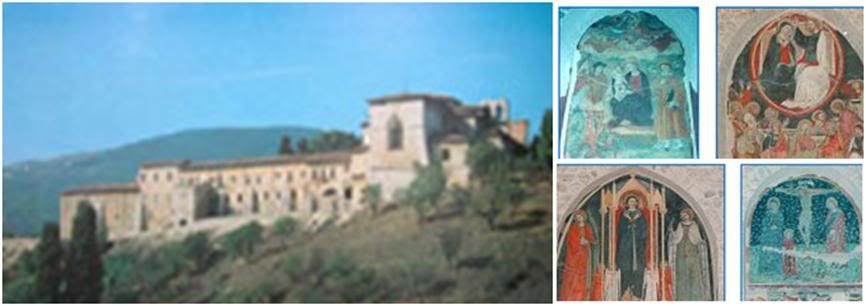 S. Maria di Collemaggio is a large medieval church in L'Aquila, built in 1287, and celebrated not only for its architecture, but also as the site of the original Papal Jubilee, a penitential observation devised by Pope Celestine V (1215-1296), who was crowned as Pope here and is buried here. The Church is a basilica because of its importance in religious history.
S. Maria di Collemaggio is a large medieval church in L'Aquila, built in 1287, and celebrated not only for its architecture, but also as the site of the original Papal Jubilee, a penitential observation devised by Pope Celestine V (1215-1296), who was crowned as Pope here and is buried here. The Church is a basilica because of its importance in religious history.
The church is a masterpiece of Abruzzese Romanesque and Gothic architecture and one of the chief sights of L'Aquila. The striking jewel-box effect of the exterior is due to a pattern of blocks of alternating pink and white stone; the interior, on the other hand, is massive and austere. Outbuildings include a colonnaded cloister, with the central fountain typical of many other similar Italian cloisters, and the former monastic refectory.
The Basilica was given Gothic embellishments during the 15th century, but a major restoration, completed in 1972, restored the Romanesque elements of the Basilica.
Right photo below showing the collapsed dome of the Basilica does not indicate the extent of the structural damage to the church interior.

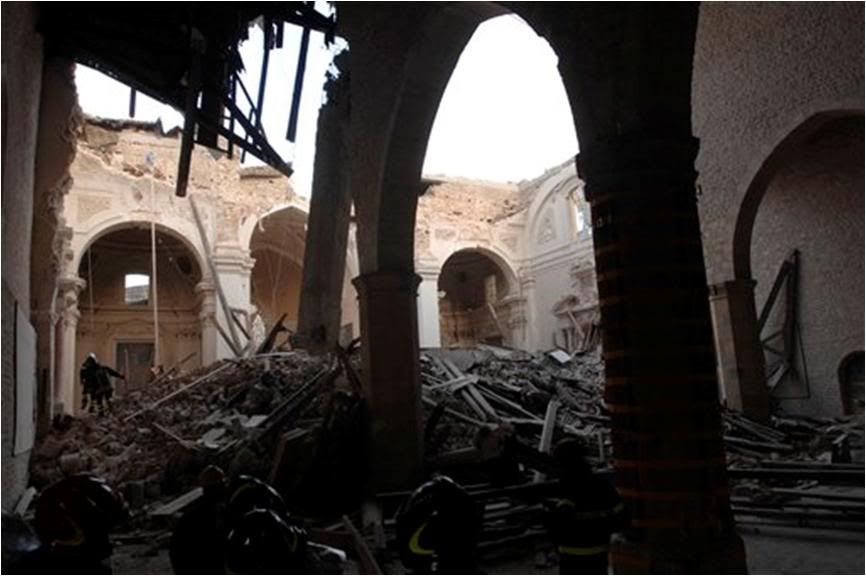 Collemaggio's renowned facade (pre-earthquake photo) appears to have survived fairly intact. None of the news agency photos taken yesterday showed the full facade.
Collemaggio's renowned facade (pre-earthquake photo) appears to have survived fairly intact. None of the news agency photos taken yesterday showed the full facade.
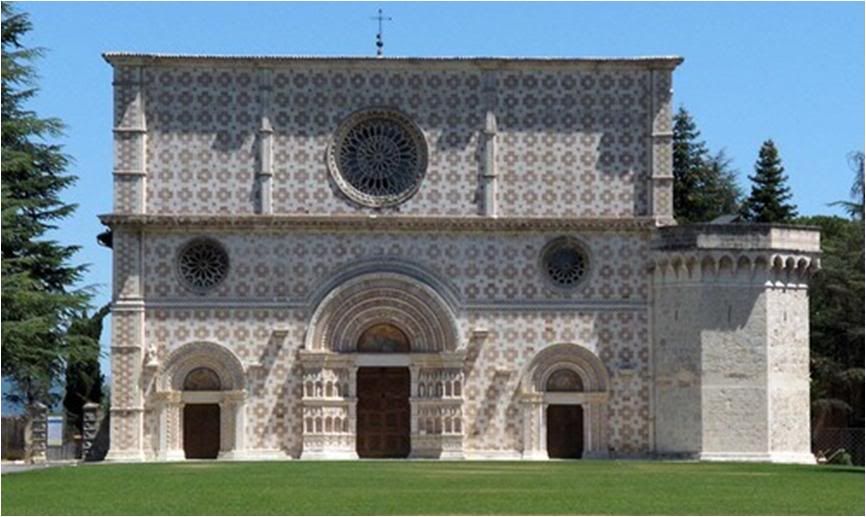 St. Celestine V in the chapel dedicated to him on the right side of the nave. His urn survived the quake.
St. Celestine V in the chapel dedicated to him on the right side of the nave. His urn survived the quake.
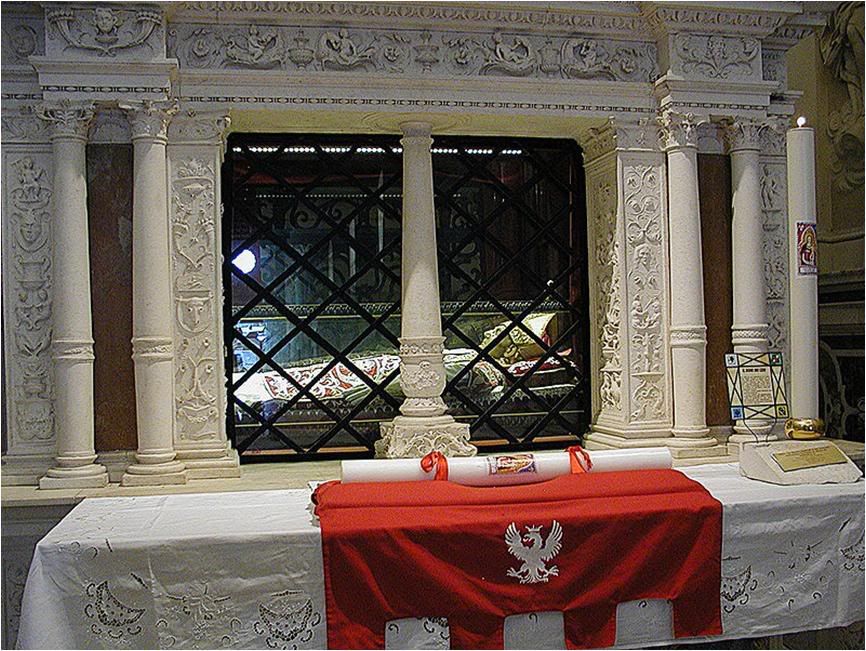
Collemaggio was the Pope;s second stop yesterday after Onna. He lef the pallium imposed on him at his Inaugural Mass as Pope in 2005, as a tribute to his predecessor.

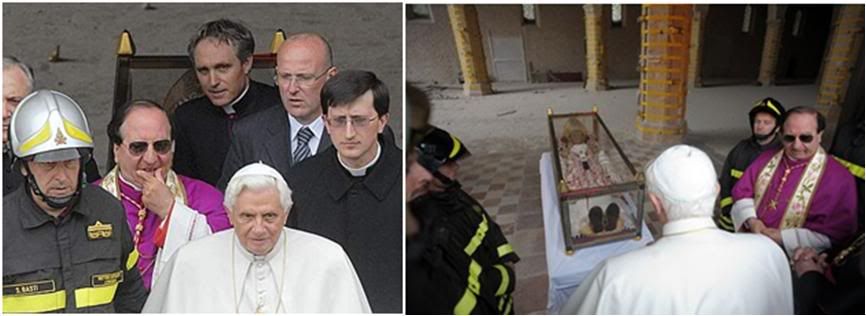
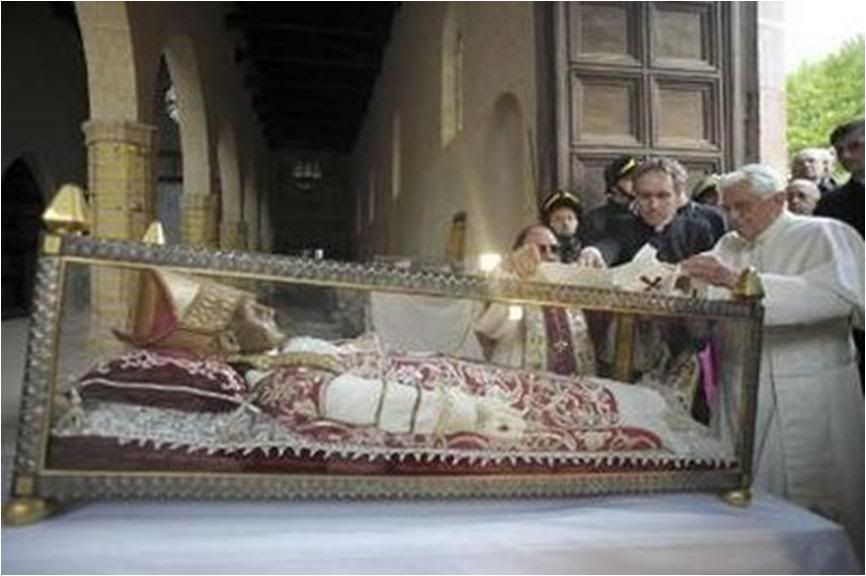

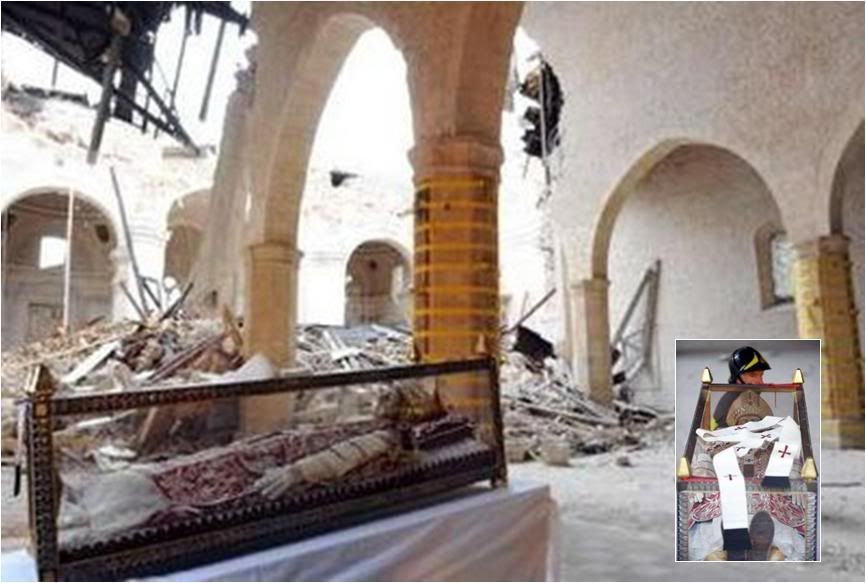
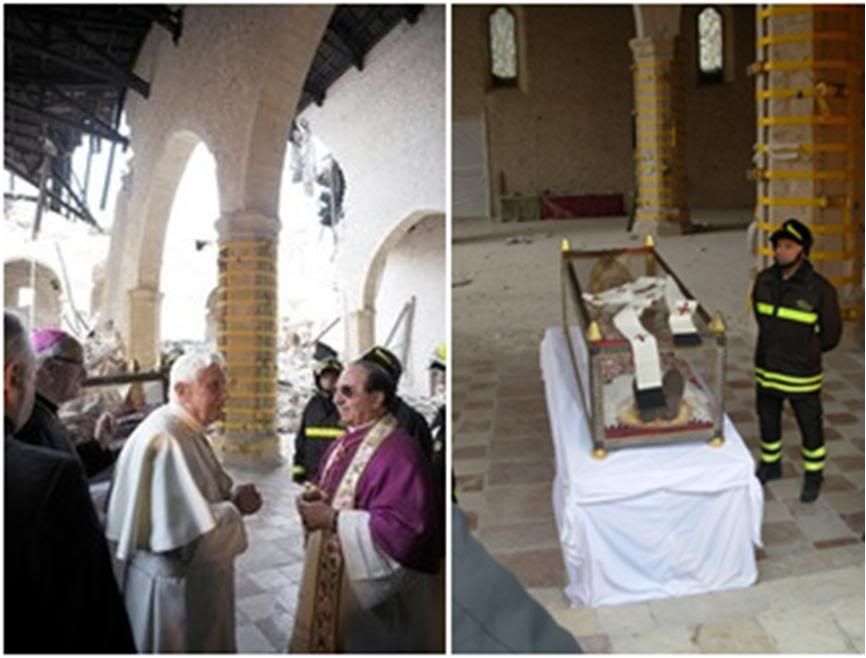
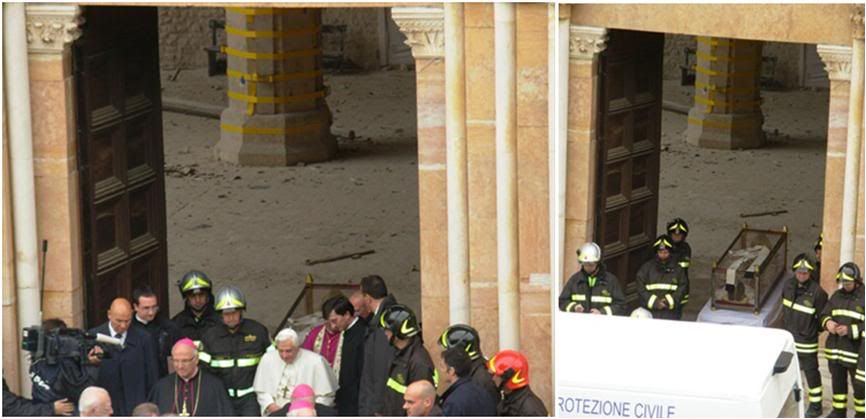
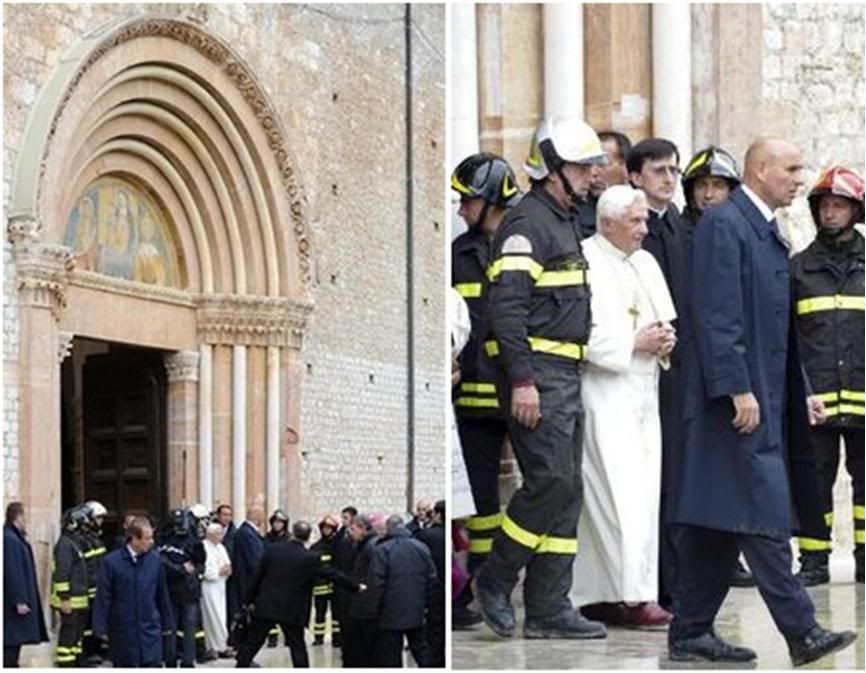
John Paul II was a frequent visitor to the Abruzzo where he liked to make skiing trips to the Gran Sasso mountains, but I have not found any reference so far as to whether he ever visited the remains of Pope Celstine V.
TRIBUTE TO THE MADONNA DI ROIO
AT ASSEMBLY OF DISASTER RELIEF WORKERS, COPPITO
TThe story about the Madonna di Roio it is one of those fascinating tales that abound in religious literature, but I have not found any references in English.
The image and the sanctuary in Poggio di Roio, a village of L'Aquila.
 The image itself is a lifesize wooden statue dating to the 14th century, but the story goes that it was found in 1548 by a shepherd from Abruzzo who was pasturing sheep in neighboring Puglia where it was the custom to bring the flocks in winter.
The image itself is a lifesize wooden statue dating to the 14th century, but the story goes that it was found in 1548 by a shepherd from Abruzzo who was pasturing sheep in neighboring Puglia where it was the custom to bring the flocks in winter.
The shepherd lost one of the flocks he was grazing and prayed to the Virgin to help him in his plight. She appeared to him with the Baby Jesus in her arms, telling him where his sheep had found refuge. Going back to the site of the apparition later with other shepherds to whom he told the story, it is said they found the statue.
With the warmer weather, they headed back to the Abruzzo, bringing the statue home with them, on a mule. Nearing their destination, the mule suddenly dropped to its knees just opposite a Cross in front of the Castle of Roio and refused to go farther. So they took the statue on their shoulders and carried it to the nearby Abbey of St. John. The following day, to their surprise, the statue was no longer there - the people of Roio found it in front of the Cross where the mule had stopped. They gratefully took custody of it and eventually built a sanctuary for it.
The image of the Madonna di Roio graced the stage from which the Holy Father addressed civil servants and volunteers who have been involved in the first aid, rescue and assistance operations since the April 6 earthquake.
The event took place in Coppito near L'Aquila,at the parade grounds of an Italian Finance Guard training facility, where the funeral for the earthquake victims was held on Good Friday.
The pictures here are all I could find that show the Madonna di Roio, because obviously, the news agency photographers did not consider it of special interest, even if there are three photographs that show the Golden Rose offered in homage by the Pope (probably the first Golden Rose tribute done outside of the shrine for the image).
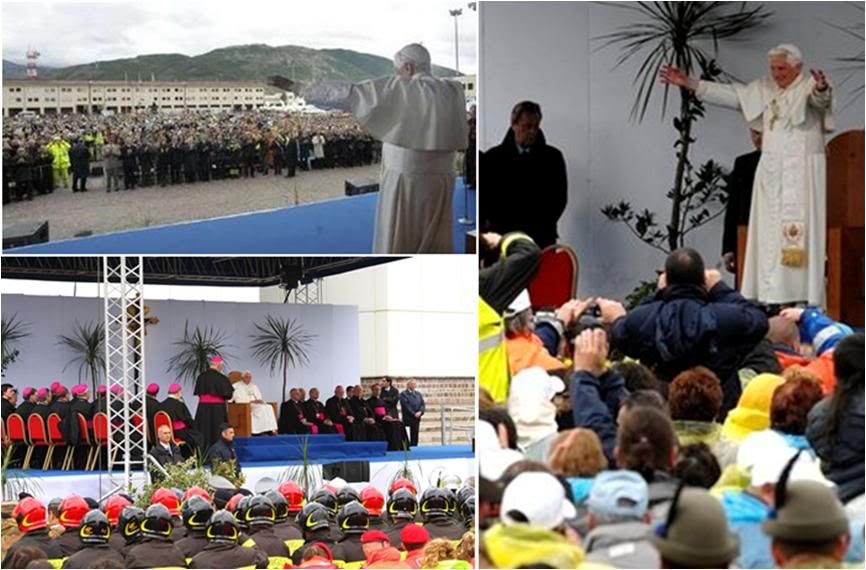
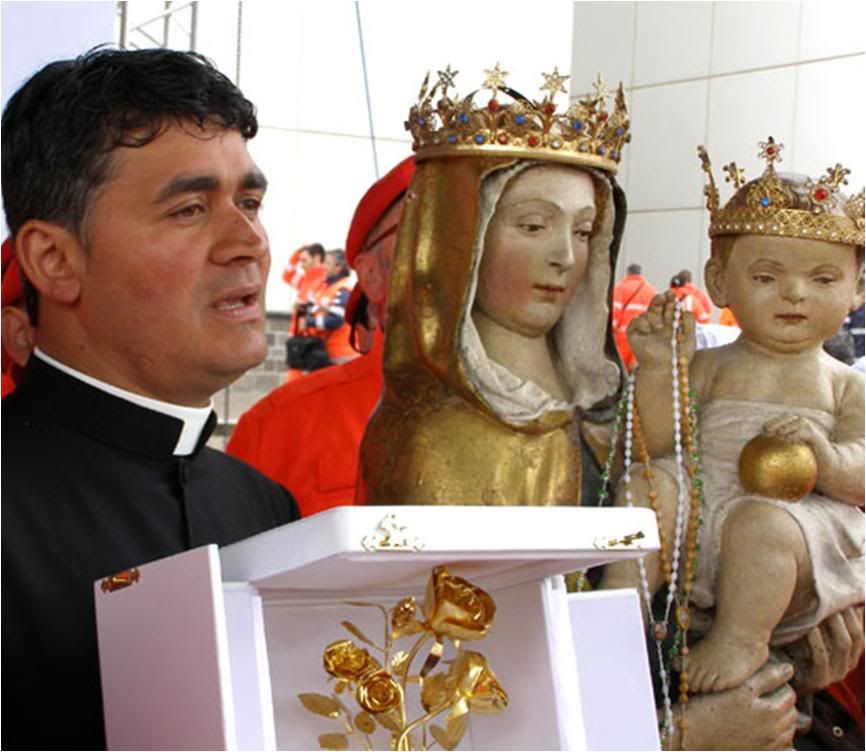

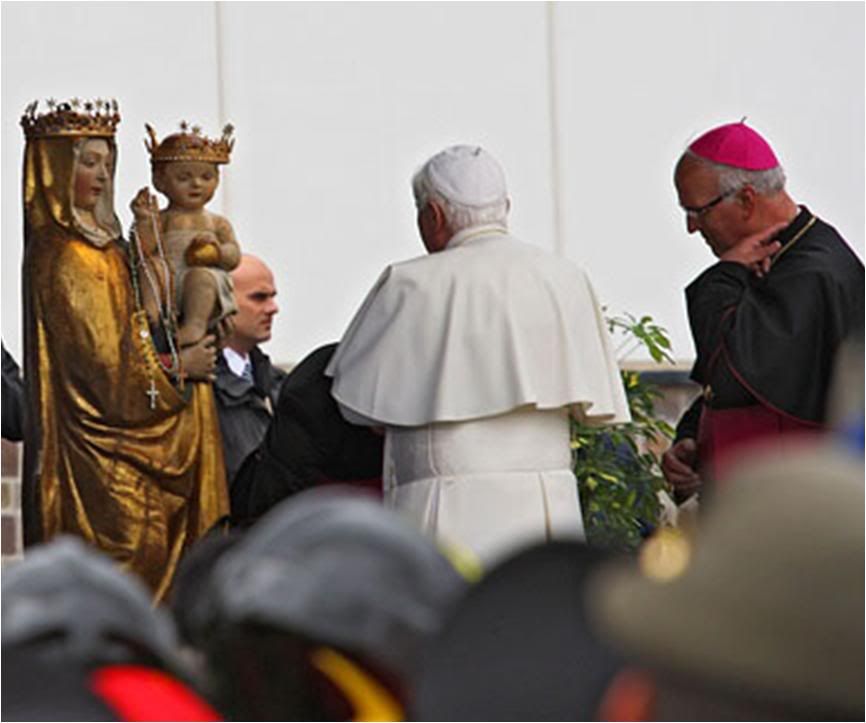
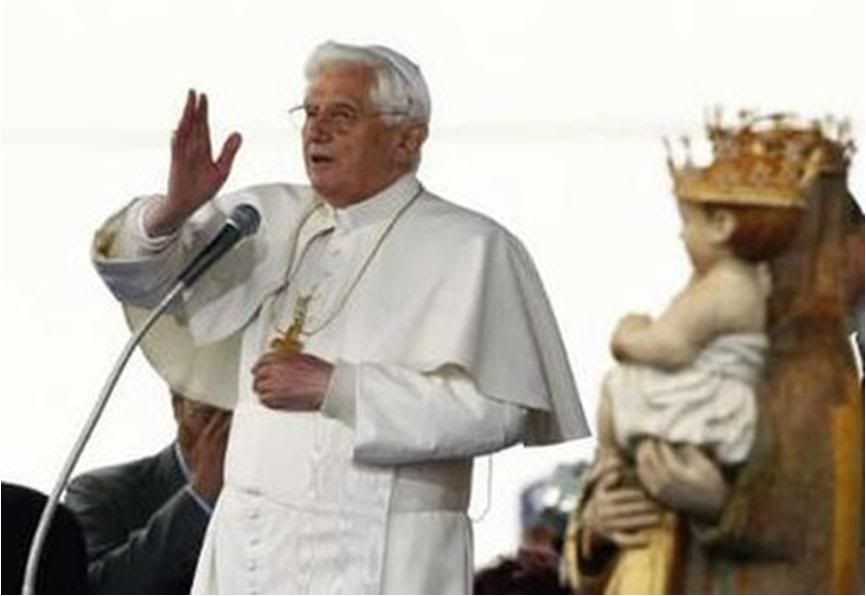
[Modificato da TERESA BENEDETTA 31/05/2009 08:57] |
| |
 01/06/2009 03:29 01/06/2009 03:29 |
|
| | | OFFLINE | | Post: 17.576
Post: 279 | Registrato il: 28/08/2005
Registrato il: 20/01/2009 | Administratore | Utente Junior | |
|
 One papal visit definitely on the books for spring next year is this one:
One papal visit definitely on the books for spring next year is this one:
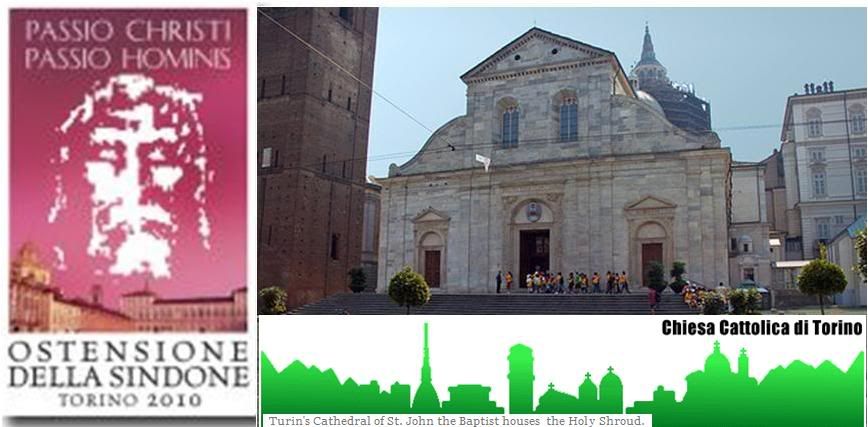 Shroud of Turin public expo
Shroud of Turin public expo
April 10-May 23, 2010:
Pope will visit but
date has not been set
By Cindy Wooden

ROME, April 28 (CNS) -- The Italian Archdiocese of Turin has announced that the Shroud of Turin, which many believe is the burial cloth of Christ, will be on public display April 10-May 23, 2010.
The public exposition in Turin's cathedral will offer members of the public their first opportunity to see the shroud since it underwent major cleaning and restoration in 2002.
The work involved removing 30 fabric patches and a fabric backing, known as the Holland Cloth, sewn onto the shroud in 1534 after a fire.
At the time of the work, Cardinal Severino Poletto of Turin said trapped particles of dirt and scorched fabric had darkened parts of the Shroud of Turin and eventually could have made it difficult to see the shroud's image of a crucified man.
The removal of the Holland Cloth also permitted experts to photograph and digitally scan the back of the shroud.
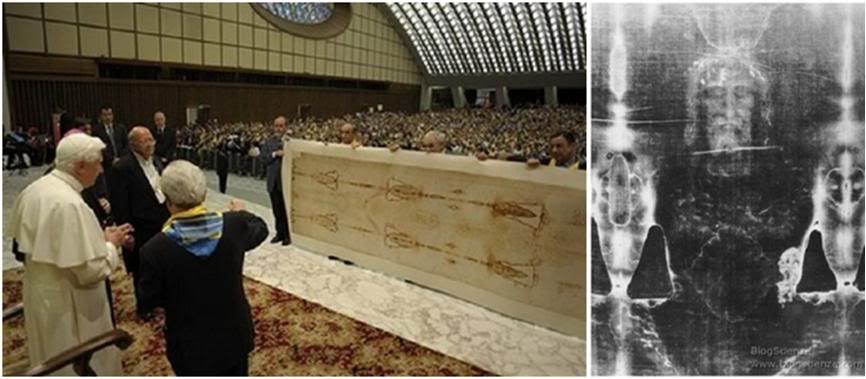
Pope Benedict approved the expposition at a special audience for pilgrims from Turin led by Cardinal Poletto, at teh Aula Paolo VI last June 2, 2008.
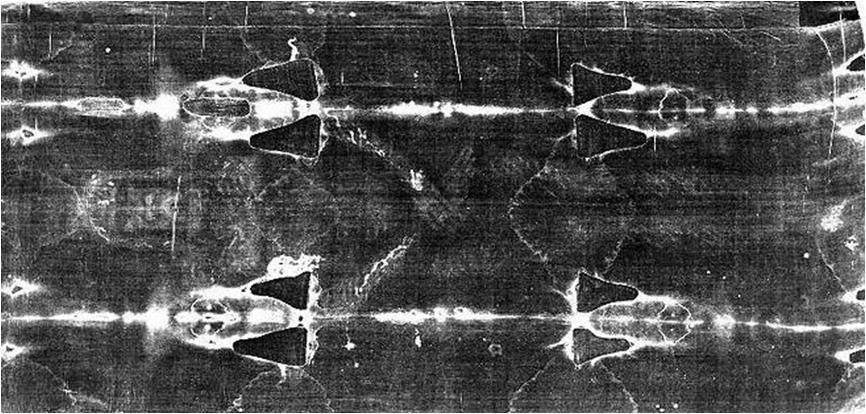 Negatives of the Shroud photos show a full-length portrait of the Body encased by the Shroud.
Negatives of the Shroud photos show a full-length portrait of the Body encased by the Shroud.
The last public exposition of the Shroud of Turin was in 2000. It remained hidden in its specially designed protective case even in 2006 when the Winter Olympic Games brought tens of thousands of visitors to the city.
The Archdiocese of Turin's official Web site for information about the shroud -- www.sindone.org -- is operational even though it is undergoing a redesign in conjunction with the 2010 exposition. Visitors will be able to reserve an appointment in advance to see the shroud.
The archdiocese also said it expects Pope Benedict XVI will visit the city during the exposition period and celebrate Mass on the grounds outside the cathedral. A specific date for the papal visit has not been announced.
|
| |
 01/06/2009 04:06 01/06/2009 04:06 |
|
| | | OFFLINE | | Post: 17.577
Post: 280 | Registrato il: 28/08/2005
Registrato il: 20/01/2009 | Administratore | Utente Junior | |
|
 THIS SUNDAY IN MONTECASSINO:
THIS SUNDAY IN MONTECASSINO:
The special bond between
Benedict XVI and St. Benedict
Translated from
the Italian service of

May 20. 2009
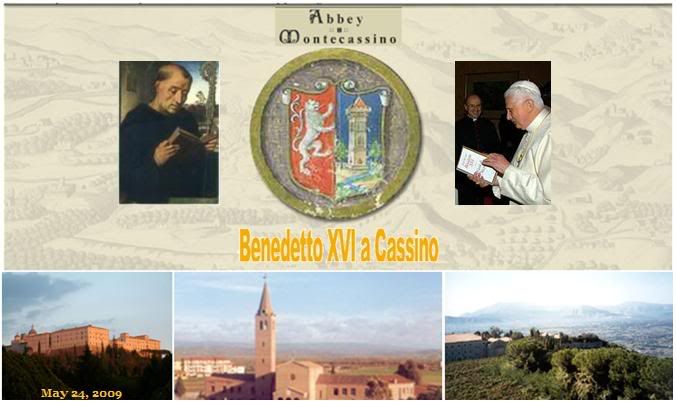
The Church of Montecassino awaits the pastoral visit of Benedict XVI on Sunday, May 24. One of the high points of the visit will be the celebration of Vespers in the Benedictine Abbey with all the Benedictine abbots and abbesses from around the world.
It is a time to underscore how much Benedict XVI is linked to the figure of St. Benedict of Norcia.
Alessandro Gisotti reviews some of the reflections Benedict XVI has made on the saint who is the Patron of Europe and the father of Western monasticism:
St. Benedict is not only in the Pope's chosen name. Above all, he is in his heart.
On April, 1, 2005, a few weeks before being elected to the Chair of Peter, Cardinal Joseph Ratzinger was at the Convent of St. Scholastica in Subiaco near Rome, where he delivered a memorable discourse on the permanent value of the Christian faith in comparison to the limits to the present rationalistic culture.
"We need men like Benedict of Norcia," he said then, "who, at a time of dissipation and decadence" succeeded "to found Montecassino, the city on the hill.. that gathered together the forces from which a new world was formed."
"We need men like St. Benedict," he said, "who have their gaze directed to God, in order to understand true humanity."
Three weeks later, on April 27, at St. Peter's Square, the new Pontiff held his first General Audience and explained his choice of the name Benedict, underscoring how much the Patriarch of Western monasticism is venerated in his homeland, Bavaria:
"St. Benedict constitutes a fundamental point of reference for the unity of Europe and a strong reminder of the irrenunciable Christian roots of her culture and her civilization."
The Pope recalled the recommendation left by Benedict to the monks of his Rule: "Place nothing ahead of Christ" - an exhortation which he made his own at the start of his Petrine ministry:
"At the start of my service as the Successor of Peter, I ask St. Benedict to help us keep firm the centrality of Christ in our existence. May he always have first place in our thoughts and in our every activity."
The Pope spoke about the Benedictine model and its actuality when he addressed the French world of culture at the College des Bernardins in Paris in September 2008. The roots of European culture, he reiterated, took hold in the fertile terrain of Western monasticism. The monks, in their search for God, founded a new civilization. An experience that should be rediscovered:
“Quaerere Deum, chercher Dieu et se laisser trouver par Lui - to search for God and allow oneself to be found by him", the Pope said, "is no less necessary today than it was in the past,"
And he warns against a culture that is 'merely positivistic' which has dismissed the question of God. This represents, he said, 'a setback for humanism'.
"That which founded the culture of Europe - the search for God and the readiness to listen to him - " he reiterated, "remains even today the foundation of every true culture."
And on September 20, 2008, receiving Benedictine abbots from around the world, he exhorted them to announce without compromise the primacy of God, especially in a world that is ever more desacralized:
"In your monasteries, it is you above all who renew and deepen daily your encounter with the person of Christ, whom you always have with you as guest, friend and companion. That is why your convents are places where men and women even in our day seek out in order to find God and to learn to recognize the signs of the presence of Christ, his charity and his mercy."
The Pope dedicated his catechesis of April 9, 2008, to the saint whom St. Gregory the Great called a 'luminous star'. The Pope emphasized the significance of the construction of the abbey at Montecassino:
"In the year 529, Benedict left Subiaco to settle in Montecassino... He came to this decision because he had entered a new phase of his interior maturation and his monastic experience... Monastic life in its hiddenness has a reason for being, but a monastery also has a public end in the life of the Church and of society - it should give visibility to the faith as a force of life".
Thus the Pope calls on a Europe that has lost its way, that in trying to rediscover its own identity, it should look to St. Benedict and his teachings:
"In order to create a new and lasting unity, political, juridical and economic instruments are certainly necessary, but one must also awaken an ethical and spiritual renewal which draws from the Christian roots of the Continent. Otherwise, one cannot rebuild Europe... In seeking true progress, let us listen even today to the Rule of St. Benedict as a light for our path. The great monk remains a true teacher in whose school we can learn the art of living true humanism."
[Modificato da TERESA BENEDETTA 01/06/2009 04:07] |
| |
 01/06/2009 04:20 01/06/2009 04:20 |
|
| | | OFFLINE | | Post: 17.578
Post: 281 | Registrato il: 28/08/2005
Registrato il: 20/01/2009 | Administratore | Utente Junior | |
|
5/22/09
The Vatican released the formal program for the papal visit to Monte Cassino.
PASTORAL VISIT OF HIS HOLINESS BENEDICT XVI
TO CASSINO AND MONTECASSINO
Sunday, May 24, 2009
PROGRAM
09.00 Departure by helicopter from the Vatican
09.30 Arrival at the Salveti sports field in Cassino
10.15 EUCHARISTIC CONCELEBRATION
Piazza Miranda, Cassino
Homily by the Holy Father
12.00 Regina Caeli prayer
Words by the Holy Father
12.30 Travel by car to the Abbey of Montecassino
Brief visit to the Casa della Carità of Cassino
13.30 Lunch at the Abbey
16.30 Grreting to the monastic community of the Abbey
and to the organizers of the visit
17.00 CELEBRATION OF VESPERS
with Benedictine abbots and
the community of Benedictine monks and nuns
Basilica of the Abbey
Homily by the Holy Father
18.00 Private visit to the Polish Military Cemetery in Montecassino
18.30 Departure by helicopter
19.00 Arrival at the Vatican
[Modificato da TERESA BENEDETTA 01/06/2009 04:22] |
| |
 01/06/2009 04:25 01/06/2009 04:25 |
|
| | | OFFLINE | | Post: 17.579
Post: 282 | Registrato il: 28/08/2005
Registrato il: 20/01/2009 | Administratore | Utente Junior | |
|
 Towards a fully-aware faith:
Towards a fully-aware faith:
Benedict XVI returns to Montecassino
by Carlo Di Cicco
Translated from
the 5/24/09 issue of

The last time Joseph Ratzinger was in Montecassino was for five days in February 2000.
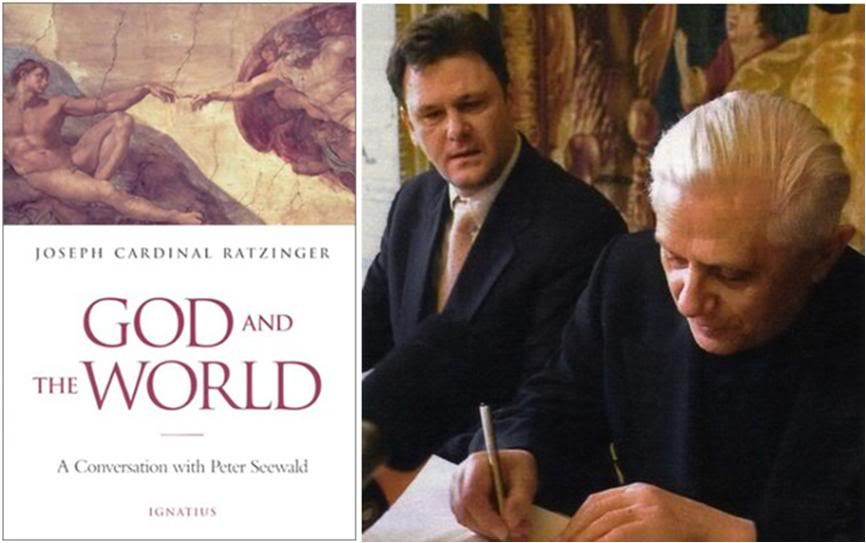
It was an occasion for the future Pope to mature some of his thoughts - as he later wrote, recalling the long interview he gave German writer Peter Seewald there, which then became the book God and the World.
It is about being Christian in the new millennium - 'a small attempt to introduce the faith to the man of today'.
And Benedict XVI's return to Montecassino today is part of that design which remains the one true secret for reading his pontificate in its true light.
He is returning to one of the oldest sources of Benedictine spirituality that is at the root of his Christian formation and explains his insistence on exhorting Christians to a faith that is fully aware, if they wish to reawaken the cultural capacity of European society that is in a phase of great change as a result of so many unforeseen factors.
As in the time of St. Benedict - father of Western monasticism - when the society inherited from the Roman Empire was put to the test by the new peoples that had come from the outside world, and not always in a friendly way, so today, Europe must deal with the tens of thousands of immigrants that have arrived on the continent, driven out of their native countries by necessity.
The recomposition of the human fabric, which must result in time from mass migrations, finds in the Benedictine example a paradigm which can still be effective.
From their infancy, children in the lands influenced by St. Benedict were strongly imprinted with the figure of Totila, King of the Goths, who laid down his sword at the feet of the patriarch Benedict.
What reason could there be - we may well ask - for a king, at his moment of triumph, to kneel before a powerless man in a land that had been so trampled by opposing combatants?
St. Benedict was credited for his wise perspective of reconstructing the social and religious fabric that had been torn apart in the successive invasions.
And the reconstruction was according to his own Christian life spent entirely for others - in the light of his famous exhortation "Do not place anything ahead of the love of Christ" which he imposed as rule of life for all his new monks.
Benedict XVI is closely linked to the Benedictine style and the Christian vision of the sainted founder of Montecassino.
He chose to bear his name, he committed himself right away towards mutual understanding among peoples and religions, he has called the Church and the faithful to be sincerely converted to a lived faith in which nothing comes ahead of God.
And the simple motivation is love. To convert for love to a God who loves and who must be perceived as a God of love even in the 21st century.
The Pope who advocates harmony between faith and reason, prayer and work - in order for man to be able to carry on the search for the Absolute even outside religious precincts - hopes to be able to convert Christians first of all to the primacy of God's love.
In fact, he points out that social activism by believers - when it is not spiritually animated - remains sterile.
The power of Christian witness - which at one time was left to monasticism at the time of its flowering - is diminished by the shrunken dimensions of consecrated life today.
In line with the Church of Vatican-II, the Pope asks of every Christian to take on the responsibility of the Gospel in his daily life. The meeting today (Sunday) with the faithful of Montecassino and all Cassinate is inspired by this vision.
Because he is impelled by the spirit of colloquium with everyone in order to consolidate the peace, Benedict XVI can be counted among those unarmed prophets in a world that is more fraternal and solid, a goal towards which so many persons have dedicated their lives.
 The Abbot of Montecassino recalls
The Abbot of Montecassino recalls
his first meeting with Cardinal Ratzinger
Interview with Abbot Pietro Vittorelli
by VITTORIO BUONGIORNO
Translated from

May 23, 2009
The Holy Father is coming here a few days after his trip to the Holy Land.
He arrives at a special moment in his Pontificate, after a most important trip during which he preached the importance of peace, diplomacy, dialog.
I am happy to think that at Montecassino he may be able to find a bit of restoration as well as that festive welcome for someone who is coming home.
What do you remember of the last visit of then Cardinal Ratzinger to Montecassino?
I was most impressed with his monastic attitude, his full insertion into the rhythm adn life at the monastery, his ability to concentrate for hours on a task that is not always easy.
He devoted a week here to the interview that would become the book God and the world, and I had the assignment and the honor to be of assistance to him. He was enraptured by the atmosphere here.
Then there was the kindliness of his nature, almost timid, respectful of everyone, from the abbot down to the porters and the sacristans.
What will you ask of the Pope?
On occasions like this, one thinks more of what one should give him. He already carries a lot on his shoulders.
The central event of the visit will be the inauguration of the House of Charity.
That, too, is a dream for me. When we were putting together our efforts for solidarity in the parish, I never imagined that the fruit of those efforts would be blessed by the Pope himself. If one thinks back now, one sees it as a sign of God's blessing.
But this is only the beginning. We have to sustain it so that it has a future, and can provide a future for those who will find hospitality there.
How was the idea born?
Shortly after I was elected abbot, the local Caritas had to lodge an African mother with her baby in a minibus because the hotels did not want to accept her, and there was no other solution.
I was indignant - it was Christmas - and so I thought of the old regional hospital that was abandoned, and I spoke to the president of the region so that we could renovate part of the complex into a hospitality center for foreigners who are in need, and also people leaving jail who do not have a place to go to.
The question of immigrants has been much discussed in our country lately.
It is an emergency about which the Church is called to give a credible response, even in the face of some rather xenophobic trends, of positions that are not always cordial towards those who are in difficult circumstances and who are forced to leave their own countries.
It is a delicate question, as every time one holds out a hand to someone who is needy, there is the risk that he will refuse or take offense, but as a Christian, as a man and citizen, we cannot fail to show the world how far we have come along in a civilization marked by the evangelical message.
We must show the fruits of cultural growth, which does not mean closing up but welcoming, with an ability to be patient even with those who do not yet know how to follow the rules of human coexistence.
What will the Casa della Carita mean for Cassino?
I would like all our diocesan entities to collaborate in a single project. And charity is one of the virtues that each Christian is called upon to practise.
You have called particularly on young people to take part in this project.
In order to give substance to their youth, so they don'taste their free time simply on play stations and watching TV, which certainly are normal activities for their age, but cannot be the most significant part of their life. I have asked them to come and see what it is to live and work with the marginalized, the poor, the strangers.
And how have they responded?
There has been some response - not as great as I would have wanted. But it is just as important that some do commit themselves and set an example. But my dream is that this house of charity will not only help the poor and disadvantaged but provide an opportunity for growth to our young people and to our educators.
What message will come from Montecassino tomorrow, where all the Benedictine abbots and abbesses from around the world will be gathered together with the Pope?
That there can be unity out of diversity. All the abbots and abbesses do not necessarily live the Rule [of St. Benedict] in the same way, but that is the strength of the Rule - that it is adaptable to any population in any part of the world, because it is firm on one point: that the truth comes from Jesus, for whoever lives the Rule here or in Africa, in Colombia or Argentina.
It makes possible peaceful coexistence and unity around universal values that are acceptable to believers as well as non0believers - values like respect for life, civil coexistence, the right to education and to health. Any race and people can unite around these values.
Will anything change in the Abbey after this visit?
That's difficult to say for an abbey that has 1500 years of history and which has seen a whole series of Popes come and go. Of course, the visit of a Pope who took the name of St. Benedict will make us more committed to express our monastic life according to the directions for the Church coming from the Pope. We will listen to what he will tell us and we shall be carry it out humbly.
And on Monday?
We will return to the centuries-long quiet of the Abbey and resume our monastic life of silence, prayer, work, and hospitality.
From the Sunday OR, here's another interview with Abbot Vittorelli:
The Pope at the heart
of Christian Europe
An inrerview
by NICOLA GORI
Translated from
the 5/24/09 issue of

The expectation, the hope, the joy at the arrival of Benedict XVI on a visit to the abbey and dicoese of Montecassino this Sunday, are echoed in the interview given by Abbot Pietro Vittorelli to this newspaper.
Benedict XVI comes to Montecassino bearing his strong links with St. Benedict. How have these links emerged so far in his Petrine ministry?
Benedict XVI has underscored many times, from the start of his Pontificate, a rootedness in Benedictine spirituality, re-proposing it in his discourses and catecheses, which show a remarkable synthes of 'nihil amore Christi praeponere' [Do not place anything ahead of Christe) that St. Benedict has in the fourth chapter of his Rule "On the instruments of good works) (4,21), and which the Holy Father has cited many times. almost as a leitmotiv of his theological narratives.
When on the evening of April 19, 2005, from the Loggia of Benedictions, Cardinal Jorge Arturo Medina Estevez announced to the world that Cardinal Ratzinger had been elected Pope and that he had chosen to be called Benedict, besides the uncontainable joy of the entire monastic world - which in Montecassino was all caught up in the sound of pealing bells and peak usage of the telephone and e-mail, - some monks did not miss the immediate reference to the Rule of St. Benedict in the new Pope's first words declaring himself to be 'a humble worker in the vineyard of the Lord'.
Although the Gospel reference was clear, the expression of humility so typical of St. Benedict was equally unmistakable, along with the expression in the Prolog to his Rule 'Et quaerens Dominus, in moltitudine populi cui haec clamat, operarium suum' (And the Lord, seeking his laborer in the multitude to whom He cries out)...
In the tireless Petrine service of Benedict XVI, there has never been any lack of reference to the importance of Europe's Christian roots and the service rendered to the Churcc in this regard by the monks and nuns of St. Benedict. But the Pope does not just have an 'archeological' regard for Benedictine monasticism: he grasps it in all its vitality and the prospects it has for the future.
When he received the World Congress of Benedictine abbots in September 2008, he said: "To construct a new Europe, one must begin with the new generations", before widening the perspective to the entire human family to underscore that "in many parts of the world, especially in Asia and Africa, there is a great need for vital spaces that enable an encounter with the Lord, in which, through prayer and meditation, man can recover serenity and peace within himself as well as with others".
But the text which, to my mind, will remain the 'Benedictine manifesto' of his Pontificate was the magnificent lecture he delivered at the College des Bernardins in Paris, in his encounter the world of French culture.
He introduced it by saying "I wish to speak to you this evening of the origins of Western theology and the roots of European culture", and with that theological mastery which is typical of him, and with a monk's heart, he wove the most beautiful song about 'quarere Deum', searching for God.
The Pope's references to St. Benedict necessarily validate his reflections on Europe. Do you think Benedict XVI's visit will have a meaning for the entire continent in its search for its Christian roots?
The visit of a Pope named Benedict to the cradle of Western monasticism, in the place which has reflected the eyes of St. Beenedict, from which came the impulse for a new evangelization of the European continent, cannot fail to have an echo in contemporary Europe.
The Pope willl reaffirm the importance for contemporary man to re-appropriate a kind of workday mentality, the normality of the Benedictine day-to-day routinr of 'ora et labora et lege' (pray and work and read) which can continually shape man.
"In your monasteries, you primarily renew and deepen daily your encounter with the person of Christ, whom you always have with you as guest, friend and companion. That is why your convents are places where men and women, even in our time, go to expressly to look for God, to learn to recognize the signs of the presence of Christ, of his love, of his mercy". That is what he said at the last audience that he gave to Benedictine abbots who were meeting in an international congress.
The diocese of Montecassino is historically dependent on the abbots of the Abbey. Does this bring any difficulty in carrying out the diocesan pastoral work that this requires?
The diocese of Montecassion is Montecassino, and Montecassino is its diocese. The indissolunle link which has united our parishes and our population at the monastery and its abbot have 15 centuries of history, which began with the arrival of St. Benedict himself in the sixth century.
In the following centuries, it underwent modifications the demands of changing times and which the wisdom of my predecessors aa abbots were able to harmonize.
Today our diocese, after a long path by Synod, has executed all the recommendations of Vatican-II.
Difficulties arose when for a long time, we suffered indecision over the future of the abbatial territory itself. That period created such uneasiness among the clergy about their future, and above all, among the faithful who had become so embedded in the Benedictine matrix.
Now that the Holy See has confirmed a new stability with the nomination of a new abbot and diocesan bishop, the life of this small but significant diocesan Church has resumed its centuries-long path, conserving the prayerful force of a monastic community, amd among them, the passionate testimonies of so many priests who were raised in the school of St. Benedict.
The pastoral plan which we unveiled last year for the diocesan Church provides for a five-year period dedicated to reflecting on the Word of God.
The Abbey of Montecassino is undoubtedly a reference point for Western monasticism. What does it represent today for teh Order and for contemplative life?
Montecassino remains the mother house for all Benedictines. From the world, there is a constant passage of monks asnd nuns paying homage at the tomb of St. Benedict, and certainly, Montecassino represents for everyone the heart of St. Benedict's experience.
The Holy Father himself, when he presented the figure of St. Benedict in the general audience of April 9, 2008, said: "Monastic life in its hidenness has a reason for being, but a monastery also has a public purpose in the life of the Church and of society - it should give visibility to the faith as a force of life".
Thus he justified authoritatively the passage of St. Benedict from Subiaco - which remains the other great Benedictine center - to Montecassino, which, from the experince of St. Benedict, is precisely the visibility of faith as a force of life.
Does Benedictine spirituality have any influence on the religious life of the diocesan faithful?
Yes, they are totally immersed in Benedictine spirituality. Many of our outstanding priests were educated by the monks when the seminary was in the monastery. The attention to liturgy, the love for choral singing, the ringing of the bells at Angelus three times a day in all our parishes, the appetite for the Word of God, the nocturnal pilgrimage to the abbey for Pntecost vigil, are just examples.
Imagine that a small diocese like ours has 28 parish choirs who we listen to every year in a much-awaited general concert, with a continuous rediscovery of Gregorian chant and traditional polyphony ehich had admirable promoters from our monks in the 20th century: Dom Mariano Taccarino and Dom Luigi De Berio were master teachers for many.
Every year for the Feast of St. benedict, on March 22, we celebrate a true and proper Day for Europe, and to rediscover Benedictine roots specifically, the historical pageant Terra Sancti Benedicti was instituted 15 years ago. Every year, this involves some 500 persons, mostly young people, who evoke the times of the Abbot Bernardo Ayglerio between the 13th and 14th centuries, with costumes and episodes based on historical research.
Then we have the St. Benedict Catholic School in the city which is run by our monks along with the Sisters of Charity of St. Giovanna Antida Thouret, which has 500 pupils from kindergarten to classical lyceum (high school).
Do St. Benedict and St. Scholastica (his twin sister) attract pilgrims from other faiths?
We often have Buddhist monks as guests who want to be acquainted with our form of life. We have had visits from Muslims, including ranking personages like King Abdullah of Jordan, whose grandfather had fought here in Montecassino during World War II; also, Mr. Khatamee of Iran when he was president. And so many Jewish guests as well, especially from the Jewish community in Rome.
Montecassino is also a place which recalls the horrors of war. What is the commitment of your monks and the diocese to the cause uf peace?
Several decades ago, the death and destruction that befell the abbey and its territory devastated thousands of human lives here around us. This land has resonated with the cries of sorrow and the weeping of families and individuals. All this has led both abbey and diocese to continuously work in order to build the peace.
This commitment is solemnly renewed every year on the anniversary of the bombardments over Montecassino and the city, to which surviving veteans come in order to reaffirm their commitment to peace.
|
| |
 01/06/2009 04:30 01/06/2009 04:30 |
|
| | | OFFLINE | | Post: 17.580
Post: 283 | Registrato il: 28/08/2005
Registrato il: 20/01/2009 | Administratore | Utente Junior | |
|
Satellite view of the Abbey.
 BENEDICT XVI IN CASSINO & MONTECASSINO
BENEDICT XVI IN CASSINO & MONTECASSINO

Upon his arrival by helicopter at the Salveti sport field in Cassino this mortning, Pope Benedict XVI was welcomed by politicla, civiliana nd ecclesiastical authorities.
He then proceeded by Popemobile to Piazza Miranda, the main square of Cassino, which starting today, by a decision of the Communal Council, will be called Piazza Benedetto XVI.

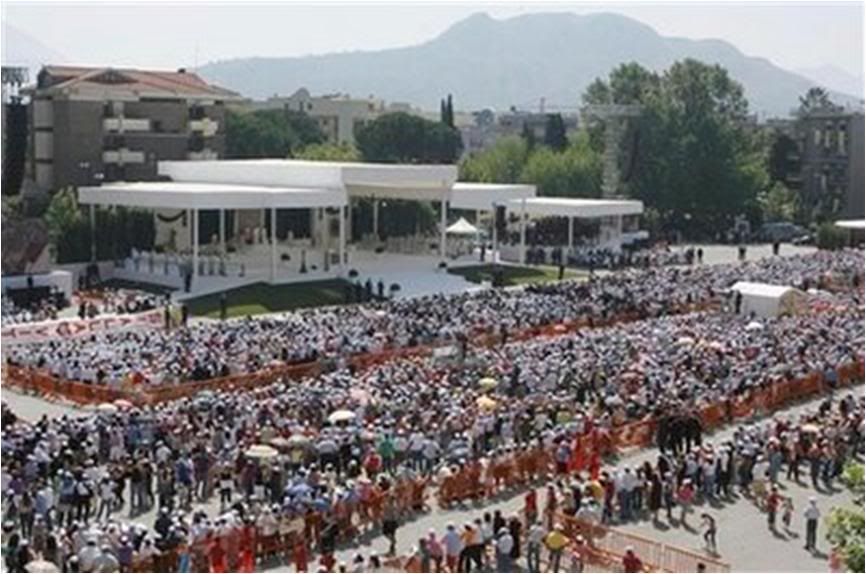
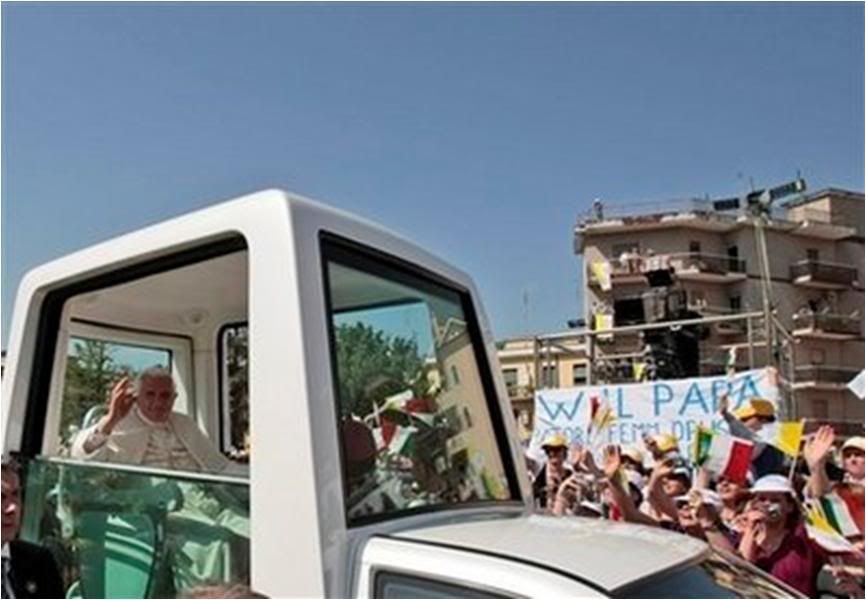
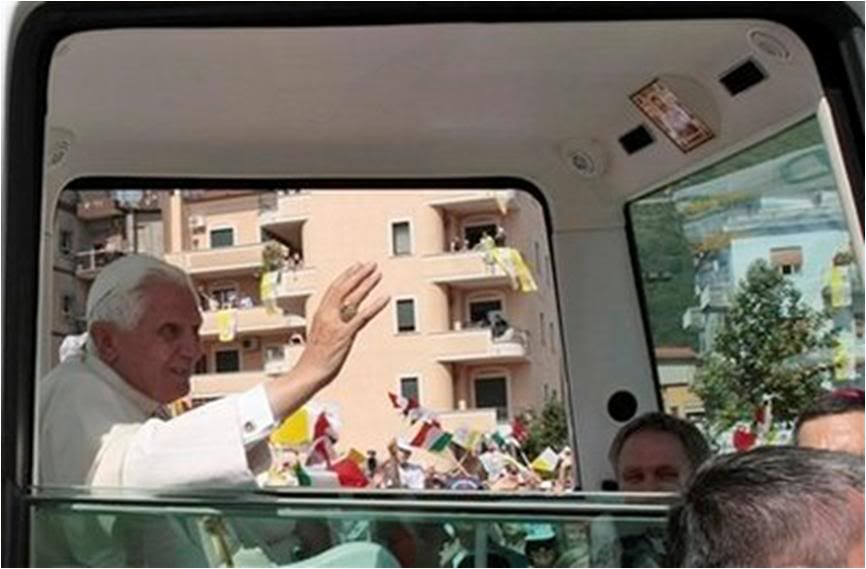
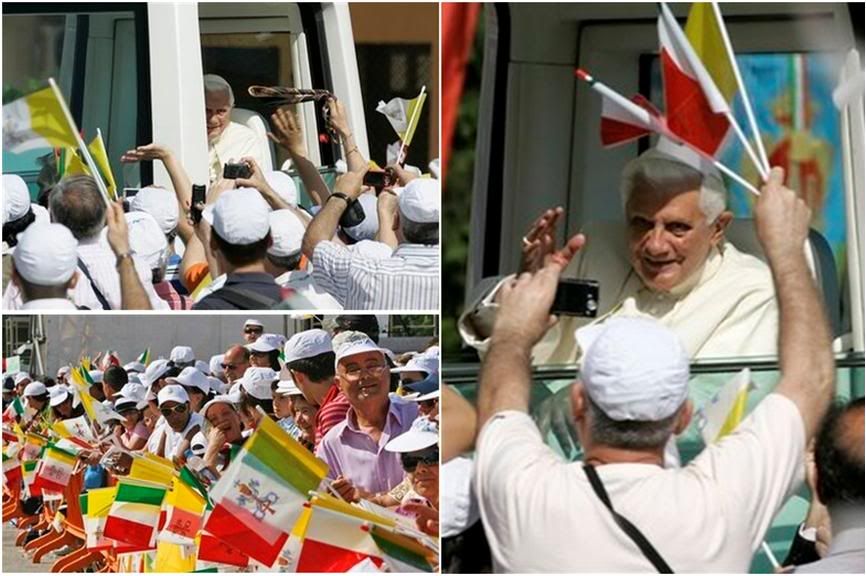
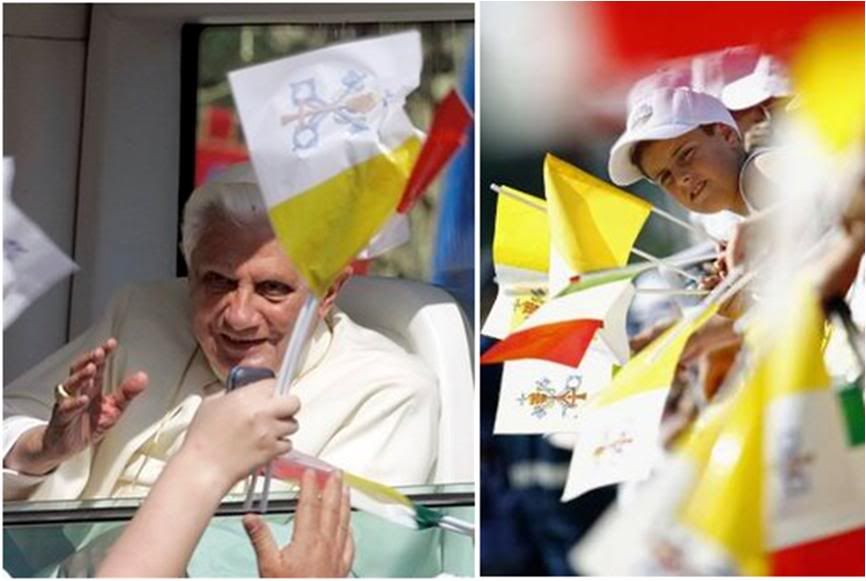
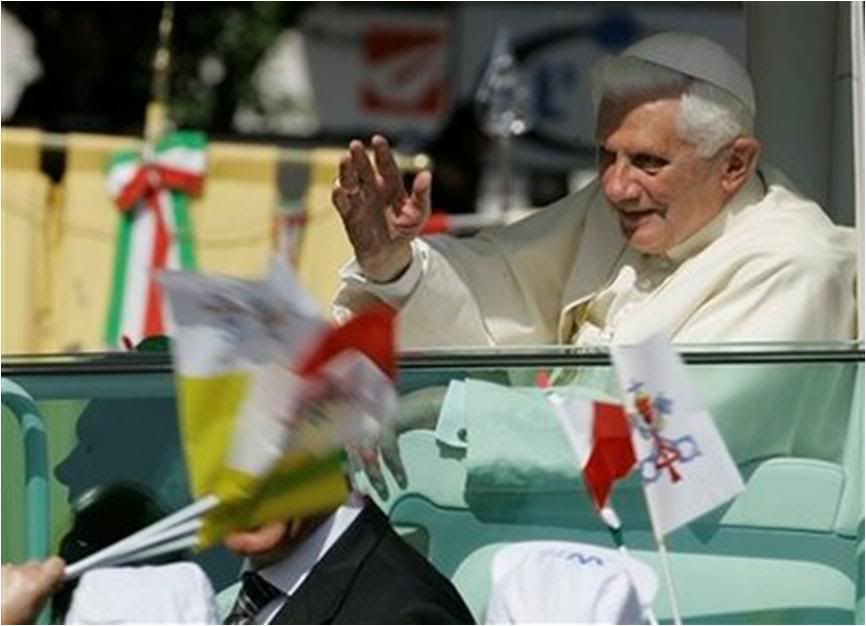
The Pope received a formal welcome from the Mayor of Cassino, Dr. Bruno Scittarelli, who offered him, in the name of the citizens, a Roman-style Crucifix from 1633.
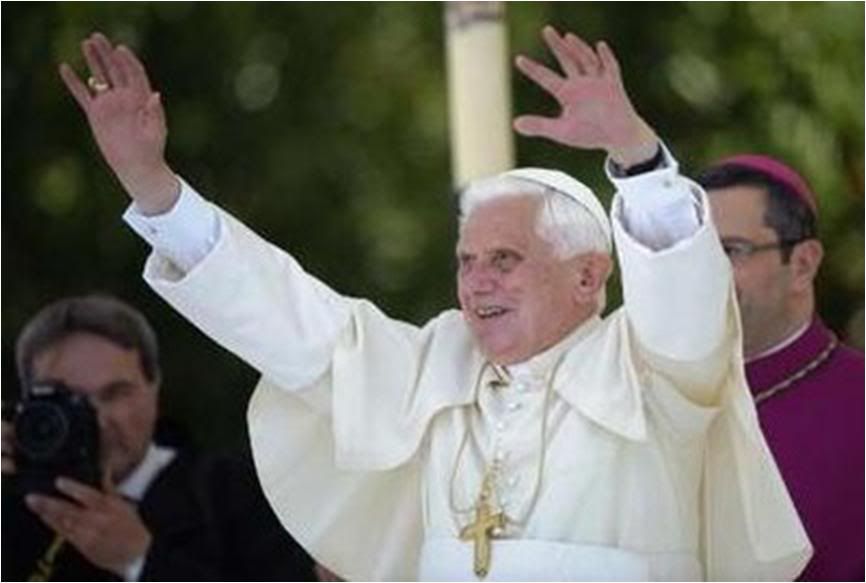
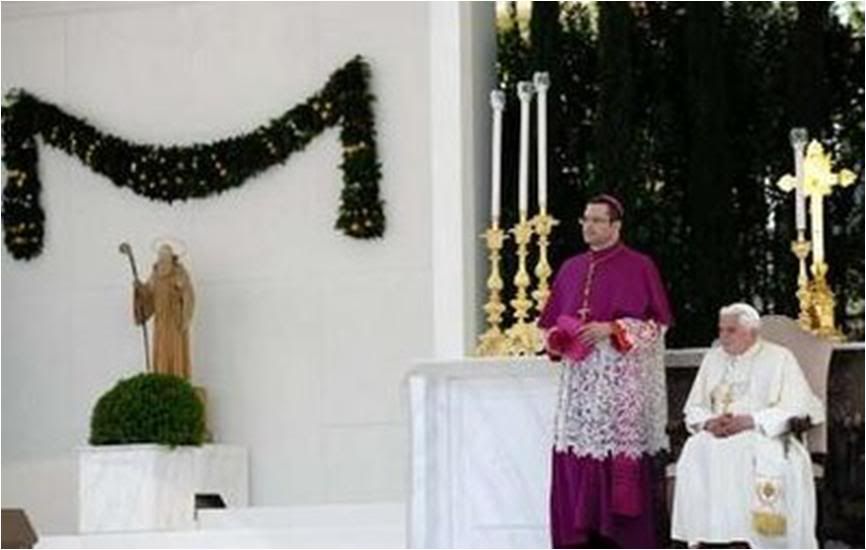
The Holy Father said a short prayer at the image of the Madonna that was set up at the altar, before walking to a nearby sacristy to vest for the Mass.
 THE MASS
THE MASS
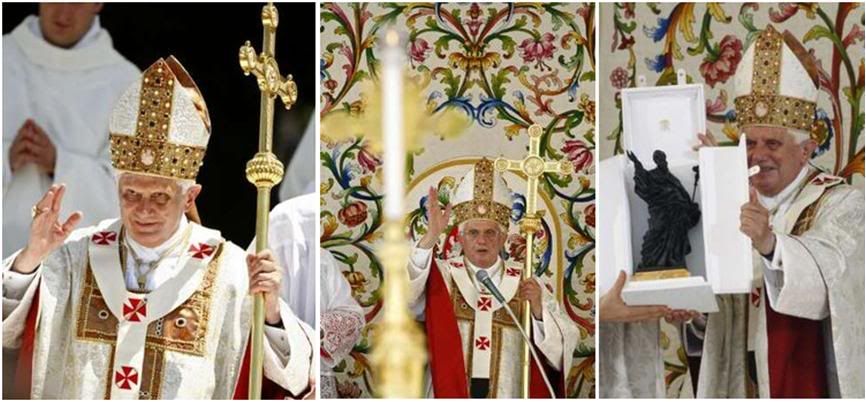 NB: The Mass at Piazza Miranda today - correction, at Piazza Benedetto XVI - was unusually special for the music, provided by a symphony orchestra and Montecassino diocese's famed choral voices that Abbot Vittorelli touted in one of the interviews posted earlier. The choice of music numbers was outstanding, and the sounds were glorious.
Benedict prays for peace
NB: The Mass at Piazza Miranda today - correction, at Piazza Benedetto XVI - was unusually special for the music, provided by a symphony orchestra and Montecassino diocese's famed choral voices that Abbot Vittorelli touted in one of the interviews posted earlier. The choice of music numbers was outstanding, and the sounds were glorious.
Benedict prays for peace
at site of WWII battle

CASSINO, Italy, May 24 (AP) — Pope Benedict XVI prayed Sunday for an end to all wars, making a pilgrimage to the site of a decisive World War II battle and decrying the destruction and lives lost there.
The German-born Benedict visited the Benedictine monastery at Monte Cassino, which was leveled during a 1944 Allied bombardment and was the site of a bloody ground battle between German and Allied forces.
Benedict, who, growing up in Germany was forced to join the Hitler Youth, cited the 65th anniversary of Monte Cassino's destruction before thousands gathered for Mass in Cassino, at the foot of a rocky hill on which the monastery sits.
"In this place, where so many lost their lives in the battles that were fought during the Second World War, we pray especially for the souls of the fallen, commending them to God's infinite mercy, and we pray for an end to the wars that continue to afflict our world," Benedict said in English at the end of Mass.
He added he was visiting the nearby Polish military cemetery later Sunday to pay homage to "all the military forces from diverse nations who gave valiant witness and lost their lives here."
The cemetery contains the remains of Polish troops who fought alongside the Allies and died trying to take control of the Monte Cassino abbey and surrounding positions from German troops. The battle for the battle was decisive for the Allied advance on Rome, 80 miles to the north.
Noting that all Benedictine monasteries carry the word "PAX" — peace — at their entrances, Benedict urged all Christians be witnesses to peace, saying it was a "challenging mission to be fulfilled everywhere."
Benedict was also making a personal pilgrimage to the Monte Cassino monastery, which has long been dear to him. It was founded in 529 by St. Benedict of Nursia, known as the father of Western monasticism and a patron saint of Europe.
The Pope has spoken frequently about his strong affinity for St. Benedict, a hermit and monk whose writings became the basis for the Benedictine order.
In his first general audience as Pope, in April 2005, Benedict said he had chosen to call himself Pope Benedict XVI to pay homage to St. Benedict, who he said was a "fundamental point of reference for European unity and a strong reminder of the undeniable Christian roots of her culture and civilization."
During his homily Sunday, the Pope cited the saint's commitment to both prayer and work, and said he was particularly concerned about the plight of workers in Cassino, home to a Fiat plant at risk amid the economic downturn.
"The wound of unemployment, which afflicts this land, compels those responsible for public life — businessmen and others who are able — to find valid solutions to the labor crisis, creating new jobs so families can be protected," Benedict said.
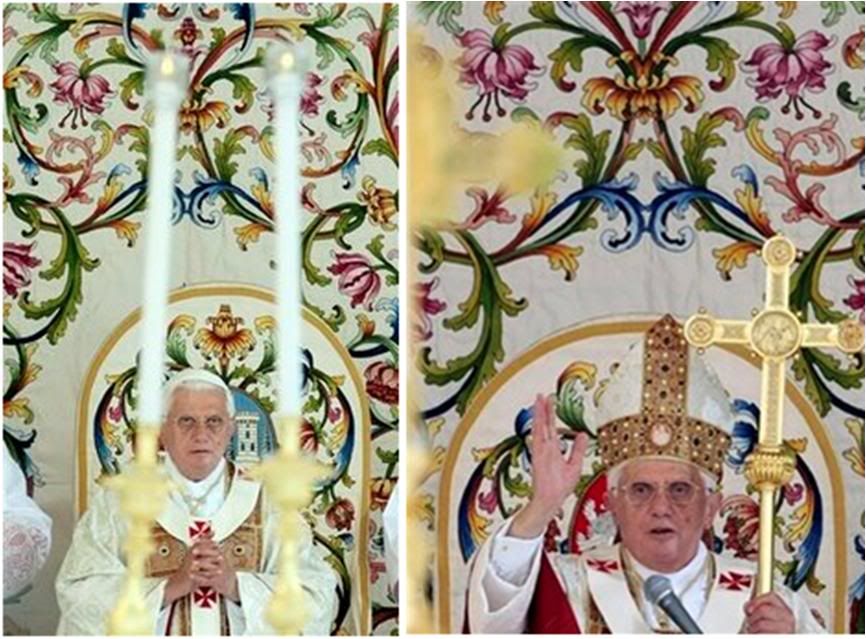
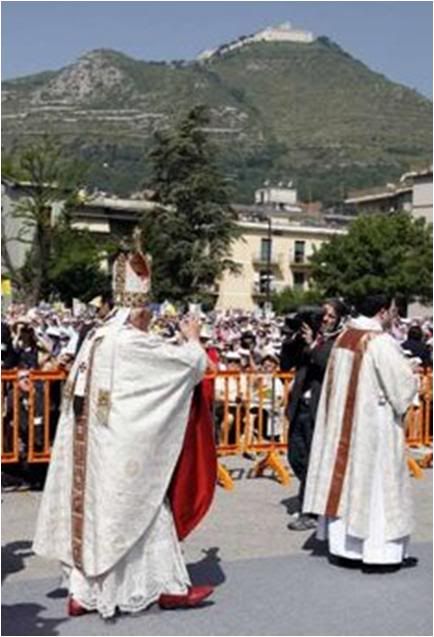 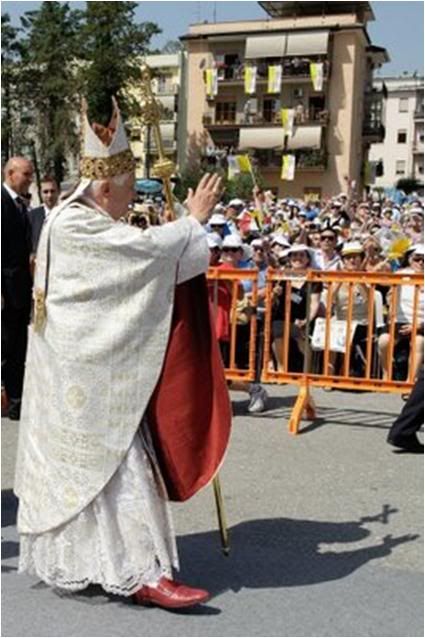
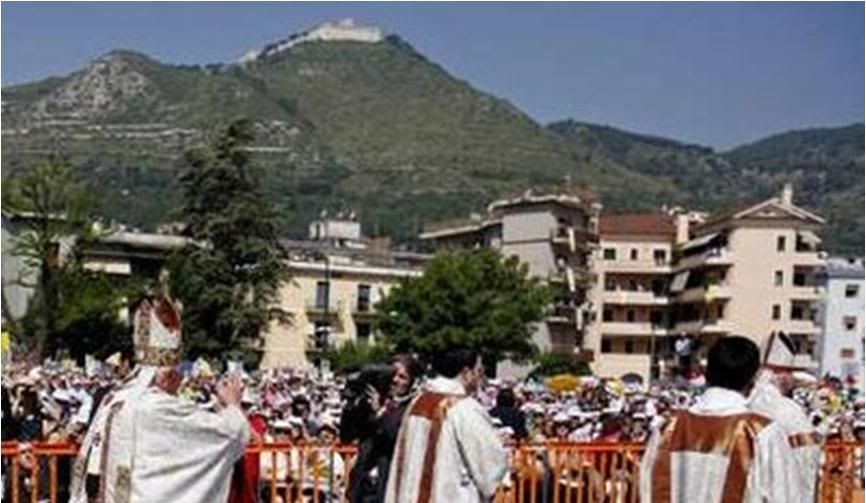 Pope prays For peace
Pope prays For peace
at site of WW2's largest
and bloodiest land battle

CASSINO, Italy, May 24 (Reuters) - Pope Benedict, visiting the scene of one of the bloodiest battles of World War Two, on Sunday prayed for an end to all violent conflict.
The Pope celebrated Mass for thousands of people at the foot of the Benedictine Abbey at Montecassino, which was destroyed in 1944 by Allied bombs and later rebuilt.
"In this place, where so many lost their lives in the battles that were fought during the Second World War, we pray especially for the souls of the fallen, commending them to God's infinite mercy, and we pray for an end to the wars that continue to afflict our world," he said at the end of the Mass.
The abbey was founded by St Benedict, whose name the former Cardinal Joseph Ratzinger took when he was elected Pope in 2005.
The battle of Montecassino, also known as the Battle for Rome, was one of the most complex and bloody of World War Two.
It lasted for nearly four months in early 1944 as Allied forces tried to penetrate Germany's Gustav Line to take Rome, resulting in 300,000 casualties on both sides.
Tens of thousands of soldiers were killed before the Allies broke through and captured the Italian capital as the Germans retreated north.
In his sermon, the Pope said the military cemeteries that dot the area were "silent witnesses" to suffering.
The battle saw the much-criticised destruction of the massive hilltop abbey by Allied bombing on Feb. 15, 1944.
The Allies had wrongly believed the Germans were using the site, founded by St Benedict in about 529, as a lookout.
The monastery had been standing for some 700 years. It took more than a decade to rebuild it after the war [completely at the expense of the italian government}.
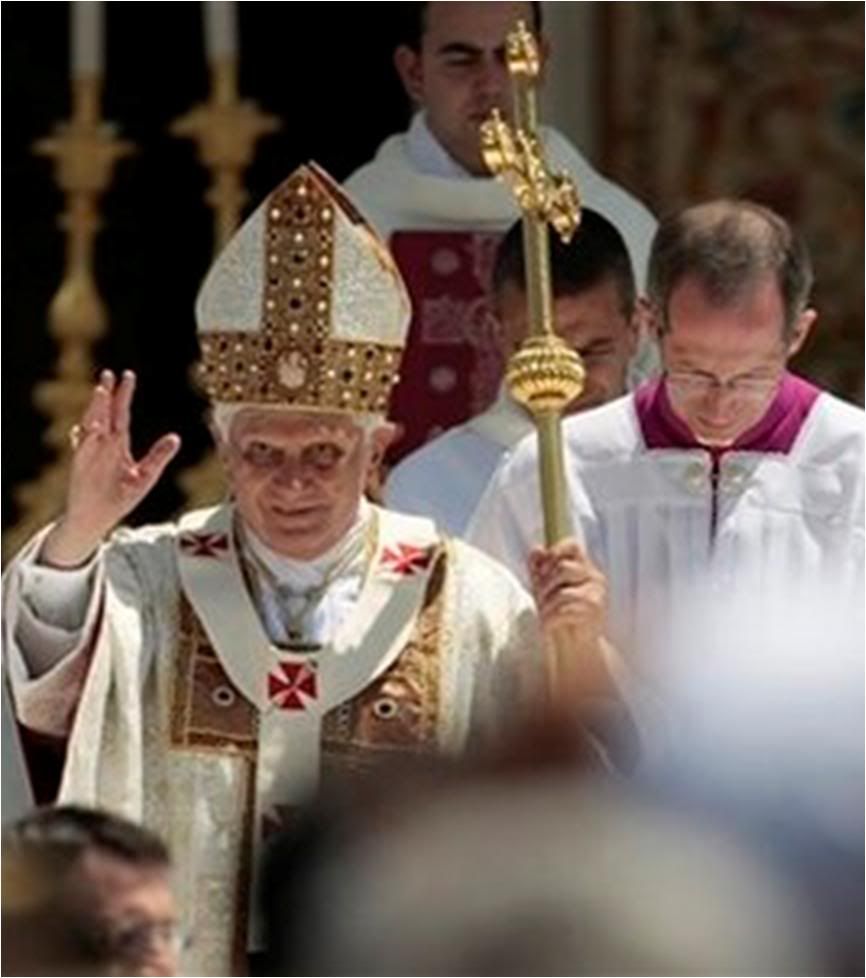
[Modificato da TERESA BENEDETTA 12/06/2009 03:07] |
| |
 01/06/2009 04:32 01/06/2009 04:32 |
|
| | | OFFLINE | | Post: 17.581
Post: 284 | Registrato il: 28/08/2005
Registrato il: 20/01/2009 | Administratore | Utente Junior | |
|
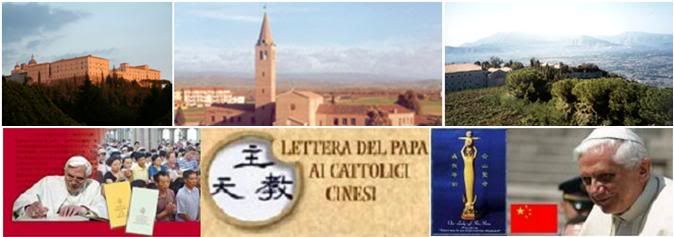 'From the land of St Benedict
'From the land of St Benedict
my thoughts go to the people of China
and its Catholics', says Pope

CASSINO, May 24 (AsiaNews) – Before reciting the Regina Caeli today Benedict XVI’s “thoughts” went to the people of China and his “affection” to the Catholics of China.
This is how the pontiff marked the World Day of Prayer for the Church in China, launched by him with the 2007 Letter to China’s Catholics, to take place each year on May 24th, the Feast of Our Lady Help of Christians, which is celebrated in a special way in the Marian Sanctuary of Sheshan in the foothills of Shanghai.
“Today May 24th – he said – the liturgical memory of the Blessed Virgin Help of Christians - who is venerated with great devotion in the Sanctuary of Sheshan, Shanghai - the World Day of Prayer for the Church in China is celebrated. My thoughts go to all the people of China,
"In particular I greet with great affection the Catholics in China, and I urge them on this day to renew their communion of faith in Christ and fidelity to the Successor of Saint Peter. May our common prayer obtain a spreading of the gifts of the Holy Spirit, so that unity between all Christians, the Catholicity and universality of the Church be ever deeper and more visible”.
Today’s Regina Caeli was proclaimed from Cassino (intoned and sung by the Pope), beneath the Benedictine Abbey of Montescassino, where the Pope is making a pastoral visit and where he celebrated Mass marking the feast of Our Lord’s Ascension.
During his homily the Pope underlined the contribution of Benedictine monasticism to the dignity of prayer, in the lectio divina, and to work.
"Saint Benedict was a great witness to peace", he said, "because he gathered it into his existence and saw it fruitfully multiply through works of authentic spiritual and cultural renewal. This is why, on the entrance to the Abbey of Montecassino, indeed on the entrance to every Benedictine monastery, the word PAX is emblazoned as a motto: the monastic community is indeed called to live according to this peace, which is the greatest gift of Easter”.
Then recalling his recent journey to the Holy Land – 'a land filled with tensions' – Benedict XVI stressed that “peace is firstly a gift from God, and therefore its strength lies in prayer”.
“It is however a gift entrusted to human commitment. The necessary energy to put it into practise is also found in prayer. That is why it is fundamental to cultivate an authentic life of prayer to insure social progress in peace.
"Once again the history of monasticism teaches us that the growth of all great civilisations is based on daily contemplation of the Word of God, which drives believers to a personal and common effort to fight against all forms of selfishness and injustice.
"Only through the grace of Christ, by learning to fight and win over the evil within ourselves and our relations with others, can we become authentic builders of peace and civil progress.
"May the Virgin Mary, Queen of Peace, help all Christians, in their varied vocations and situations of life to be witnesses of the peace, that Christ has gifted us and left us as our mission to be realised everywhere."
|
| |
 01/06/2009 04:35 01/06/2009 04:35 |
|
| | | OFFLINE | | Post: 17.582
Post: 285 | Registrato il: 28/08/2005
Registrato il: 20/01/2009 | Administratore | Utente Junior | |
|
 Benedict XVI and his namesakes.
Benedict XVI and his namesakes.
 Understanding Benedict
Understanding Benedict
By Andrew Sumereau

May 24, 2009
John Paul II, aside from his legacy as religious leader, is largely and correctly considered one of the political giants of the twentieth century. It is not too much to say that the Polish Pope, together with Ronald Reagan, changed the political history of half the world. Naturally his is successor is expected by many to have the same geopolitical influence on the world stage.
This is unfortunate and unfair. For if the world is still divided in 2009, as it was in 1978, between dark and light systems of governments and peoples, the scourge of the twenty-first century stems from a much less overtly political division.
The dangers of Muslim extremism and perils of moral relativism demand a more subtle but no less tenacious approach.
Yesterday was the eighty-ninth anniversary of the encyclical issued by Pope Benedict XV, Pacem, Dei Munus Pulcherrimum, (On Peace and Christian Reconciliation, May 23, 1920).
The 20th-century Pope Benedict, (one of the least remembered) was elected in September of 1914 and died in 1922. The First World War dominated his pontificate. As a consequence, he had important things to say about world peace. And although limited in scope, his work had a profound intellectual influence on the thoughts of the current Pontiff. The encyclical offers a compelling insight into the thoughts and actions of Benedict XVI.
It is widely accepted that a Pope chooses the name of a predecessor whose teachings and legacy he wishes to advance. Ratzinger's choice of "Benedict" was seen as a sign that Benedict XV's views on humanitarian diplomacy, and his stance against relativism and modernism, would be echoed during the reign of the new Pope.
In his first General Audience in St. Peter's Square on April 27, 2005, Pope Benedict XVI paid tribute to Benedict XV when explaining his choice: "Filled with sentiments of awe and thanksgiving, I wish to speak of why I chose the name Benedict. Firstly, I remember Pope Benedict XV, that courageous prophet of peace, who guided the Church through turbulent times of war. In his footsteps I place my ministry in the service of reconciliation and harmony between peoples." [The other attribution was for course St. Benedict.]
Written soon after the cataclysm of World War I, Benedict's encyclical anticipated and promoted the idea of a union of civilized nations dedicated to the preservation of peace, an authentic League of Nations, or United Nations, but very different from what eventually came to fruition.
In practical terms it called for a restoration of Christendom of an earlier day with distinct nation states and principalities united under a common ontological understanding.
The slaughter in Europe from 1914 to 1918 proved not only a scandal to supposedly Christian nations but also led to the transformation of boundaries and the emergence of numerous new states such as Poland, Lithuania, Estonia, Yugoslavia, Czeckslovakia, Finland, and others.
The Church administration had to deal with the new international systems that had emerged, by right-wing nationalism and fascism and left-wing socialism and communism. To deal with these issues, Benedict engaged a large scale diplomatic offensive to secure the rights of the faithful in all countries.
The idea of collective security as a solution to international conflict has gone in and out of fashion over the last bloody century. Ententes, Alliances, Pacts, Treaties, and Hot and Cold Wars have thrown the subject into every light possible, appearing prophetically wise at certain times and incredulously foolish at others. But while hindsight is clear, the task at hand as petitioned in the encyclical was formidable and divinely inspired as a call to action
" ...It is much to be desired, Venerable Brethren, that all States, putting aside mutual suspicion, should unite in one league, or rather a sort of family of peoples, calculated both to maintain their own independence and safeguard the order of human society."
The Encyclical refers to the tradition of the City of God and City of Man as expounded by the great Doctors of the Church.
St. Augustine well says: "This celestial city, in its life here on earth, calls to itself citizens of every nation, and forms out of all the peoples one varied society; it is not harassed by differences in customs, laws and institutions, which serve to attainment or the maintenance of peace on earth; it neither rends nor destroys anything but rather guards all and adapts itself to all; however these things may vary among the nations, they are all directed to the same end of peace on earth as long as they do not hinder the exercise of religion, which teaches the worship of the true supreme God."
Benedict XVI has just completed a tour of the Holy Land, with all the predictable accompanying criticism and controversy. Pundits and observers of all persuasions reveal once again their misunderstanding of his goals and methods.
The 2000 year-old Church does not bear in mind the last news cycle or consult the latest polls. Whether Benedict XVI evinced sufficient empathy for a given group or used the correct number of words and weight to a given subject is fodder for the daily press but really inconsequential in the scope of his responsibilities.
To expect Benedict to react to the "crisis" of the day like an always-campaigning politician is to completely misconstrue his purpose, his mission and, not the least distinctive in this case, his temperament.
Despite relentless pressure, the points of doctrine and dogma are settled, and will not progress with the latest fashion. Benedict's world-view is informed by the Gospel message. The Church's mission remains the same: being in, but not of, the world, to spread the Good News and save immortal souls. All other goals remain secondary in importance.
The Church, born during the rein of Caesar Augustus and having seen every political system imaginable, recognizes that the source of evil and war resides not in systems and organizations but in the human heart.
Despite the ludicrous assumptions of much of the press, Ratzinger of Munich does not need a lecture on the evils of fascism.
Without illusions, Benedict presents a consistent view of metaphysics engaged in life, a celestial Realpolitik foreign to the modern mind but comprehensible to human nature.
To both Benedict XV and Benedict XVI, the Church immutable is the Church at its best The Church triumphant. The world outside the Church benefits - politically, socially, morally, as a result.
American Thinker is a daily internet publication devoted to the thoughtful exploration of issues of importance to Americans. It adds that "the right to exist and the survival of the State of Israel are of great importance to us".
|
| |
 01/06/2009 04:37 01/06/2009 04:37 |
|
| | | OFFLINE | | Post: 17.583
Post: 286 | Registrato il: 28/08/2005
Registrato il: 20/01/2009 | Administratore | Utente Junior | |
|
 THE HOLY FATHER'S HOMILY
THE HOLY FATHER'S HOMILY
Ascension Sunday Mass
Cassino
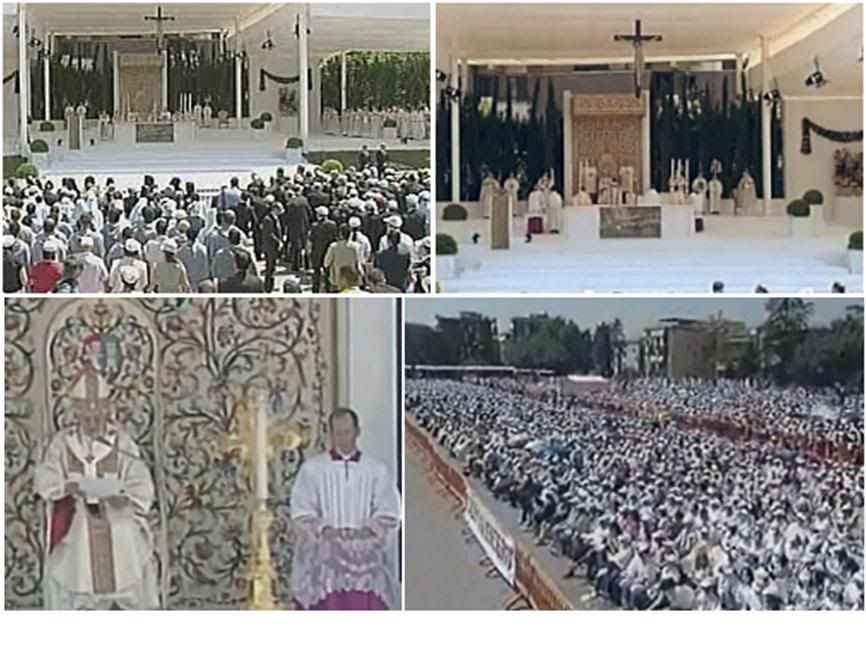 Here is a translation of the Holy Father's homily at the Mass in Cassino today (5/24)
Here is a translation of the Holy Father's homily at the Mass in Cassino today (5/24):
Dear brothers and sisters!
"You will receive power when the holy Spirit comes upon you, and you will be my witnesses in Jerusalem, throughout Judea and Samaria, and to the ends of the earth" (Acts 1,8).
With these words, Jesus bid farewell to the Apostles, as we heard in the first Reading. Shortly afterwards, the sacred author adds, "as they were looking on, he was lifted up, and a cloud took him from their sight" (Acts 1,9).
This is the mystery of the Ascension, which we solemnly celebrate today. But what do the Bible and the liturgy intend to communicate to us by saying that Jesus 'was lifted up'?
The sense of this expression can be understood not on the basis of a single text, nor even a single book of the New Testament, but in attentive listening to all of Sacred Scripture.
The word 'lift' is used in the Old Testament sense, which means installation into kingship. Thus the Ascension of Christ means, in the first place, the installation or seating of the Som of man, crucified and resurrected, in the kingship of God over the world.
There is, however, a more profound sense that is not immediately perceptible. In the pages of the Acts of the Apostles, it is said first that Jesus 'was lifted up" (v. 9), and then it is added that he was 'taken into heaven' (v. 11).
The event is described not as a voyage upward, but rather an action of God's power, which introduces Jesus into the space of proximity to the divine.
The presence of the cloud that 'took him from their sight' (v. 9) recalls a very old image of Old Testament theology, and inserts the story of the Ascension in the story of God with Israel, from the cloud on Sinai and over the tent of the Covenant in the desert, to the luminous cloud on the Mount of Transfiguration.
To present the Lord enwrapped in the clouds conclusively evokes the same mystery expressed in the symbolism of 'to sit at the right hand of God'. In the Christ who has ascended to heaven, the human being entered in an unprecedented and new way into intimacy with God - from then on, man always finds space with God.
'Heaven' does not indicate a place beyond the stars, but something much more daring and sublime - it means Christ himself, the divine Person who accompanies mankind totally and for always, him in whom God and man are forever inseparably united.
And we approach heaven, or rather, we enter heaven, to the degree that we get close to Jesus and enter into communion with him. That is why the solemnity of the Ascension invites us to a profound communion with Jesus who died and resurrected, and is invisibly present in the life of each of us.
In this perspective, we can understand why the evangelist Luke affirms that after the Ascension, the disciples returned to Jerusalem 'full of joy" (24.52). The cause of their joy was the fact that what had happened was not at all a separation. Rather, they now had the certainty that the Crucified and Risen Lord was alive, and that in him, the doors to eternal life were opened for always to mankind.
In other words, his Ascension did not mean his temporary absence from the world, but rather, it inaugurated the new, definitive and insuppressible form of his presence, by virtue of his participation in the kingly power of God.
It would fall on them, the apostles, made daring by the power of the Holy Spirit, to make this presence perceptible by their witness, by preaching and by missionary commitment.
The solemnity of the Ascension of the Lord should fill us, too, with serenity and enthusiasm, just as it did for the Apostles who left the Mount of Olives "full of joy".
Like them, we too, accepting the invitation of 'the two men dressed in white', should not remain gazing at the heavens, but rather, under the guidance of the Holy Spirit, we should go out and proclaim the salvific message of Christ's death and resurrection.
His own words, which close the Gospel according to Matthew, remain with us to comfort us: "And behold, I am with you always, until the end of time" (Mt 28, 19).
Dear brothers and sisters, the historical character of the mystery of Christ's Resurrection and Ascension helps us to recognize and understand the transcendental and eschatological condition of the Church, which was not born and does not live as a substitute for the absence of its 'departed' Lord. Rather, it finds its reason for being and its mission in the invisible presence of Jesus operating through the power of his Spirit.
In other words, we can say that the Church does not have the function of preparing for the return of an 'absent' Jesus, but on the contrary, it lives and operates in order to proclaim the 'glorious presence' in a historic and existential manner.
From the day of the Ascension, every Christian community advances its earthly itinerary towards the fulfillment of the Messianic promises, fed by the Word of God and nourished by the Body and Blood of the Lord.
This is the condition of the Church - the second Vatican Council reminds us - as it 'pursues its pilgrimage between the persecutions of the world and the consolations of God, announcing the passion and death of the Lord until he comes again" (Lumen gentium, 8).
Brothers and sisters of this beloved diocesan community, today's solemnity exhorts us to firm up anew our faith in the real presence of Jesus: without him, we cannot achieve anything effective in our life and in our apostolate.
It is he, as the Apostle Paul reminds us in the second Reading, who "gave some as apostles, others as prophets, others as evangelists, others as pastors and teachers, to equip the holy ones for the work of ministry, for building up the body of Christ", namely, the Church.
And this, in order "to attain to the unity of faith and knowledge of the Son of God", since it is the common calling of all to form "one body and one spirit, just as there is only one hope to which we are called".
It is in this light that my visit today must be seen, which, as your bishop recalled, has the purpose of encouraging you to constantly 'construct, found and rebuild' your diocesan community on Christ.
How? It is shown to us by St, Benedict himself who recommends in his Rule not to place anything ahead of Christ - "Christo nihil omnino praeponere" (LXII,11).
Thus I give thanks to God for the good that your community is realizing under the leadership of your Pastor, Father Abbot Dom Pietro Vittorelli, whom I greet with affection and whom I thank for the kind words that he addressed to me in the name of everyone.
With him I greet the monastic community, the bishops, priests, and religious present. I greet the civilian and military authorities, beginning with the Mayor whom I thank for his words of welcome upon my arrival in this Piazza Miranda - which will now carry my name, unworthy as I am of the honor.
I greet the catechists, the pastoral workers, the youth and those who in various ways attend to spreading the Gospel in this land that is so laden with history, which underwent great suffering during the Second World War.
Silent testimony to this are the many cemeteries that surround your resurrected city, among which are the Polish, the German and the Commonwealth cemeteries.
Finally, I greet all the residents of Cassino and nearby centers. To each one, especially to the sick and to the suffering, I extend assurances of my affection and prayer.
Dear brothers and sisters, we can hear resounding in our celebration the appeal of St. Benedict to keep our hearts fixed on Christ, not to put anything ahead of him. This does not distract us, but on the contrary, it impels us even more to commit ourselves to building a society in which solidarity is expressed in concrete signs.
How? Benedictine spirituality, which is well known to you, offers an evangelical program synthesized in the motto, 'Ora, labora et lege' - prayer, work, culture.
But above all prayer, which is the most beautiful legacy left by St. Benedict to his monks, and also to your local Church: to your clergy, largely formed in the diocesan seminary which for centuries was seated in the Abbey of Montecassino itself; to the seminarians; to all those who were educated in Benedictine schools and 'recreatories' and in your parishes; to all of you who live in this land.
Lifting up your eyes from every town and district in the diocese, you can all admire that constant reminder of heaven that is the monastery of Montecassino, to which you climb in procession every year on the vigil of Pentecost.
Prayer, to which every morning the bell of St. Benedict with its solemn peal calls the monks, is the silent path which leads us directly to the heart of God. It is the breath of the soul which gives us back peace in the tempest of life.
Moreover, in the school of St. Benedict, the monks have always cultivated a special love for the Word of God in lectio divina, which has now become a common patrimony for many.
I know that your diocesan Church, adapting the guidelines of the Italian bishops' conference, dedicates great attention to developing a deeper acquaintance with the Bible, and has even inaugurated an itinerary to study Sacred Scriptures, which is dedicated this year to the evangelist Mark, and which will continue over the next four years, and God willing, conclude with a pilgrimage to the Holy Land.
May careful attention to the divine Word nourish your prayers and make you prophets of truth and love in a concerted commitment to evangelization and human promotion.
Another hinge of Benedictine spirituality is work. To humanize the world of labor is typical of the spirit of monasticism, and this, too, is the effort of your Community in seeking to be at the side of the numerous workers of the major industry present in Cassino and the businesses linked to it.
I know how critical the situation is for so many workers. I express my solidarity to all who are expereincing job precariousness, to those workers who are in 'cassa integrazione' [a form of unemployment insurance that tides the worker over until he can be rehired in his old job]] or who have been dismissed outright.
May the consequences of unemployment that afflict this region lead the responsible people in public authority, the entrepreneurs and others who are in a position to do so, to find valid solutions, with the contribution of everyone, to this job crisis, creating new jobs that can help safeguard families.
In this regard, how can we not recall that the family today has an urgent need to be better protected since it is being undermined strongly in the very roots of the institution?
I think likewise of the young people who find it difficult to get worthy employment that can allow them to start a family. To them, I wish to say: Do not be discouraged, dear friends - the Church will not abandon you.
I know that at least 25 young people from your diocese took part in the last World Youth Day in Sydney. Drawing on that extraordinary spiritual experience, be the evangelical leaven among your friends and contemporaries. With the power of the Holy Spirit, be the new missionaries in this, the land of St. Benedict.
Finally, your tradition also encompasses attention to the world of culture and education. The famous Archive and Library of Montecassino
hold innumerable testimonies of the efforts of so many men and women who have meditated and studied how to improve the spiritual and material life of mankind.
In your Abbey, one can touch with the hand that 'quaerere Deum', the search for God - that is, the fact that European culture has been a search for God and a willingness to listen to him. This is valid even in our time.
I know that you have been working in this spirit in the University and in your schools so that they may be laboratories of knowledge, of research, of passion for the future of the new generations.
I also know that in preparation for my visit, you had a recent convocation on education in order to arouse in all concerned an active determination to transmit to the young those irrenunciable values of our human and Christian patrimony.
In the cultural efforts today to create a new humanism, you rightly intend, faithful to the Benedictine tradition, to emphasize attention to those who are fragile and weak, to disabled persons and to new immigrants.
And I am grateful that you are giving me the occasion to inaugurate today the Casa della Carita, where a culture solicitous of life is being built with solid reality.
Dear brothers and sisters, it is not difficult to perceive that your community, this part of the Church which lives around Montecassino, is the heir and repository of the mission, impregnated with the spirit of St. Benedict, to proclaim that in this life, no one and nothing should be in first place ahead of Christ - and that is, the mission of constructing, in the name of Christ, a new humanity concerned with harboring and helping its weakest members.
May your patriarch and patron saint, with his sister St. Scholastica, help and accompany you. And may your patron saints protect you, especially Mary, Mother of the Church and Star of our hope. Amen.

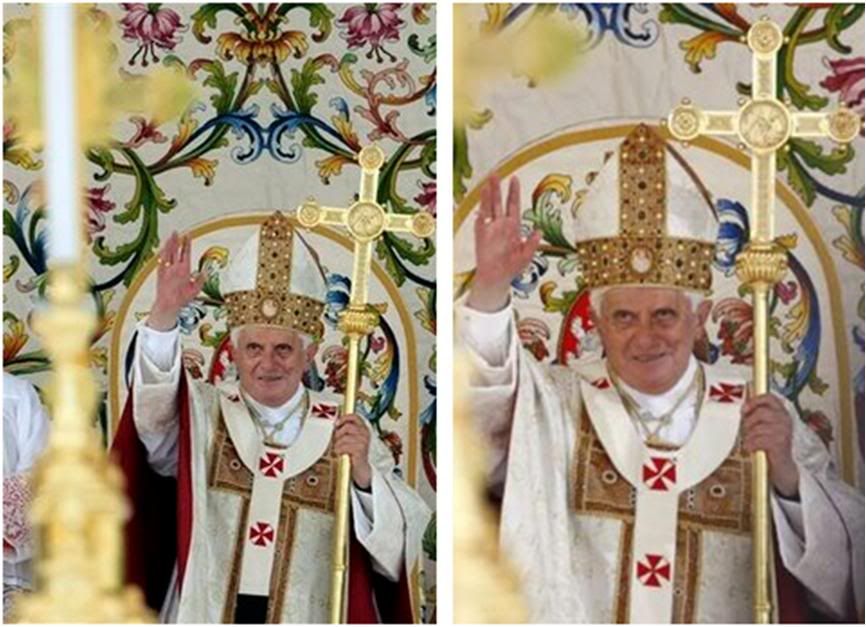 After the Mass, the Holy Father introduced the Regina Caeli prayers with these messages:
THE POPE'S MESSAGES
After the Mass, the Holy Father introduced the Regina Caeli prayers with these messages:
THE POPE'S MESSAGES
AT THE 'REGINA CAELI'
Dear brothers and sisters!
Every time we celebrate Holy Mass, we hear an necho in our hearts of the words Jesus left his disciples at the Last Supper as a precious gift: "Peace I leave with you; my peace I give to you" (Jn 14,27).
How much need the Christian community and all mankind have to taste fully the richness anx the power of Christ's peace! St. Benedict was a great witness to that, because he harbored it in his existence and he made it fruitful in works of authentic cultural adn spiritual renewal.
Because of this, the entrance to the Abbey of Montecassino and every other Benedictine monastery carries the word PAX: indeed, the monastic community is called to live in that peace which is the Paschal gift par excellence.
As you know, on my recent trip to the Holy Land, I considered myself a pilgrim for peace, and today, in ths land marked by the Beneditcitine charism, I have been given the occasion to underscore once more that peace is, in the first place, a gift from God, and therefore, its power is in prayer.
But it is a gift entrusted to human effort. The very energy necessary to realize it can be drawn from prayer. That is why it is fundamental to cultivate an authentic life of prayer to assure social progress in peace.
Once again, the history of monasticism teaches us that listening daily to the Word of God results in a great growth in civility, that it impels believers to personal and community effort to fight every form of selfishness and injustice.
By simply learning, with the grace of Christ, to fight and conquer the evil within ourselves and in our relations with others, we become authentic builders of peace and of civil progress.
May the Virgin Mary, Queen of Peace, help all Christians, in different vocations and life situations, to be witnesses to the peace that Christ has given us and left us as a demanding mission to realize everywhere.
Today, May 24, the liturgical commemoration of the Blessed Virgin Mary, Help of Christians - venerated with great devotion in the shrine of Sheshan near Shanghai - we observe the World DAy of Prayer for the Church in China.
My thoughts go to all the people of China. In particular, I greet with great affection the Catholics in China and call on them to renew on this day their communion of faith in Christ and fidelity to the Successor of Peter.
May our common prayer obtain an effusion of the gifts of the Holy Spirit so that unity among all Christians, as well as the catholicity and universality of the Church, may be ever more profound and visible.
In English, he said:
I greet the English-speaking pilgrims who have come here today to Monte Cassino.
From the heights of this mountain we contemplate with joy our risen and ascended Lord, who has taken his seat in heaven at the right hand of the Father. Where he has gone, we hope to follow.
In this place, where so many lost their lives in the battles that were fought during the Second World War, we pray especially for the souls of the fallen, commending them to God’s infinite mercy, and we pray for an end to the wars that continue to afflict our world.
May God pour out his blessings upon all of you and upon your loved ones at home.
At the end of his greeting in Italian, he said this:
On this Sunday, when we observe the World Day for Social communications, let us invoke Mary Help of Christians with filial confidence as we pray the Regina caeli.
 |
| |
 01/06/2009 04:39 01/06/2009 04:39 |
|
| | | OFFLINE | | Post: 17.584
Post: 287 | Registrato il: 28/08/2005
Registrato il: 20/01/2009 | Administratore | Utente Junior | |
|
 THE POPE IN MONTECASSINO - II
THE POPE IN MONTECASSINO - II
 At Casa della Carita
At Casa della Carita
After the Mass and Regina Caeli prayers, the Holy Father proceeded to the Casa della Carita, a project of the Benedictine Abbey with the support of the regional government of Lazio as a hospitality center for needy persons, particularly new immigrants and newly released prisoners who have no homes.
He was greeted by Pietro Marazzo, president of Lazio Region and by Mayor Bruno Scittarelli of Cassino. The Holy Father unveiled a marker for the event then he said a prayer and blessed the center.
[No pictures of the event so far.]
But here's a most unusual picture of the Popemobile - and its illustrious passenger - navigating the climb to the Abbey.
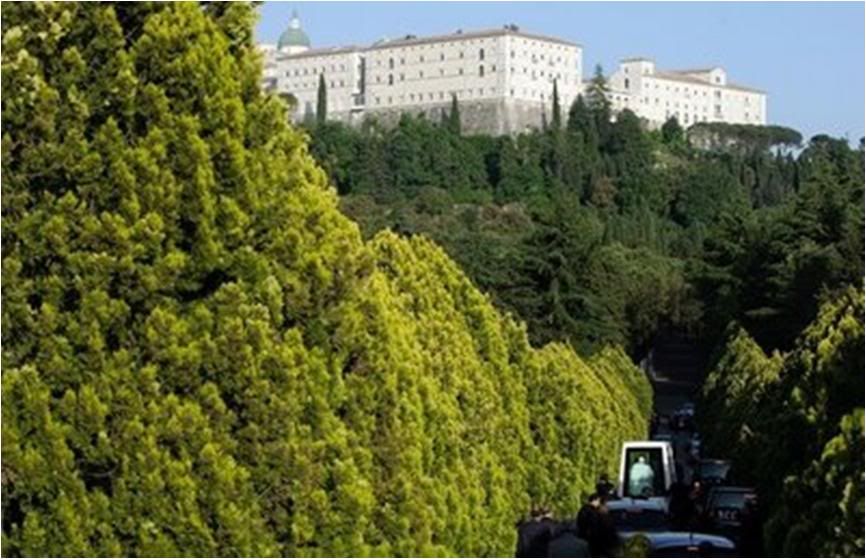 Lunch at the Abbey and
Lunch at the Abbey and
meeting with the Benedictine community
The Holy Father reached the Abbey at 1:30 and was greeted at the portal by Abbot Vittorelli with the rite of Washing the Hands according to the Rule of St. Benedict.
The Pope lunched and had a brief rest.
At 4:30, he met the monastic community of Montecassino as well as some of the organizers of the visit.
Then to the chanting of Laudes regiae, the Pope processed towards the Basilica of the Abbey for Vespers.
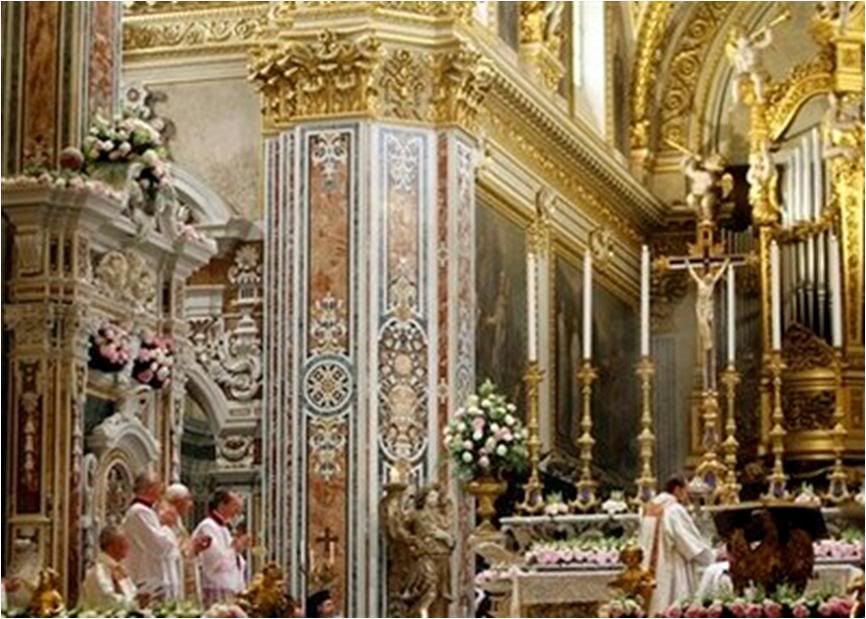 With great thanks to Caterina for her wonderful video-caps below, all the more appreciated because EWTN did not broadcast the Vespers n North America.
VESPERS AT THE ABBEY
With great thanks to Caterina for her wonderful video-caps below, all the more appreciated because EWTN did not broadcast the Vespers n North America.
VESPERS AT THE ABBEY
At 5 p.m., the Pope presided at the Celebration of Vespers with the participation of Benedictine abbots and abbesses from around the world along with the local Benedictine community.
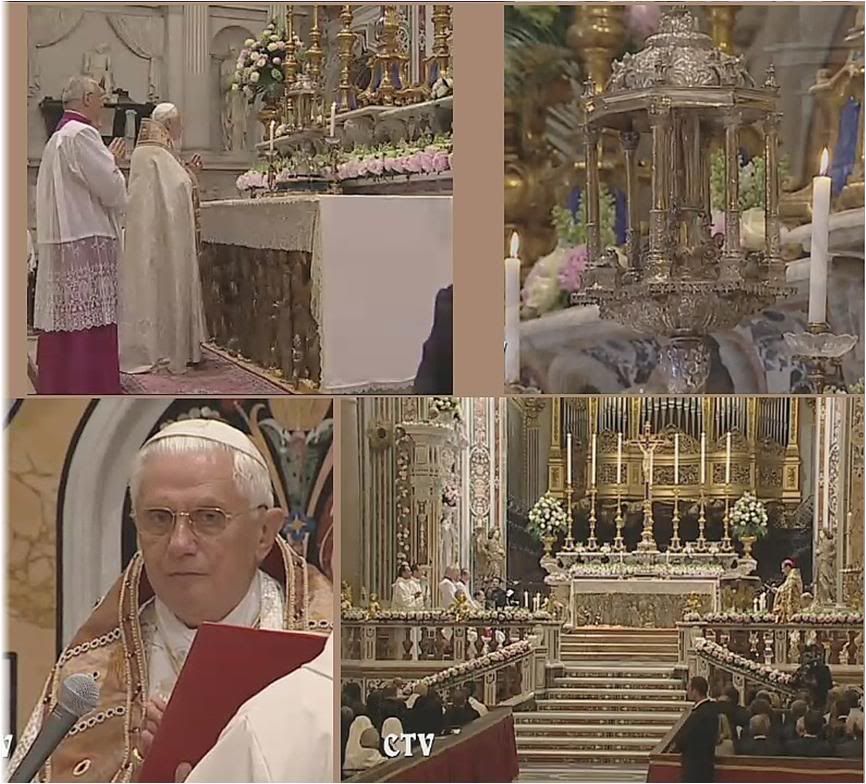
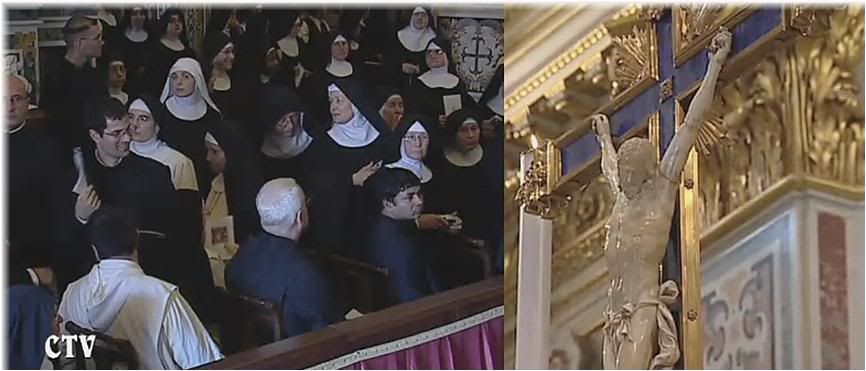
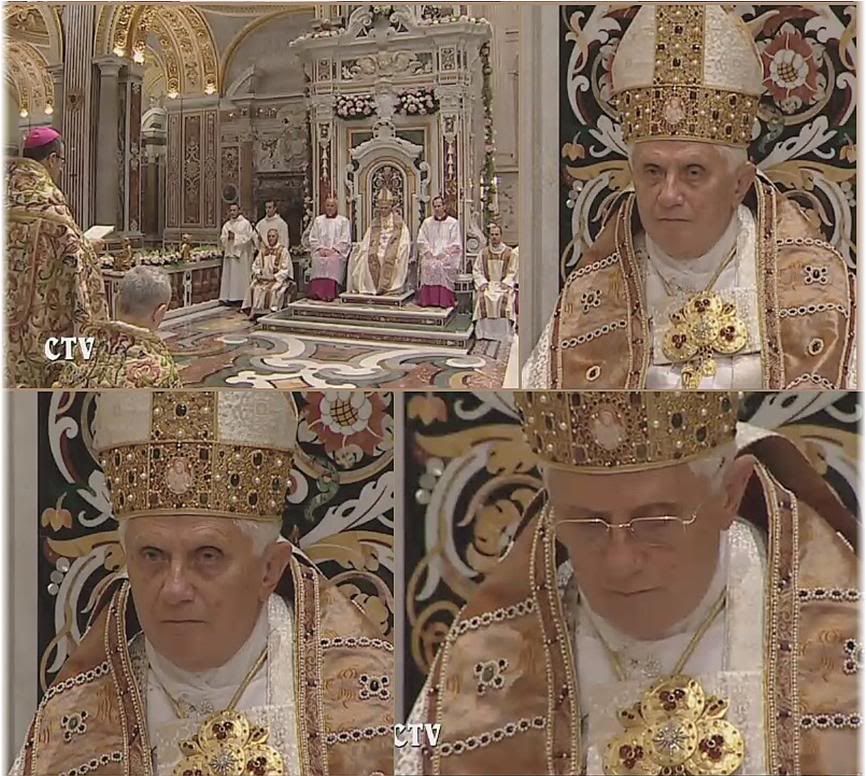
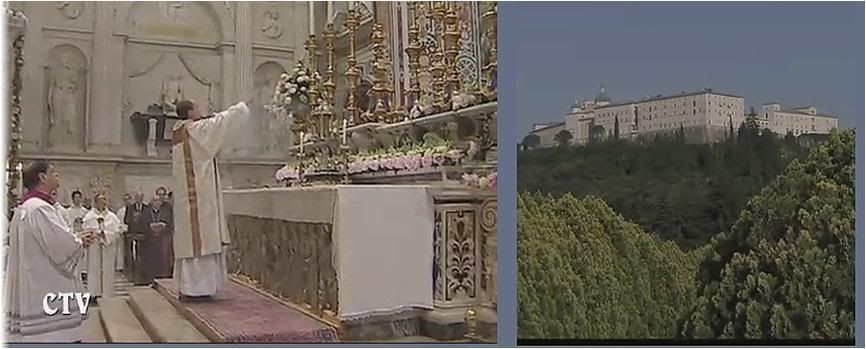
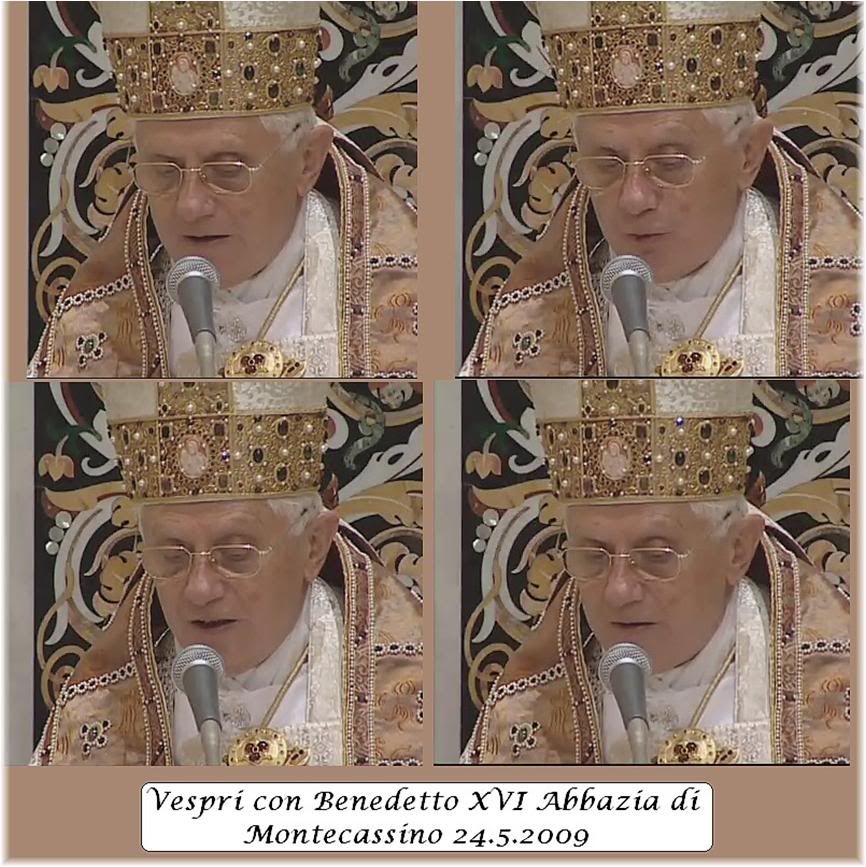 THE HOLY FATHER'S HOMILY
THE HOLY FATHER'S HOMILY
AT VESPERS
Dear brothers and sisters of the great Benedictine family!
Coming close to the end of my visit today, I am particularly pleased to be in this sacred place, in this Abbey that has deen destroyed and rebuilt four times, the last time after the bombardments of the Second World War 65 years ago.
“Succisa virescit” [When cut down, it grows again]: the words on its new coat of arms indicate its history well. Montecassino, like a centuries-old oak planted by St. Benedict, was 'stripped of leaves' by the violence of war, but rose again more vigorous than ever.
More than once I, too, had the occasion to enjoy the hospitality of the monks, and in this Abbey, I have spent unforgettable moments of quiet and prayer.
This evening, we entered here seeing the 'Laudes regiae' to celebrate Vespers together on the solemnity of the Ascension of Jesus. To each of you I express the joy of sharing this moment of prayer, greeting each of you with affection, thankful for the welcome that you have given me and those who are with me on this apostolic pilgrimage.
In particular, I greet the abbot, Dom Pietro Vittorelli, who expressed your common sentiments. I extend my greeting to the abbots, abbesses and the Benedictine communities who are present.
Today the liturgy invites us to contemplate the mystery of the Ascension of the Lord. In the brief reading taken from the First Letter of Peter, we are exhorted to fix our gaze on our Redeemer, who "died for our since once and for all" in order to lead us back to God, at whose right hand he is seated after "having gone into heaven, and is ... with angels, authorities, and powers subject to him" (1 Pt 3, 18.22).
'Lifted' and then having become invisible to the eyes of his disciples, Jesus nonetheless had not abandoned them: in fact, he was "put to death in the flesh, he was brought to life in the spirit" (1 Pt 3,18) - he is now present in a new way, interiorly in believers, and in him, salvation is offered to every human being regardless of race, language and culture.
The First Letter of Peter contains precise references to the fundamental Christological events of the Christian faith. The concern of the Apostle was to bring to light the universal importance of salvation in Christ.
We find an analogous concern in St. Paul, whose bimillennial birth anniversary we are celebrating, when he wrote to the community in Corinth: "He indeed died for all, so that those who live might no longer live for themselves but for him who for their sake died and was raised" (2 Cor 5,15).
No longer to live for oneself but for Christ: this is what gives full sense to the life of whoever allows hismelf to be conquered by him.
And this is manifested clearly in the human and spiritual experience of St. Benedict, who having abandoned everything, placed himself in a faithful following of Christ. Incarnating the Gospel in his own existence, he initiated a vast movement of spiritual and cultural rebirth in the West.
I wish to refer to an extraordinary event of his life, which his biographer St. Gregory the Great cites, and is certainly well known to you.
It can almost be said that the sainted Patriarch was 'lifted up' himself in an indescribable mystic experience. On the night of October 29, 540 - we read in the biography - while he was looking out the window "with eyes fixed on the stars as he entered into divine contemplation, the saint felt that his heart was on fire... For him, the starry firmament was like an embroidered curtain that revealed the Holy of Holies. At a certain point, his soul felt transported to the other side of the veil to contemplate openly the face of Jesus who lives within an inaccessible light" (cfr A.I. Schuster, Storia di san Benedetto e dei suoi tempi, Ed. Abbazia di Viboldone, Milano, 1965, p. 11 e ss.).
Certainly, in a way analogous to what happened to Paul after his abduction into heaven, for St. Benedict, too, after such an extraordinary spiritual experience, a new life must have begun. If the vision was fleeting, the effects remained, and his very physiognomy, his biographers say, was changed by it: his face became always serene and his manner angelic, and although he still lived on earth, it was clear his heart was alrady in Paradise.
St. Benedict received this divine gift certainly not to satisfy his intellectual curiosity, but rather so that the charism with which God had gifted him would be able to reproduce in the monastery the life of heaven itself and re-establish the harmony of creation through contemplation and work.
Rightly, then, the Church venerates him as 'the eminent master of monastic life' and 'doctor of spiritual wisdom in the love of prayer and work', 'radiant leader of peoples in the light of the Gospel' who. "raised to heaven along a luminous road", teachges men of all times to seek God and the eternal riches prepared by him (cfr Preface of the Saint in the monastic supplement to the Roman Missal, 1980, 153).
Yes, Benedict wa a luminous example of sanctity, showing his monks the one great ideal, Christ. He was a teacher of civilizwation who, proposing a balanced and adequate vision of divine exigencies and man's ultimate ends, always kept in mind the needs and reasons of the heart, in order to teach and inspire an authentic and constant fraternity, so that in the overall complex of social relations, the goal may not be lost of that spiritual unity capable of constructing and nourishing peace for always.
It is not by chance that the word PAX welcomes pilgrims and visitors at the gates of this Abbey, reconstructed after the huge disaster of teh Second World War. These gates stand like a silent reminder to reject every form of violence in order to build the peace: in families, in communities, among peoples and in the entire human family.
St. Benedict invites every person who comes up this mountain to seek peace and to follow it -“inquire pacem et sequere eam (Ps. 33,14-15)” (The Rule of St. Benedict, Prolog, 17).
In his school, monasteries have become, in the course of centuries, fervent centers of dialog, of encounter and of a beneficial fusion among different peoples, unified by the evangelical culture of peace.
The monks have always known how to teach the art of peace by word and example, realizing concretely the three 'links' that Benedict indicates as necessary to conserve the unity of the Spirit among men: the Cross, which is the law of Christ himself; the book, and therefore culture; and the plow, which signifies labor, mastery over matter and time.
Thanks to the activity of the monasteries, articulated in the triple daily commitment to prayer, study and work, entire peoples of the European continent have known authentic rescue and a beneficial moral, spiritual and cultural development, educating themselves in the sense of continuity with the past, in concrete action for the common good, in an openness to God and the transcendent dimension.
Let us pray that Europe may always know how to value this patrimony of Christian principles and ideals which constitute an immense cultural and spiritual wealth.
But this is possible only if St. Benedict's constant teaching - 'quaerere Deum', to seek God - is accepted as man's fundamental commitment.
The human being will not fully realize himself, he cannot be truly happy, without God. It falls on you in particular, dear monks, to be living examples of this interior profound relation with him, carrying out without compromises the program that your founder synthesized as
“nihil amori Christi praeponere” - do not plsce anything ahead of the love of Christ (Rule 4,21).
This is what constitutes holiness, a proposition that is valid for every Christian, more than ever in our time, when one feels the necessity of anchoring life and history on firm spiritual ground. That is why, dear brothers and sisters, your vocation is more than ever relevant, and your mission as monks indispensable.
From this place, where his mortal remains repose, the Patron Saint of Europe continues to invite everyone to follow his work of evangelization and human promotion. I encoourage you, dear monks, to remain faithful, int he first plce, to the spirit of your beginnings and to be authentic interpreters of St. Benedict's program for spiritual and social renewal.
May the Lord grant you this gift, through the itnercession of your holy founder, of his sister St. Scholastica, and all the saints of the order.
And may the heavenly Mother of the Lord, whom we invoke today as the Help of Christians, watch over you and protect this Abbey and all your monasteries, along with the diocesan community that lives around Montecassino. Amen!
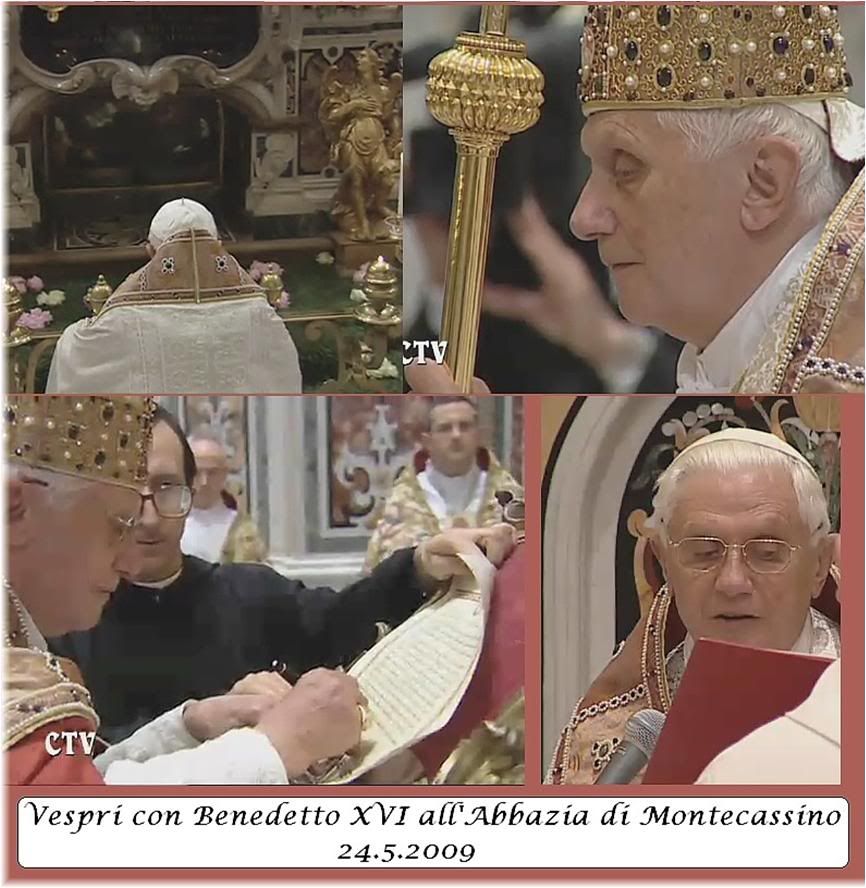
After Vespers, the Pope venerated the remains of St. Benedict and St. Scholastica who are buried behind the main altar of the Basilica.
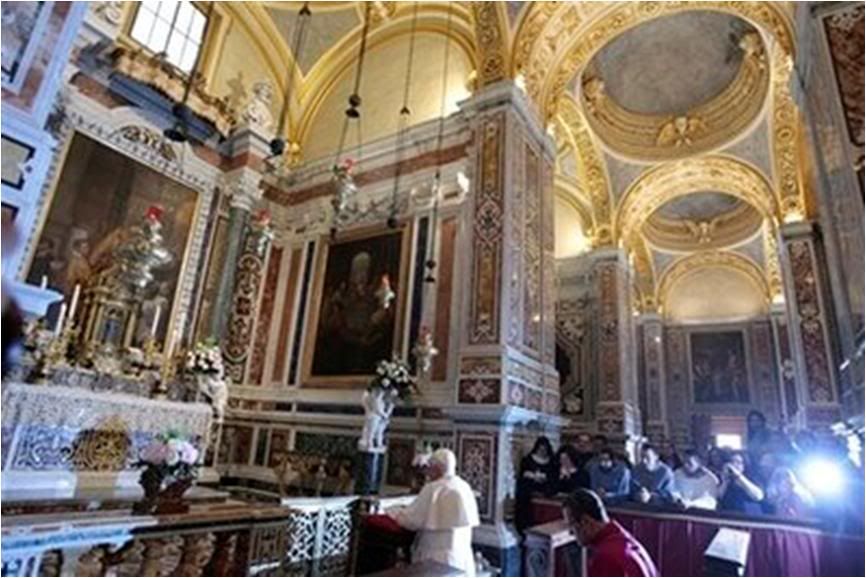 AT THE POLISH MILITARY CEMETERY
AT THE POLISH MILITARY CEMETERY
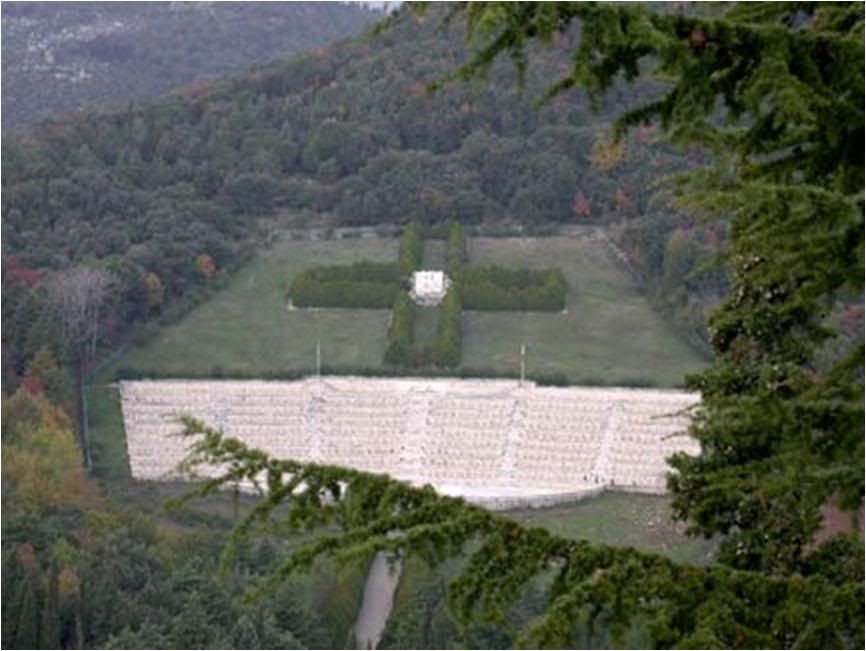 View of the Polish cemetery from the Abbey.[/C]
View of the Polish cemetery from the Abbey.[/C]
At 6 p.m., the Pope bade farewell the abbey through the so-called Loggia of Paradise to go by car to the Polish military cemetery nearby. In the central piazza, he lit a votive lamp and read a prayer for the fallen in all wars from all nations.
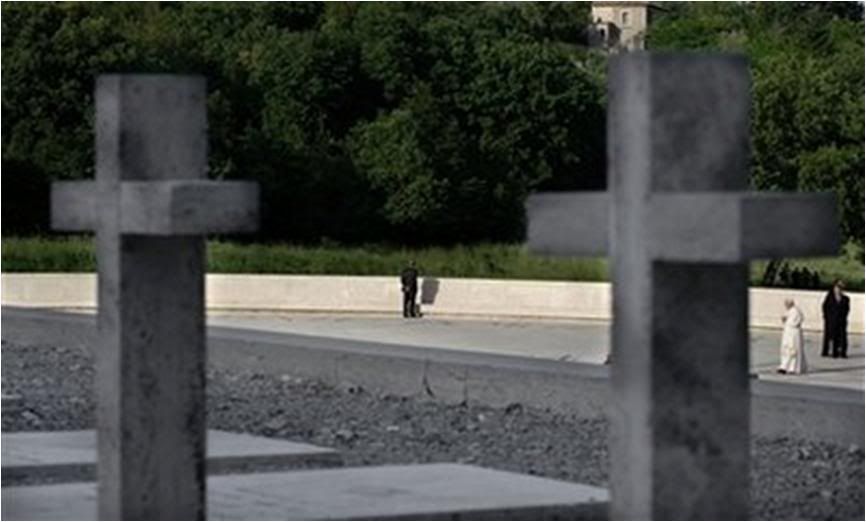

Here is a translation of the Pope's prayer:
O God, our Father,
inexhaustible source of life and peace,
welcome into your merciful embrace
thoese who fell in the war which raged here,
those who have fallen in every war
that has made the earth bloody.
Grant them to enjoy the light that never sets,
which, reflecting your radiance,
may enlighten the conscience
of every man and woman of good will.
You, who in your Son Jesus Christ
granted to suffering mankind
exalted proof of your love for us,
You who in Christ our Lord
set the sign of suffering that is never futile
but fruitful in its redeeming power -
Comfort those who suffer in the world
through the blind hate of fratricidal wars,
with the power of hope that never wanes,
the dream of a civilization of love
that is conclusively realized,
the courage for daily and real acts of peace.
Give us your Spirit Paraclete
so that men of our time may understand
that the gift of peace is more precious
than any other corruptible treasure,
and that while awaiting the day
on which the sun will never set,
we may all be called to be peacemakers
for the future of your children.
Make all Christians more convincing witnesses of life
as the inestimable gift of your love -
You who lives and reigns for ever and ever.
Amen .
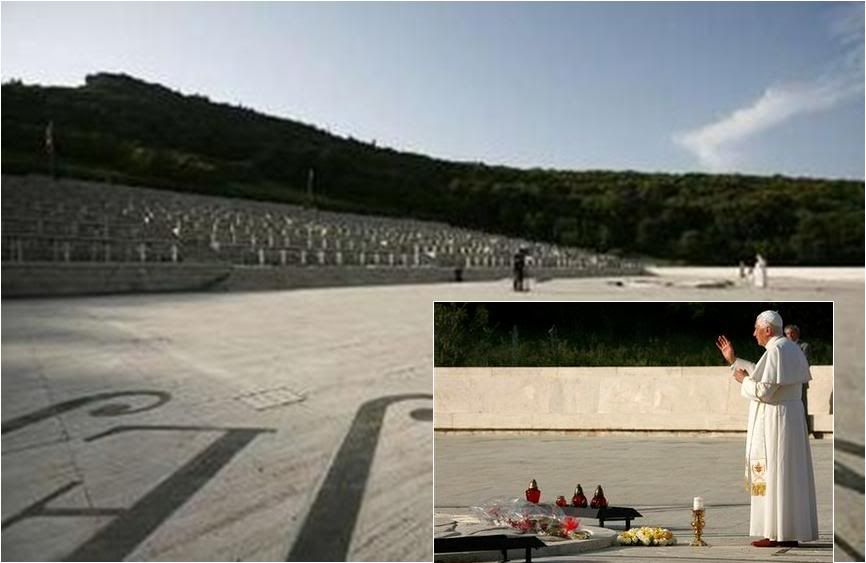
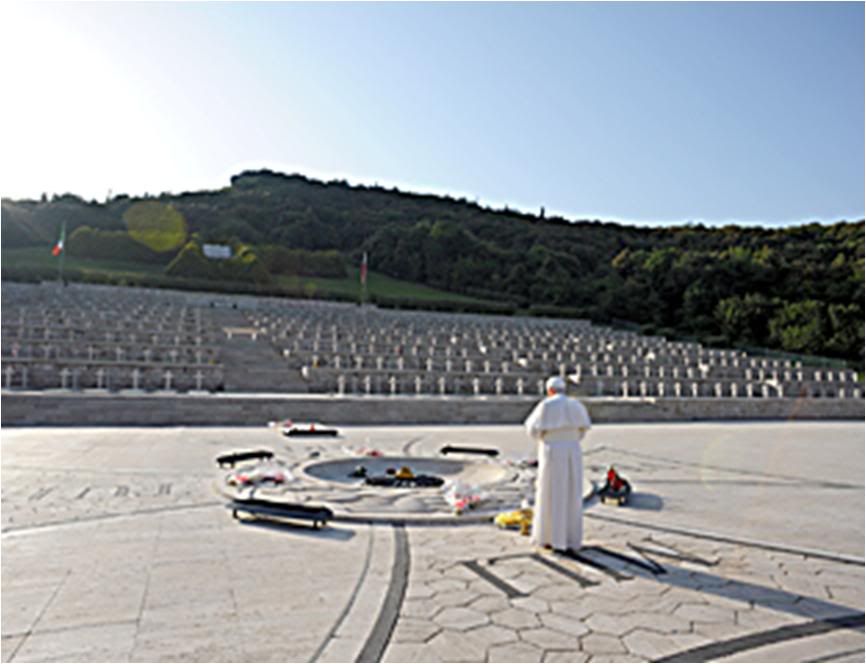
He then went back to the Peace Square of the Abbey where he bade farewell to all those who had welcomed him in the morning. He then flew back to Rome by helicopter.

5/25/09
Strangely, not enough attention has been given, even in the Italian media, to the significance of the Holy Fahter's visit and prayer at the Polish cemetery. He could have chosen to visit the German cemetery which, as he mentioned before the Regina Caeli prayer, is also in the area. But he chose to visit the resting place of the Polish soldiers who died fighting on the side of the Allies in 1944 against the German occupation forces in Italy.
Of course, his prayer was universal, for all those who have fallen in wars on any side, but not even the American wire services thought to link the Pope's gesture to Memorial Day which is observed today, the last Monday of May, in the United States and all its military cemeteries around the world.
And how very appropriate the Pope's prayer is for such a day of rememberance - which should not only be a pause to honor those who sacrificed their lives in war but to pray that all wars may end.
|
| |
 01/06/2009 04:41 01/06/2009 04:41 |
|
| | | OFFLINE | | Post: 17.585
Post: 288 | Registrato il: 28/08/2005
Registrato il: 20/01/2009 | Administratore | Utente Junior | |
|
 Why Benedict XVI sees
Why Benedict XVI sees
monastic life as an example
for those of waning faith
by VITTORIO MESSORI
Translated from

May 23, 2009
Why does a Bavarian Pope in the 21st century favor a Sabine monk of the 6th century so much as to take his name and consider him the patron of his Pontificate?
Why, among all the places which have been inviting him, has he chosen to visit Montecassino for a Sunday of 'full immersion' [English term is used in the original] in the Benedictine world?
Why was it, that just the day before the death of his beloved predecessor, he went to Subiaco - where the adventure of Western monasticism began - to lecture on what could have been a program of government?
To understand such attention, one must remember that the lucid theologian, the post-modern intellectual who has become a pastor of souls, has always had - now, more than ever - an obsessive concern: aboutthe weakening of the faith, of which he is both custodian and guarantor.
A faith, he recently wrote, "that appears to be dying out like a candle that has run out of wick'. Hence, the need to rediscover the reasons for believing, to reconfirm the reasonableness pf 'wagering' on the truth of the Gospel.
The enormous ecclesial edifice hangs in the balance (St. Paul's expression) on the historicity of an empty tomb in Jerusalem. If this certainty should waver at all, then nothing will remain.
Something has been taking place for decades that was very disturbing to Joseph Ratzinger as head of the Holy Office and disturbs him even more now as Benedict XVI.
And it is the fact that what remains of a Christianity mowed down by secularism has tended to transform itself into an international association of volunteers, a socially-committed non-profit organization
The love that the Gospel urges is understood only in the horizontal sense, which means the charity of giving bread and championing socio-political commitments for a more peaceful, just and less polluted society.
This, in effect, is the 'trinitarian; slogan proposed as the new Creed by the Ecumenical Council of the Churches of Geneva: "Peace, justice, and protecting creation".
Well then, behind this clearing away of the authentic Christian perspective - which has become 'horizontal' as a consequence of its 'verticality' in looking at the things of the earth because it believes in heaven - there is a crisis of faith which is the true and tragic problem of modern Christianity.
With hope dimmed in an eternal life in the hereafter, the survivors who continue to feel 'engaged' seek pacification in working for a better life in the present, and dedicate themselves to the tangible certainties of the here and now.
Faith in man and history has replaced faith in God and eternity - and the militant for good causes has replaced the praying man and the ascetic.
Christians (but without Jesus as Christ-God! - please let us not use gross words!] as philanthropists, volunteers, labor unionists, environmentalists, custodians of human rights...
It is a disquieting deformation that in the recent past, went through the clerico-Marxist stage and which has now assumed the robes of the new hegemonic ideology - that of political correctness, of Western liberal radicalism.
What is the point in adhering to dogmas and wasting time in prayer, when there is a world which can be saved thanks to human powers, of whatever Credo or lack thereof, provided it is well intended?
This trend was a cause of anguish for Paul VI, opposed by John Paul II's extraordinary mix of mysticism and concreteness, and for Benedict XVI, the absolute priority for intervention.
All the last Popes were well aware that - through the logic of the 'et-et' ['and-and', i.e., inclusive] which has always guided the Church and the rejection of every 'aut-aut' [either-or] - Christianity is called on to humanize the City of Man, but while believing in the heavenly Jerusalem, it is mired in the world, and while it prays, it concerns itself with mortal beings insofar as they are called to immortality.
A balancing act, a synthesis, that seems to be everything. The weakening of faith has unbalanced those who, even without explicitly refuting the Credo (noisy contestation has ended out of sheer exhaustion, a sense of irrelevance, or even out of dissimulation), do not think it is necessary to their actions in any way.
And even this - or perhaps, this above all - can explain the attention that even before he became Pope, Joseph Ratzinger has always had for monastic life.
A life that is absurd, insupportable, even inhuman. A life sentence -since one chooses for life - worse than that in public prisons: a renunciation of the family, abstention from sex, no personal property, eight hours of daily communal prayer in addition to prayer by oneself, nocturnal vigils, penances, frugal vegetarian fare interrupted by frequent fasting, heat and cold, prompt and absolute obedience, prohibition from going beyond cloister walls, rare news from the outside world and what there is, filtered through one's superiors, close living together that is continuous and has no term, with companions imposed on you - a hell, in short.
But a hell that can be turned into Paradise. If, and only if, one has a vision of faith that does not hesitate about the truth of the Gospel and its promises. A Paradise only for he who believes, without a doubt, that Jesus Christ is really who the Church announces him to be.
It's a vocation for only a few, certainly. In which one manifests a total, radical faith. That does not hesitate to push to extreme consequences, and of which Montecassino has been an illustrious example for 15 centuries.
The Benedictine shows with his very life that the flame of his candle has plenty of wick. Perhaps it is this light, so rare and precious, that Benedict XVI wishes to show us believers who are increasingly unbelieving, we who have kept of the monastic dualism only the 'labora', forgetting completely about the 'ora'.
Famous monk Popes
Gregory VII
Ildebrando of Soana (ca 1020) became Pope in 1073. He clashed with the Emperor Henry IV and died after the pillage of Rome (1084).
Urban II
Urban (ca. 1040–1099) was the Prior of teh Abbey of Cluny and one of the most active supporters of the Gregorian reforms. In 1086, he became the 159th Pope.
Celestine V
As a young man, he was a monk at the benedictine monastery of Santa Maria di Falfoli. Celestine (1215-1296) is venerated as a saint adn was the only Pope who ever abdicated. [The Pope Benedict XVI visited in L'Aquila after the earthquake].
And not a Pope:
Dom Pierre Perignon
The French monk (1639-1715), who invented champagne, according to legend, was the superintendent of the Abbey of St. Pierre d'Hautvillers.
|
| |
 01/06/2009 04:42 01/06/2009 04:42 |
|
| | | OFFLINE | | Post: 17.586
Post: 289 | Registrato il: 28/08/2005
Registrato il: 20/01/2009 | Administratore | Utente Junior | |
|
 Benedict's Europe:
Benedict's Europe:
Benedict XVI on St. Benedict
Editorial
by Mario Mauro
Vice President, Parliament of Europe, Strasbourg
Translated from

May 25, 2009
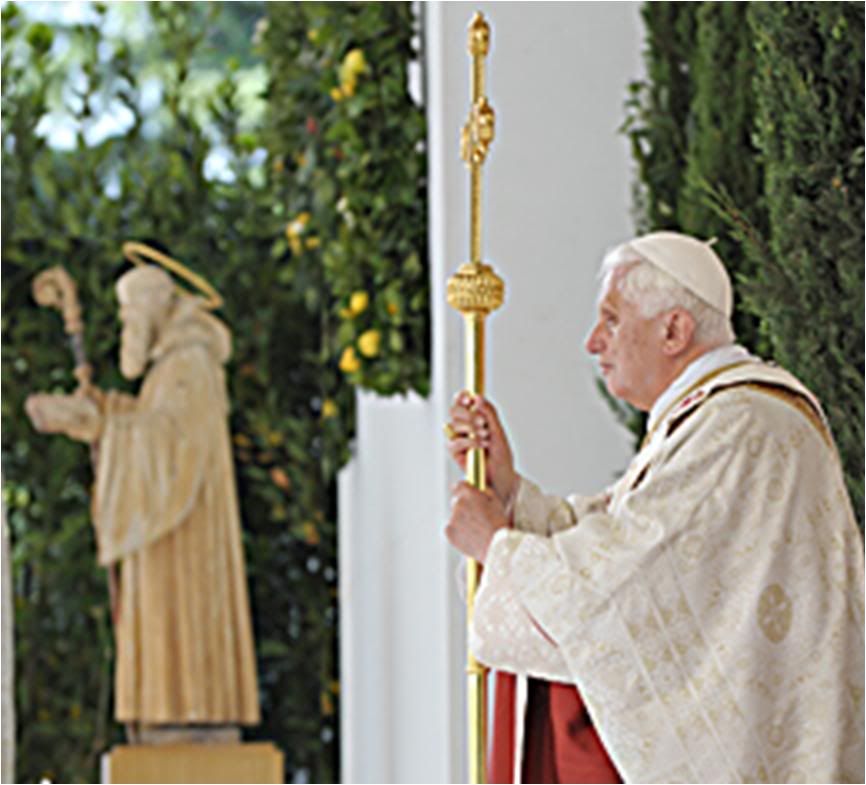
Benedict speaks about Benedict.
Four years after his famous 'Subiaco lecture' - when the then Cardinal Ratzinger presented his lectio magitralis on Europe - the Holy Father spoke again yssterday of St. Benedict of Norcia, exemplary figure and Patron Saint of Europe.
In the Abbey of Montecassino, the Pope cirted the symbols of the other Benedict - father of monasticism and proponent of evangelization on our continent - that could ideally represent today the bulwark to which our bimillennial tradition is anchored.
'Ora et labora', pray and work, the Benedictines said, and continue to say. And on this ocncept, the Pope wove a message that touches on the most relevant issues today.
Not a leab back to the past, but a lucid reflection on what is happening today. He expressed his solidarity with those who more than anyone else are paying the price imposed by the current financial crisis: those whose jobs are at risk, those who are already unemployed or have lost jobs,\, and the young people who cannot find work.
He called on responsible persons in government and in the private sector to "create new jobs and safeguard the family, which is strongly udnermined at the very roots of the institution".
Europe can find strategies to resolve the jobs emergency only if it is able to acknowledge its roots, because to create new job possibilities and overcome the present context of crisis, one must first of all fight against all forms of selfishness and seek to protect all families and young people.
St. Benedict, with a Rule made up of work, culture and prayer, contributed to bring Europe out of a period of profound crisis. The Pope has brought to our attention that this is a valid instance for dusting out a simple but effective strategy: to look at our roots and put together all the strength that we can in the same effort so that no one remains behind. [Ummmm... that's one of those well-meaning political statements that actually say nothing concrete.]
Human dignity indeed comes above all. It is for that dignity - that precisely in our continent has been trampled upon millions of times by the atrocities of ideologies - that institutions have been ready to fight for, somehow never getting the better but rather becoming their guarantors.
It is for this reason, in the memory of all the lives that wars have taken, that the Pope visited the Polish military cemetery in Montecassino, remembering all those who have fallen, from all nations and in all conflicts.
And what does all this have to do with Europe, its institutions and its citizens? Cannot faithfulness and acknowledgment of Christian roots contribute to building a Europe that is unified and fraternally solid in the search for justice and peace?
Perhaps, for those of us who have become accustomed to live in a climate devoid of civil or inter-cultural conflicts, the word 'peace' has acquired a meaning that we take for granted.
But there is a risk. If Europe is not capable of a historical memory that allows it to keep its cultural and religious tradition alive, then it cannot have a future. Shortsightedness never brings anyone far.
Europe has been truly herself and truly great in creating forms of authemtic civilization and progress for people on the universal level, only at those times when it has transmitted the constitutive values that come from the Christian faith after they had become part of the people's patrimony of culture and identity.
Unfortunately, recent history reminds us that institutions are not always capable of recognizing the progress they have made. And it is strange that Europe rejects any reference to its roots, whereas the United States, for exmaple, has never had a problem with relating to God.
Europe was born Christian and only to the degree that it remains Christian can it think of conserving its own idealism and its own original contribution to contemporary civilization.
To udnerstand this more profoundly, one must go back to the fourth century when, during the grave crisis of the Roman Empire, the Church started to develop as a new historical, cultural and political entity to reckon with.
Montecassino Abbey, which has been destroyed four times, and four times reconstructed, is the symbol of this Europe which, although it has been undermined several times at its very foundation, is still on its feet. It has survived wars, it has seen destruction, many times it has been brought to its knees, but today it is still firm and capable of assuring us and our children another 60 years of peace. It is for this reason that we should defend her in memory of St. Benedict.
The visit of Benedict XVI on the eve of an important accpintment that will involve the citizens of the 27 member states of the European Union should impel us to contineu along the path taken by the fathers of oru continent and to strive so that our young people above all may be guaranteed a future of peace and development.
|
| |
 01/06/2009 04:48 01/06/2009 04:48 |
|
| | | OFFLINE | | Post: 17.587
Post: 290 | Registrato il: 28/08/2005
Registrato il: 20/01/2009 | Administratore | Utente Junior | |
|
 The primacy of Christ
The primacy of Christ
Editorial
by Giovanni Maria Vian
Translated from
the 5/25-5/26 issue of

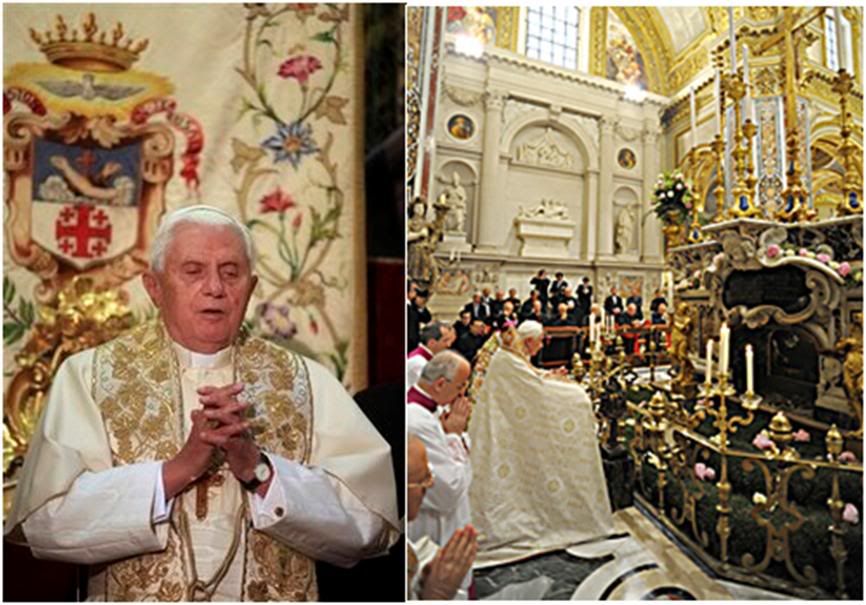
Benedict XVI returned to Montecassino, where he had been quite a few times beofre being elected to the Chair of Peter, in order to repeat yet again that nothing should be placed ahead of the love of Christ:
nihil amori Christi praeponere - according to that beautiful and essential expression of the Benedictine Rule which the new Pope in 2005 recalled to explain why he chose the name he took as the Roman Pontiff.
It is a name that augurs well, onr associated with peace, and that had not recurred in the papal succession for more than ninety years, and that the new Pope thus explained, above all, in reference to the absolute primacy of Christ.
This primacy is not an abstract concept, much less an ideology, but the consequence of an encounter - as the Pope affirms in his first encyclical - in the daily life of the Christian.
An encounter with Christ by Joseph Ratzinger, as by every other faithful believer, along the 'program' stated clearly at the start of his Pontificate: namely, "not to do my own will, not to pursue my own ideas, but to listen, together with the whole Church, to the word and the will of the Lord, to be guided by Him".
Through the search for God, that 'quaerere Deum' taught by the father of Western monasticism, and which Benedict XVI in Paris, in his memorable lecture at the College des Bernardins, had indicated as the origin of the culture that matured on the European continent.
The Benedictine program of never placing anything ahead of Christ is realized everyday in concrete acts. And in the rhythm of the monastic day, the Pope underscored, monastic life has an exemplary value for every believer, man or woman. Above all, in the space it reserves for prayer, 'the silent path' that leads to God, and therefore, a genuine 'breath for the soul".
Then comes work, a reality that is always difficult, and in this time of global crisis, a matter of concern and even anguish for individuals and families, as well as a question tied up with the issue of immigration.
And culture, which is never restricted in its areas of concern, also signifies - above all - education of the new generations and responsibility on their behalf. These are issues which, not by chance, are covered in the words today of the president of the Italian bishops conference [opening the annual general assembly of the CEI which continues till May 29].
Thus, to return to Montecassino was for Benedict XVI a fresh occasion to call attention the priorities of life. And to invoke peace yet again - rather, the gift of peace and the commitment to realize it - from a place of gentleness and civility which hadd been uselessly destroyed by the barbarism of modern wars, in that horrific tragedy with which Europe started its descent into the abyss some 70 years ago.
Because of this, Paul VI proclaimed St. Benedict, from Montecassino itself, to be the Patron of the Old Continent, symbolizing in the Cross, the plow and rteh book the centuries-long achievements of his monks. [The occasion was the inauguration of teh reconstructed Abbey in 1954.]
Thereby, he underscored the responsibility of Christians who must visibly bear witness to the profundity and efficacy of their roots. In Europe, in the global context, in the reasonable search for the common good.
|
| |
 01/06/2009 04:53 01/06/2009 04:53 |
|
| | | OFFLINE | | Post: 17.588
Post: 291 | Registrato il: 28/08/2005
Registrato il: 20/01/2009 | Administratore | Utente Junior | |
|

OR for 5/25-5/26.
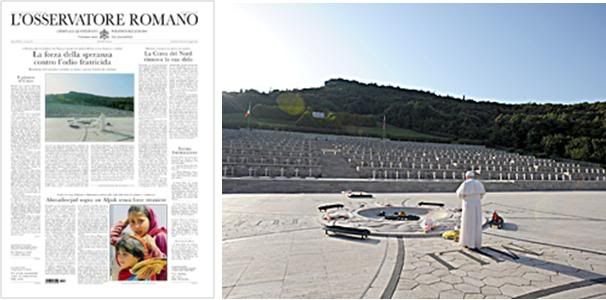
At Montecassino, the Pope prays for all who suffer from wars and violence:
'The power of hope against fratricidal hatred'
Benedict XVI remembers the Catholics in China and calls again for unity among Christians

 The issue is devoted to a full coverage of the Pope's pastoral visit to Montecassino on Sunday.
The issue is devoted to a full coverage of the Pope's pastoral visit to Montecassino on Sunday.
[Modificato da TERESA BENEDETTA 01/06/2009 04:53] |
| |
 01/06/2009 04:56 01/06/2009 04:56 |
|
| | | OFFLINE | | Post: 17.589
Post: 292 | Registrato il: 28/08/2005
Registrato il: 20/01/2009 | Administratore | Utente Junior | |
|
 Here's a belated translation of a beautiful OR article on 5/24/09:
In the patron Saint of Europe,
Here's a belated translation of a beautiful OR article on 5/24/09:
In the patron Saint of Europe,
the roots of Benedict XVI's Pontificate:
The inseparable link
between obedience and freedom
by Mariano Dell'Omo, OSB
Vice-Archivist of the Abbey of Montecassino
Translated from the
5/24/09 issue of

To whoever did not know the long spiritual and human itinerary of Cardinal Joseph Ratzinger, the choice of the name Benedict when he was elected Pope that Roman afternoon of April 19, 2005 - before he later explained its genesis with his usual clarity - would have seemed singular if not extraordinary.
One simply has to look through the volume of his memoir La mia vita: Ricordi 1927-1977 [My Life: Memoirs 1927-1077, published in English as Milestones], to see early on, even in the boy Joseph, that interior landscape which would lead him much later, once elected Pope, to choose the name of Benedict, the sainted founder of Montecassino and father of Western monasticism.
The space of liturgy indeed fascinated the boy Ratzinger: "This mysterious fabric of texts and actions had grown from the faith of the Church over centuries. It bore the whole weight of history within itself, and yet, at the same time, it was much more than the product of human history", he writes in that memoir.
This world became familiar to him, thanks to the mediation of a Benedictine monk, Anselm Schott, of Beuron Abbey, who had published a missal in German with commentary intended to make the Mass understandable to an audience as simple and intuitive as children.
The cardinal recalled how he had received as a gift "a Schott for children in which the liturgy's basic texts were printed. Then I got a Schott for Sundays, which contained the complete liturgy for Sundays and feast days. Finally, I received the complete missal for every day of the year. Every new step into the liturgy was a great event for me. Each new book I was given was something precious to me, and I could not dream of anything more beautiful".
This is the Opus Dei, the work of God, in praise of him, which plays a privileged and primary role in the life of a Benedictine monk, always mindful of that which St. Benedict states in his Rule (43,3):
Nihil Operi Dei praeponatur [Place nothing ahead of the Work of God - a restatement of the more famous, Place nothing ahead of Christ's love].
Highly significant is the fact that Benedict adapts the same syntagma 'nihil praeponere' only in one other context, when he states apodictically the primacy of Christ in the life of the monk (4.21).
Liturgical prayer as Opus Dei, Work of God, is the space in which Christ is present in a triple way, according to the well-known thought of St. Augustine which so pervades that of St. Benedict: "The only savior of the mystical body, our Lord Jesus Christ, Son of god, is he who prays for us, who prays in us, and whom we pray to. He prays for us as our priest; he prays in us as our head; and we pray to him as our God"(Expositio in psalmos, 85, 1).
One then understands why Cardinal Ratzinger wrote what he did, on the crest of his childhood memories, about that Benedictine echo with which he would more and more harmonize his experience as a priest, as a bishop, and finally as Pope: "The inexhaustible reality of the Catholic liturgy has accompanied me through all phases of life, and so I shall have to speak of it time and again".
Moreover, the infancy and adolescence of the future Pontiff took place in an environment particularly characterized by a Benedictine imprint - and therefore, by its liturgical culture - as he recalls Traunstein, the little town where he lived at the Austrian border, just 30 kilometers from Salzburg, the Mozartean city par excellence, which was so influenced by the historic Benedictine Abbey of St. Peter founded in the seventh century by St. Rupert, Apostle to the Bavarians.
Austria and Bavaria are profoundly marked by the presence of so many Benedictine monasteries, that even today, the Austrian and Bavarian monastic congregations in the Confederation of the Order of St. Benedict, comprise respectively 12 and 11 monasteries, some of which - like Weltenburg in the diocese of Regensburg, and Scheyern in the Archdiocese of Munich and Freising - became very well known to the priest and theology professor, later Cardinal, Ratzinger.
But the context in which the Cardinal, by then Prefect of the Congregation for the Doctrine of the Faith for many years, more widely laid out as in a vast fresco all his ideas about the Benedictine world, of its contribution to the human and spiritual civilization of Europe in particular, was certainly the interview-book that resulted from a sojourn in Montecassino itself on February 7-11, 2000, which came out the following year with an almost programmatic title, God and the world: Being Christian in the new millennium.
That time, as brief as it was intense, as Cardinal Ratzinger wrote in his Preface to the book, was spent in an atmosphere of utter peace: "The quiet of the monastery, the warmth shown by the monks and the abbot, the atmosphere so favorable to prayer, and the reverent solemnity of liturgy was of great help to us".
On that occasion, he freely answered questions from the journalist and author Peter Seewald, allowing his monastic vision to flower in those pages, the hopes which he harbored on the relevance today of
St. Benedict's ideal.
What struck the future Pope in the first place was the casual temporal coincidence in the year 529 - for him, "extremely significant' - "between the closing of the Academy in Athens, symbol of education in classical antiquity, and the inauguration of the monastery at Montecassino, which was, so to speak, the academy of Christianity.
The closing of the Platonic academy was the symbol of the decline of a world. The Roman Empire was in decomposition, it was already dismembered in the West, where it no longer existed as such. With it, an entire culture risked being drowned in oblivion. But Benedict guarded it zealously and at the same time caused it be reborn, thus fulfilling a mission that fully satisfied the Benedictine motto,
Succisa virescit - What is cut back grows anew. A new beginning corresponded in degree to the decomposition.
When Cardinal Ratzinger a few years later took on, as the successor to John Paul II, the name of Benedict, we can imagine that he too must have thought of 'a new beginning'.
Like St. Benedict, he himself must have intuited the possibility that Providence offered him to give his Pontificate a prophetic beginning that boded well, from which - as it is now happening - could emerge a new culture and a new work of Christian regeneration for the entire world.
It wasn't accidental that he had been long aware in his life of the relevance of St. Benedict's Rule as an existential viaticum offered not only to monks but to all men willing to accept it, to 'live beside oneself', to be quiet, to listen, and thus to find peace.
In those days of serene contemplation and profitable work at Montecassino, constructing that interview book, he acknowledged that "the Benedictine Rule is the blinding example of the fact that whatever truly reflects nature never ages", and like a true teacher, Cardinal Ratzinger proved to be a most refined exegete of a text, the Rule of Benedict, that has had so many illustrious and sainted commentators.
He joined their ranks, illuminating the first words of the prologue to the Rule: Obsculta, o fili, praecepta magistri (Listen, children, to the teachings of the master), exhorting with magisterial accents and paternal tone "to recover the idea that listening is part of life - since divine service is in great measure allowing God to enter our life asnd listen to him. Like discipline, measure and order, so also obedience and freedom are inseparable, and even the capacity for reci;rocal tolerance in the name of faith is not only the fundamental Rule of a monastic community but, together with all the other elements we havee mentioned, is also an essential ingredient of any form of human coexistence. it is a rule rooted in human nature and capable of synthesizing the human essense because it has looked and listened beyond the human and perceived the divine. Man is humanized precisely where he is touched by God".
How much more clear it all is today, how natural, consistent and expressive of his long-lasting faithfulness to the Benedictine charism, was his choice of the name Benedict!
On that evening of April four years ago, we were happily surprised by his choice, a name that later has become more and more - and will be more and more - the emblem of a Pope who loves to contemplate the beauty of God, who wants to have us all perceive it, and who sees in in the persuasive, firm and at the same time gentle message of the patriarch Benedict, a means to reorient humanity on the path of listening with the heart so that "you, man of this splendid and tornemted time", he seems to tell us paternally, "ad eum per oboedientiae laborem redeas, a quo per inoboedientiae desidiam recesseras - by the effort of obedience may return to Him from whom you have becoem distant by the inertia of disobedience" (Rule, Prolog, 2).
It is emblematic that among the last official words of Cardinal Joseph Ratzinger as dean of the Sacred College of Cardinals - even as the phyeical condition of John Paul II was worsening by the hour - were dedicated to Benedict of Norcia, delivered on April 1, 2005, in Subiaco where he was given the "Ben4dict Prize' by the Fondazione 'Vita e Famiglia'.
He addressed 'Europe in the crisis of cultures', that continent to which the apostle of Gemany, the Benedictine monk St. Boniface, had contributed to constructing in a Christian way in the remote 8th century.
Rereading that text, we cannot fail to see in it the announcement of a turning point, a presage of that threshold which the Lord of history was mysteriously opening in mankinhd's horizon: "We need men like Benedict of Norcia who, at a time of dissipation and decadence, immersed himself in the most extreme solitude, succeeding after all the prufifications he underwent, to re-emerge in the light, to come out and found Montecassino, the city on the hill which, with so much in ruin, he put together the forces out of of which he formed a new world. And thus Benedict, like Abraham, became the father of many peoples".
In the imminence of his coming to Cassino and Montecassino, these words of hope blaze vivdly from the future Pope, the first to be elected in the third millennium, in the dawn of a new world, of that renewed civilization that he hopes will finally be the civilization of love.
|
| |
 01/06/2009 05:01 01/06/2009 05:01 |
|
| | | OFFLINE | | Post: 17.590
Post: 293 | Registrato il: 28/08/2005
Registrato il: 20/01/2009 | Administratore | Utente Junior | |
|
 Program for Pope's June 21 trip
Program for Pope's June 21 trip
to Padre Pio's tomb
Translated from
the official Padre Pio portal
 www.padrepio.it/
www.padrepio.it/
May 30, 2009
The program for Pope Benedict XVI's pastoral visit to San Giovanni Rotondo on June 21 has been finalized after a site visit on May 23 by a delegation from the Prefecture of the Pontifical Household headed by Archbishop James Harvey, prefect, and by a Vatican security team headed by Inspector-General Domenico Viani.
The organizing committee for the visit was formally named, headed by Mons. Domenico Umberto D’Ambrosio, Archbishop-nominee for Lecce and current apostolic administrator of the diocese of Manfredonia–Vieste- San Giovanni Rotondo.
The Holy Father will leave the Vatican by helicopter at 8 a.m. on Sunday, June 21, and arrive at the Antonio Massa sport field at 9:15. He will be welcomed by Archbishop D'Ambrosio, a representative of the Italian government; Antonio Zanardo Landi, Italian Ambassador to teh Holy See; Mons Giuseppe Bertello, Apostolic Nuncio in Italy; Nichi Vendola, president of teh Puglia region; Antonio Nunziante, prefect of Foggia province; Antonio Pepe, President of the province; and Mayor Giuliani of San Giovanni Rotondo.
The Pope will travel by Popemobile to the Shrine of Padre Pio, passing through the main streets of the city. He will be formally welcomed in front of the Church of Santa Maria delle Grazie (where Padre Pio was buried and has been on public exposition since April last year), by Mayor Giuliani, and then inside, by Fr. Mauro Jöhri, minister-general of the Capuchins who are in charge of the shrine, and other Capuchin monks.
After a brief adoration of the Blessed Sacrament, he will visit Cell No. 1 of the adjoining convent, the room where Padre Pio died in 1948, and will then descend to the crypt to pray before the remains of the saint. he will light two lamps at the foot of the saint's urn, to symbolize the apostolic visits made by John Paul II and by himself.
The Pope will then proceed to the sacristy to vest for Holy Mass, and will take the Popemobile to proceed to the plaza in front of the San Pio de Pietrelcina Church. Mass will begin at 10:15 and will be followed by the recitation of the Angelus.
In the afternoon, at 2:45, the Holy Father will visit the Casa Sollievo della Sofferenza (House of Relief from Suffering), the ultra-modern hospital that Padre Pio built up from humble beginnings. Here, he will meet the officials, personnel and ambulant patients of the hospital, whom he will address.
At 17:30, he will take the Popemobile back to the Church of St. Pio to meet with the priests, religious and youth of the diocese for the last event of the day.
Taking the same route through the city, he will return by Popemobile to the Antonio Massa sport field to take the helicopter back to Rome. Take-off is expected at 18:15, arriving at the Vatican by 17:30.
|
| |
|
|
|
|